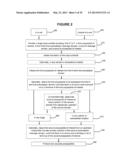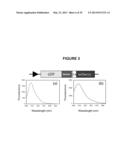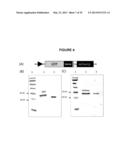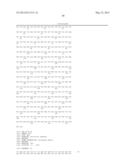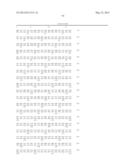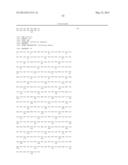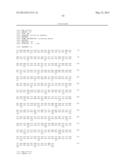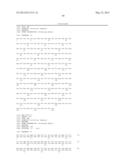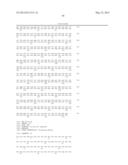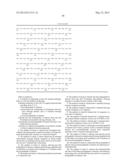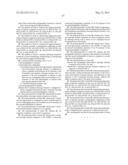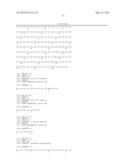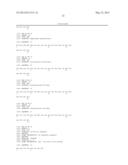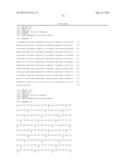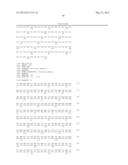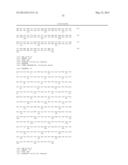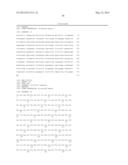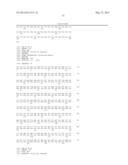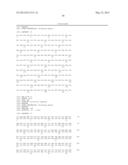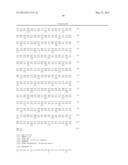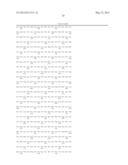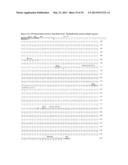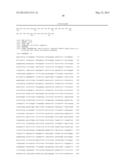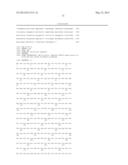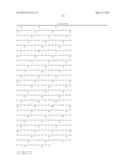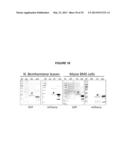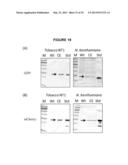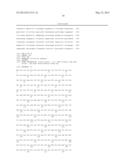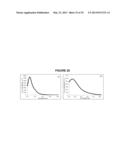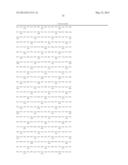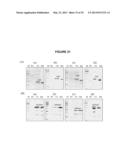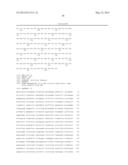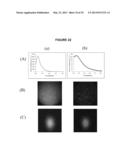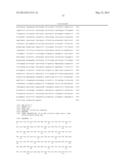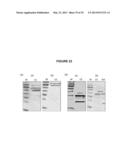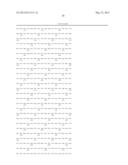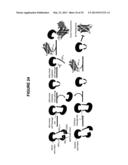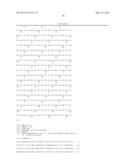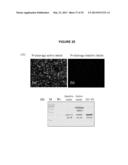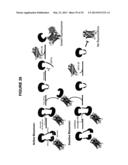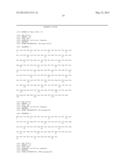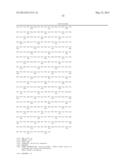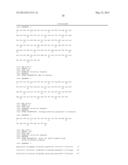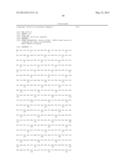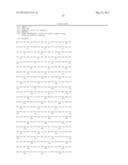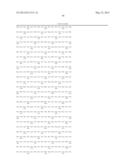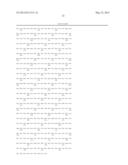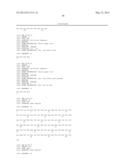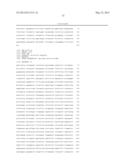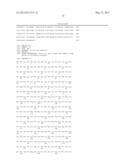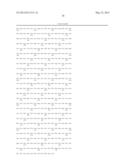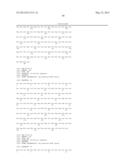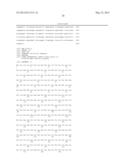Patent application title: AUTO-PROCESSING DOMAINS FOR POLYPEPTIDE EXPRESSION
Inventors:
University Of Hawaii (Honolulu, HI, US)
Wei Wen Su (Honolulu, HI, US)
Bei Zhang (Honolulu, HI, US)
Assignees:
University of Hawaii
IPC8 Class: AC12P2100FI
USPC Class:
530350
Class name: Chemistry: natural resins or derivatives; peptides or proteins; lignins or reaction products thereof proteins, i.e., more than 100 amino acid residues
Publication date: 2013-05-23
Patent application number: 20130131315
Abstract:
Embodiments herein include methods and constructs that can be used to
co-express two or more polypeptides of interest from a single
polynucleotide encoding a precursor polypeptide. Within this precursor
polypeptide can reside at least one autonomous processing unit, which can
mediate release of flanking polypeptides of interest in cis. The
processing unit can include an N-terminal autocatalytic cleavage domain
and a C-terminal cleavage domain. Some embodiments include constructs and
methods for co-expressing polypeptides without N- or C-terminal
overhangs, in any cellular or extracellular location, and/or in
stoichiometric ratios.Claims:
1. A method of expressing at least two separate polypeptides in a cell,
the method comprising: initiating translation in the cell of a single
polynucleotide encoding, from 5' to 3', a first polypeptide of interest;
a processing unit comprising an N-terminal autocatalytic cleavage domain,
and a C-terminal cleavage domain; and a second polypeptide of interest;
cleaving the first polypeptide of interest from the first N-terminal
autocatalytic cleavage domain; and cleaving the second polypeptide of
interest from the C-terminal cleavage domain, such that two separate
polypeptides are produced, neither of which comprises the processing
unit.
2. The method of claim 1, wherein the N-terminal autocatalytic cleavage domain comprises an intein, a B-type bacterial intein-like (BIL) domain, or a derivative thereof.
3. The method of claim 1, where wherein the N-terminal autocatalytic cleavage domain comprises an intein configured to have no splicing activity, and to cleave at an N-terminal, but not C-terminal end of the intein.
4. The method of claim 2, wherein cleaving the first polypeptide of interest comprises hydrolyzing a peptide bond so that there is no amino acid overhang on a C terminus of the first polypeptide of interest.
5. The method of claim 1, wherein the method is performed in a eukaryotic cell.
6. The method of claim 2, wherein the first polypeptide is cleaved from the first N-terminal autocatalytic cleavage domain in a cellular location outside of the Golgi.
7. The method of claim 1, wherein the C-terminal cleavage domain comprises an intein.
8. The method of claim 2, wherein the C-terminal cleavage domain comprises a 2A sequence.
9. The method of claim 8, wherein the 2A sequence is a non-viral 2A sequence.
10. The method of claim 8, wherein the C-terminal cleavage domain further comprises at least one of SUMO or UB.
11. The method of claim 1, wherein the C-terminal cleavage domain comprises at least one of SUMO or UB.
12. The method of claim 1, wherein the second polypeptide of interest and at least a portion of the C-terminal cleavage domain are co-translationally cleaved from sequences upstream of the C-terminal cleavage domain.
13. The method of claim 1, wherein cleaving the second polypeptide of interest comprises hydrolyzing a peptide bond so that there is no amino acid overhang on an N terminus of the second polypeptide of interest.
14. The method of claim 1, wherein the first polypeptide of interest and second polypeptide of interest are expressed stoichiometrically.
15. The method of claim 1, wherein the polynucleotide encodes at least three polypeptides of interest, and wherein a processing unit is positioned between each two consecutive polypeptides of interest, and each of the at least three polypeptide of interest is cleaved from a processing unit adjacent thereto.
16. The method of claim 1, wherein the single polynucleotide of interest comprises at least one of: SEQ ID NO: 39, SEQ ID NO: 41, SEQ ID NO: 43, SEQ ID NO: 45, SEQ ID NO: 47, SEQ ID NO: 49, or SEQ ID NO: 51.
17. The method of claim 1, wherein the single polynucleotide of interest comprises at least one of SEQ ID NO: 6, SEQ ID NO: 8, SEQ ID NO: 10, SEQ ID NO: 12, SEQ ID NO: 14, SEQ ID NO: 16, SEQ ID NO: 18; or SEQ ID NO: 20.
18. The method of claim 1, wherein the single polynucleotide of interest encodes a polypeptide comprising at least one of SEQ ID NO: 40, SEQ ID NO: 42, SEQ ID NO: 44, SEQ ID NO: 46, SEQ ID NO: 48, SEQ ID NO: 50, SEQ ID NO: 52, or SEQ ID NO: 54.
19. The method of claim 1, wherein initiating translation comprises at least transfecting, transforming, or transducing the cell with the single polynucleotide.
20. A polynucleotide encoding, from 5' to 3': a first polypeptide of interest; a processing unit comprising: a N-terminal autocatalytic cleavage domain, wherein the first autocatalytic cleavage domain is configured to cleave a peptide bond between an N terminus of the N-terminal autocatalytic cleavage domain and a C terminus of the first polypeptide of interest so that there are no overhanging amino acid residues on a C terminus of the first polypeptide of interest after cleaving the peptide bond; and a C-terminal cleavage domain; and a second polypeptide of interest, wherein the C-terminal cleavage domain is configured to cleave a peptide bond between the C-terminal cleavage domain and the second polypeptide of interest.
21. The polynucleotide of claim 20, wherein the N-terminal autocatalytic cleavage domain comprises an intein.
22. The polynucleotide of claim 20, wherein the C-terminal cleavage domain is configured to cleave such that there is are no overhanging amino acid residues on an N terminus of the second polypeptide of interest.
23. The polynucleotide of claim 20, wherein the C-terminal cleavage domain comprises a 2A sequence.
24. The polynucleotide of claim 22, wherein the 2A sequence comprises a non-viral 2A sequence.
25. The polynucleotide of claim 22, wherein the C-terminal cleavage domain comprises a UB, SUMO, or furin site positioned immediately upstream of an N terminus of the second polypeptide of interest.
26. The polynucleotide of claim 20, further comprising a linker of about 3-40 amino acids in length positioned between the N-terminal autocatalytic cleavage domain and the C-terminal cleavage domain.
27. The polynucleotide of claim 20, wherein the C-terminal cleavage domain comprises an intein configured to have no splicing activity, and to cleave at an C-terminal, but not N-terminal end of the intein.
28. The polynucleotide of claim 19, wherein the C-terminal cleavage domain comprises a UB, SUMO, or furin site positioned immediately upstream of an N terminus of the second polypeptide of interest.
29. The polynucleotide of claim 19, wherein the first polypeptide of interest comprises a first subunit of a multimer, and the second polypeptide of interest comprises a second subunit of the multimer.
30. The polynucleotide of claim 19, wherein the N-terminal autocatalytic cleavage domain comprises SEQ ID NO: 28, and wherein the C-terminal cleavage domain comprises a 2A sequence of SEQ ID NO: 5.
31. The polynucleotide of claim 19, wherein the polynucleotide encodes a linker positioned downstream of the N-terminal autocatalytic cleavage domain, and upstream of and adjacent to the C-terminal cleavage domain, wherein the linker comprises about 3-40 amino acid residues.
32. The polynucleotide of claim 19, wherein the polynucleotide of interest comprises at least one of: SEQ ID NO: 39, SEQ ID NO: 41, SEQ ID NO: 43, SEQ ID NO: 45, SEQ ID NO: 47, SEQ ID NO: 49, or SEQ ID NO: 51.
33. The polynucleotide of claim 19, wherein the polynucleotide of interest comprises at least one of SEQ ID NO: 6, SEQ ID NO: 8, SEQ ID NO: 10, SEQ ID NO: 12, SEQ ID NO: 14, SEQ ID NO: 16, SEQ ID NO: 18; or SEQ ID NO: 20.
34. The polynucleotide of claim 19, wherein the polynucleotide of interest encodes a polypeptide comprising at least one of SEQ ID NO: 40, SEQ ID NO: 42, SEQ ID NO: 44, SEQ ID NO: 46, SEQ ID NO: 48, SEQ ID NO: 50, SEQ ID NO: 52, or SEQ ID NO: 54.
35. The polynucleotide of claim 19, wherein the polynucleotide is integrated into a genome of a eukaryotic host cell.
36. A polypeptide encoded by the polynucleotide of claim 20.
Description:
CROSS-REFERENCE TO RELATED APPLICATIONS
[0001] The present application claims the benefit of priority under 35 U.S.C. §119(e) of U.S. Provisional Patent Application No. 61/563,508 entitled, "Coordinate expression of multiple proteins in eukaryotes" filed on Nov. 23, 2011, and U.S. Provisional Patent Application No. 61/564,808 entitled, "Auto-processing domains that enable coordinate multi-protein expression" filed on Nov. 29, 2011. The entirety of each of these applications is hereby incorporated by reference.
REFERENCE TO SEQUENCE LISTING, TABLE, OR COMPUTER PROGRAM LISTING
[0003] The present application is being filed along with a Sequence Listing in electronic format. The Sequence Listing is provided as a file entitled UOH46A-SEQUENCE.TXT, created Nov. 20, 2012, last modified Nov. 20, 2012 which is 135,861 bytes in size. The information in the electronic format of the Sequence Listing is incorporated herein by reference in its entirety.
FIELD
[0004] The field relates generally to constructs, systems, and methods for polypeptide expression.
SUMMARY
[0005] Some aspects include a method of expressing at least two separate polypeptides in a cell. In some embodiments, the method includes initiating translation of a single polynucleotide encoding, from 5' to 3': a first polypeptide of interest; a processing unit that includes an N-terminal autocatalytic cleavage domain and a C-terminal cleavage domain; and a second polypeptide of interest. The method can include cleaving the first polypeptide of interest from the first N-terminal autocatalytic cleavage domain. The method can include cleaving the second polypeptide of interest from the C-terminal cleavage domain, such that two separate polypeptides are produced, neither of which includes the processing unit. In some embodiments, neither polypeptide contains the entire processing unit. In some embodiments, neither polypeptide contains a portion of the processing unit. In some embodiments, one polypeptide contains a portion of the processing unit, while the other polypeptide does not contain any of the processing unit. In some embodiments, the N-terminal autocatalytic cleavage domain includes an intein, a B-type bacterial intein-like (BIL) domain, or a derivative thereof. In some embodiments, the N-terminal autocatalytic cleavage domain includes an intein configured to have no splicing activity, and to cleave at an N-terminal, but not C-terminal end of the intein. In some embodiments, cleaving the first polypeptide of interest includes hydrolyzing a peptide bond so that there is no amino acid overhang on a C terminus of the first polypeptide of interest. In some embodiments, the method is performed in a eukaryotic cell. In some embodiments, the first polypeptide is cleaved in a cellular location outside of the Golgi. In some embodiments, the C-terminal cleavage domain includes an intein. In some embodiments, the C-terminal cleavage domain includes a 2A sequence. In some embodiments, the 2A sequence is a non-viral 2A sequence. In some embodiments, the C-terminal cleavage domain includes at least one of SUMO or UB. In some embodiments, the second polypeptide of interest and at least a portion of the C-terminal cleavage domain are co-translationally cleaved from sequences upstream of the C-terminal cleavage domain. In some embodiments, cleaving the second polypeptide of interest includes hydrolyzing a peptide bond so that there is no amino acid overhang on an N terminus of the second polypeptide of interest. In some embodiments, the first polypeptide of interest and second polypeptide of interest are expressed stoichiometrically. In some embodiments, the polynucleotide encodes at least three polypeptides of interest, and a processing unit is positioned between each two consecutive polypeptides of interest. The method can include cleaving each of the at least three polypeptide of interest from a processing unit adjacent thereto. In some embodiments, the polynucleotide includes at least one of: nucleotides 837-1617 of SEQ ID NO: 6; nucleotides 760-1364 of SEQ ID NO: 8; nucleotides 760-1254 of SEQ ID NO: 10; nucleotides 760-1336 of SEQ ID NO: 12; nucleotides 760-1762 of SEQ ID NO: 14; nucleotides 769-1728 of SEQ ID NO: 16; nucleotides 831-1516 of SEQ ID NO: 18; or nucleotides 760-1245 of SEQ ID NO: 20. In some embodiments, the polynucleotide includes at least one of SEQ ID NO: 6, SEQ ID NO: 8, SEQ ID NO: 10, SEQ ID NO: 12, SEQ ID NO: 14, SEQ ID NO: 16, SEQ ID NO: 18; or SEQ ID NO: 20. In some embodiments, the polynucleotide encodes a polypeptide comprising at least one of positions 253-476 of SEQ ID NO: 9; positions 253-484 of SEQ ID NO: 11; positions 253-445 of SEQ ID NO: 13; positions 253-445 of SEQ ID NO: 15; positions 248-572 of SEQ ID NO: 17; positions 282-507 of SEQ ID NO: 19; or positions 253-524 of SEQ ID NO: 21. In some embodiments, initiating translation comprises at least transfecting, transforming, or transducing the cell with the single polynucleotide.
[0006] Some aspects include a single polynucleotide encoding, from 5' to 3', a first polypeptide of interest, a processing unit, and a second polypeptide of interest. The processing unit can include an N-terminal autocatalytic cleavage domain. The processing unit can include a C-terminal cleavage domain. In some embodiments, the N-terminal autocatalytic cleavage domain is configured to cleave a peptide bond between the N terminus of the N-terminal autocatalytic cleavage domain and the C terminus of the first polypeptide of interest so that there is no overhang on a C terminus of the first polypeptide of interest. In some embodiments, the C-terminal cleavage domain is configured to cleave a peptide bond between the C-terminal cleavage domain and the second polypeptide of interest. In some embodiments, the C-terminal cleavage domain is configured to cleave such that there are no overhanging amino acid residues on an N terminus of the second polypeptide of interest after cleaving the peptide bond.
[0007] In some embodiments, the C-terminal cleavage domain comprises a 2A sequence. In some embodiments, the 2A sequence includes at least one of a viral 2A sequence or a sea urchin 2A sequence. In some embodiments, the polynucleotide also encodes a linker of about 3-40 amino acids in length, and positioned between the N-terminal autocatalytic cleavage domain and the 2A sequence. In some embodiments, the C-terminal cleavage domain includes UB, SUMO, or a furin site positioned immediately upstream of an N terminus of the second polypeptide of interest. In some embodiments, the C-terminal cleavage domain includes an intein. In some embodiments, the C-terminal cleavage domain includes a UB, SUMO, or furin site positioned immediately upstream of an N terminus of the second polypeptide of interest. In some embodiments, the first polypeptide of interest includes a first subunit of a multimer, and the second polypeptide of interest includes a second subunit of the multimer. In some embodiments, the N-terminal autocatalytic cleavage domain includes an intein configured to have no splicing activity, and to cut at only the N terminal of the intein. In some embodiments, the N-terminal autocatalytic cleavage domain comprises SEQ ID NO: 28. In some embodiments, the C-terminal cleavage domain comprises a 2A sequence of SEQ ID NO: 5. In some embodiments, the C-terminal cleavage domain comprises an intein configured to have no splicing activity, and to cut at only the C terminal of the intein (and thus not at the N-terminal). In some embodiments, the C-terminal cleavage domain comprises SEQ ID NO: 29. In some embodiments, the polynucleotide also encodes a linker positioned downstream of the N-terminal autocatalytic cleavage domain, and upstream of the C-terminal cleavage domain, wherein the linker includes about 3-40 amino acid residues. In some embodiments, the polynucleotide includes at least one of: SEQ ID NO: 39, SEQ ID NO: 41, SEQ ID NO: 43, SEQ ID NO: 45, SEQ ID NO: 47, SEQ ID NO: 49, SEQ ID NO: 51, or SEQ ID NO: 53. In some embodiments, the polynucleotide encodes a polypeptide comprising at least one of SEQ ID NO: 40, SEQ ID NO: 42, SEQ ID NO: 44, SEQ ID NO: 46, SEQ ID NO: 48, SEQ ID NO: 50, SEQ ID NO: 52, or SEQ ID NO: 54. In some embodiments, the polynucleotide is integrated into a genome of a host cell, and wherein the host cell includes a eukaryotic cell. Some embodiments include a polypeptide encoded by the polynucleotide.
[0008] Some embodiments include a polynucleotide vector that comprises, from 5' to 3', a first multiple cloning site, a polynucleotide encoding a processing unit, and a second multiple cloning site. The processing unit can comprise an N-terminal autocatalytic cleavage domain. The processing unit can include a C-terminal cleavage domain. In some embodiments, the polynucleotide encoding the processing unit comprises one of SEQ ID NO: 39, SEQ ID NO: 41, SEQ ID NO: 43, SEQ ID NO: 45, SEQ ID NO: 47, SEQ ID NO: 49, SEQ ID NO: 51, or SEQ ID NO: 53. In some embodiments, the processing unit comprises one of SEQ ID NO: 40, SEQ ID NO: 42, SEQ ID NO: 44, SEQ ID NO: 46, SEQ ID NO: 48, SEQ ID NO: 50, SEQ ID NO: 52, or SEQ ID NO: 54. In some embodiments, the polynucleotide vector further comprises a second processing unit, wherein the second processing unit is 3' and adjacent to the second multiple cloning site, and 5' and adjacent to a third multiple cloning site. In some embodiments, the polynucleotide vector further comprises a third processing unit, wherein the third processing unit is 3' and adjacent to the third multiple cloning site, and 5' and adjacent to a fourth multiple cloning site. In some embodiments, the polynucleotide vector further comprises a polynucleotide encoding a signal sequence. In some embodiments, the polynucleotide vector does not encode a peptide of interest.
BRIEF DESCRIPTION OF THE DRAWINGS
[0009] FIG. 1A schematically illustrates some embodiments in which a polynucleotide encodes an upstream polypeptide (I), an intein, a linker, a 2A sequence, and a downstream polypeptide (II).
[0010] FIG. 1B schematically illustrates some embodiments in which a polynucleotide encodes an upstream polypeptide (I), an intein, a linker, a second intein, and a downstream polypeptide (II).
[0011] FIG. 1C schematically illustrates some embodiments in which a polynucleotide encodes an upstream polypeptide (I), an intein, a linker, a 2A sequence, one of UB or SUMO (U), and a downstream polypeptide (II).
[0012] FIG. 1D schematically illustrates some embodiments in which a polynucleotide encodes one or more signal peptides for targeting one, or each polypeptide of interest to a cellular compartment.
[0013] FIG. 2 is a flow diagram illustrating methods of expressing at least two separate polypeptides.
[0014] FIG. 3 illustrates expression of an upstream GFP reporter and a downstream mCherry reporter in a GFP-intein-linker-2A-mCherry construct (with reference to the construct shown in FIG. 6A), illustrating relative fluorescence of the upstream (a) and downstream (b) reporter.
[0015] FIG. 4 illustrates expression of an upstream GFP reporter and a downstream mCherry reporter in a GFP-intein-linker-2A-mCherry construct (with reference to the construct shown in FIG. 6A), illustrating western blots of the upstream (B)-(C) and downstream (D)-(E) reporter.
[0016] FIG. 5A illustrates expression of a three-reporter GFP-mkO1-mCherry construct, illustrating fluorescence activity of the first reporter (GFP), second reporter (mKO1), and third reporter (mCherry).
[0017] FIG. 5B illustrates western blots of expression of a three-reporter GFP-mkO1-mCherry construct, illustrating bands of cleaved first reporter (GFP), second reporter (mKO1), and third reporter (mCherry).
[0018] FIG. 6A illustrates the Ssp DnaE Intein::FMDV 2A cassette sequence within the context of a cytosolic two-protein construct containing no signal peptide
[0019] FIG. 6B illustrates a polynucleotide encoding a Ssp DnaE Intein::FMDV 2A cassette sequence within the context of a cytosolic two-protein construct containing no signal peptide.
[0020] FIG. 7A illustrates the Ssp DnaE Intein::FMDV 2A cassette sequence within the context of a secretory two-protein construct containing two signal peptides
[0021] FIG. 7B illustrates a polynucleotide encoding the Ssp DnaE Intein::FMDV 2A cassette sequence within the context of a secretory two-protein construct containing two signal peptide.
[0022] FIG. 8A: illustrates the Ssp DnaE Intein::FMDV 2A cassette sequence within the context of a secretory two-protein construct containing one signal peptide
[0023] FIG. 8B: illustrates a polynucleotide encoding the Ssp DnaE Intein::FMDV 2A cassette sequence within the context of a secretory two-protein construct containing one signal peptide.
[0024] FIG. 9A illustrates the intein::Sea urchin 2A cassette sequence within the context of a cytosolic two-protein construct containing no signal peptide.
[0025] FIG. 9B illustrates a polynucleotide encoding intein::Sea urchin 2A cassette sequence within the context of a cytosolic two-protein construct containing no signal peptide.
[0026] FIG. 10A illustrates the Intein-Intein (Ssp DnaE intein-Ssp DnaB intein) cassette sequence within the context of a cytosolic two-protein construct containing no signal peptide.
[0027] FIG. 10B illustrates a polynucleotide encoding the Intein-Intein (Ssp DnaE intein-Ssp DnaB intein) cassette sequence within the context of a cytosolic two-protein construct containing no signal peptide.
[0028] FIG. 11A: illustrates the Intein-Intein (Ssp DnaE intein-Ssp DnaB intein) (inactive DnaE) cassette sequence within the context of a cytosolic two-protein construct containing no signal peptide.
[0029] FIG. 11B: illustrates a polynucleotide encoding the Intein-Intein (Ssp DnaE intein-Ssp DnaB intein) (inactive DnaE) cassette sequence within the context of a cytosolic two-protein construct containing no signal peptide.
[0030] FIG. 12A illustrates the Intein-UB cassette sequence within the context of a cytosolic two-protein construct containing no signal peptide
[0031] FIG. 12B illustrates a polynucleotide encoding the Intein-UB cassette sequence within the context of a cytosolic two-protein construct containing no signal peptide
[0032] FIG. 13A illustrates the intein-SUMO cassette sequence within the context of a cytosolic two-protein construct containing no signal peptide.
[0033] FIG. 13B illustrates a polynucleotide encoding the intein-SUMO cassette sequence within the context of a cytosolic two-protein construct containing no signal peptide.
[0034] FIG. 14A illustrates the Intein::sea urchin 2A-UBQ cassette within the context of a cytosolic two-protein construct containing no signal peptide.
[0035] FIG. 14B illustrates a polynucleotide encoding the Intein::sea urchin 2A-UBQ cassette within the context of a cytosolic two-protein construct containing no signal peptide.
[0036] FIG. 15 illustrates processing of GFP-Intein::F2A-mCherry-steptag polyprotein in maize HiII hybrid endosperm and maize BMS (Black Mexican Sweet) suspension cells analyzed by western blot probed with (a) anti-GFP antibody; and (b) anti-streptag antibody. "→" and "*" denote target protein band and nonspecific immunoreactive band, respectively.
[0037] FIG. 16 illustrates western blot probed with anti-GFP (a), anti-streptag (b) & (d), and anti-Histag (c) antibodies.
[0038] FIG. 17 illustrates western blots illustrating the different cellular targeting of protein constituents processed from intein:F2A polyprotein (Refer to construct in FIG. 8 and SEQ ID NOs: 18 and 19) in stably transformed NT1 cells. The concentrated media of suspension culture and intracellular cell extract were detected with anti-GFP antibody (a) and anti-streptag antibody (b)
[0039] FIG. 18 illustrates western blots probing extracts of N. benthamiana leaves and maize BMS cells for GFP and mCherry, indicating efficient processing of polyprotein precursor mediated by the intein::S2A domain.
[0040] FIG. 19 illustrates western blots illustrating the processing of intein::UBQ polyprotein in stably transformed tobacco NT1 cells and N. benthamiana leaf using (A) anti-GFP and (B) anti-streptag antibodies.
[0041] FIG. 20 illustrates fluorescent activity of processed GFP (A) and mCherry (B) from NT1 cells transformed with an intein::UBQ polyprotein construct.
[0042] FIG. 21 illustrates Western blots illustrating the processing of intein::intein polyprotein in stably transformed NT1 cells (a), N. benthamiana leaf (b), mammalian HEK293 cells (c), and Escherichia coli (d), using anti-GFP (A), and anti-streptag (B) antibodies.
[0043] FIG. 22 illustrates fluorescence activity of GFP (a) and mCherry (b) released from intein::intein polyprotein precursor. (A): fluorescence spectra of NT1 extract; (B) & (C): fluorescence microscope images of transfected HEK293 cells and E. coli colony, respectively.
[0044] FIG. 23 illustrates Western blots illustrating the processing of inactive N-terminal cleaving intein in Intein::F2A (a) and Intein:Intein (b) polyprotein, using anti-GFP (A), and anti-streptag (B) antibodies.
[0045] FIG. 24 illustrates the split-GFP in-vivo screening assay for selecting mini-intein derivatives with high terminal cleavage activities.
[0046] FIG. 25 illustrates (A) Validation of the split-GFP based in-vivo intein-activity assay: active intein gives fluorescence in E. coli (a), while no fluorescence is seen with inactive intein mutant (b). (B) GFP western blot analysis of mini-intein autocleavage mediated split GFP reconstitution using non-heat-denatured protein extracts.
[0047] FIG. 26 illustrates incorporation of mCherry in the split-GFP based in-vivo screening sensor to normalize the sensor response.
DETAILED DESCRIPTION
[0048] It can be desirable to coordinate the expression of two or more polypeptides, for example two domains of a dimer of interest. Moreover, it can be desirable for expression to be carried out in a cell, in stoichiometric ratios, from a single Open Reading Frame (ORF), and/or so that polypeptides are expressed without overhanging N-terminal or C-terminal amino acid residues. Accordingly, some embodiments include expressing polynucleotides that encode at least two polypeptides of interest, and processing units for coordinating the cleavage of the polypeptides of interest from processing units, such that the cleavage can occur in vivo, in any cellular compartment (or in cell extracts or in an extracellular environment), from a single ORF, and/or in desired stoichiometric ratios. In some embodiments, a polynucleotide encodes a precursor polypeptide that includes a processing unit that includes at least two domains, and is positioned in-frame between an upstream polypeptide and a downstream polypeptide. Each of the two domains can mediate and/or facilitate a proteolytic event to cleave the upstream and downstream polypeptides from the moiety positioned in-between. In some embodiments, the processing unit includes an upstream N-terminal autocatalytic cleavage domain, and a downstream C-terminal cleavage domain. In some embodiments, the N-terminal autocatalytic cleavage domain includes an intein, a HINT domain, a hog domain, or a bacteria intein-like (BIL) domain. In some embodiments, the C-terminal cleavage domain includes at least one of an intein, a 2A sequence, UB, and/or SUMO. In come embodiments, when the polynucleotide is translated (either concurrently, or afterwards) the processing unit mediates and/or facilitate the cleavage of the polypeptides in a cell, without overhangs, in a variety of (or any) cellular compartment, and/or in desired stoichiometric ratios, while minimizing the size of the precursor polypeptide.
[0049] Unless expressly stated otherwise, each reference cited herein is hereby incorporated by reference in its entirety.
Polypeptide Expression
[0050] Multiple polypeptide expression, either in a cell, or in a cell-free system, can be useful for many applications, for example manufacturing of polypeptide products, such as enzymes, therapeutic biologics, for the generation of transgenic crops, for example crops with improved nutrient content, improved tolerance for adverse conditions, or for coordinated expression in living cells, for example making a transgenic organism with two or more transgenic traits, and/or for gene therapy. Some embodiments include methods and constructs for polypeptide expression. In some embodiments, a nucleic acid encoding a precursor polypeptide that includes, in cis, two or more polypeptides of interest is provided in an expression system. In some embodiments, the precursor polypeptide includes at least 2, for example 3, 4, 5, 6, 7, 8, 9, 10, 15, or 20 polypeptides of interest.
[0051] Polypeptide expression systems in living cells can be useful for many applications, for example large-scale and small-scale manufacturing of polypeptide products, for gene expression in transgenic organisms, for gene therapy in a patient, for the expression of markers, such as for research or diagnostic applications. Accordingly, some embodiments include expression of a nucleic acid encoding the precursor polypeptide in a living cell. In some embodiments, the cell is part of a multicellular organism.
[0052] Cell-free expression systems can be useful for small-scale and large scale manufacturing of polypeptide products, for assays such as disease models and in vitro diagnostics, and for research and screening applications. In some embodiments, two or more precursor polypeptides are expressed in a cell-free system. In some embodiments, a nucleic acid, for example a cDNA or an mRNA encoding a precursor polypeptide of interest is added to a cell-free expression system. The cell-free expression system can produce a polypeptide encoded by that nucleic acid. In some embodiments, a polypeptide is chemically synthesized, and added to a cell-free expression system. In some embodiments, expressed polypeptides are purified from a cell-free expression system.
[0053] As used herein, "upstream" means toward the N-terminus of an amino acid or toward the 5' end of a nucleotide sequence. As used herein, "downstream" means toward the C-terminus of an amino acid or toward the 3' end of a nucleotide sequence.
[0054] As used herein "cleave," "cleavage," and related terms refer to separating an upstream portion of a polypeptide from an adjacent downstream portion of a polypeptide. For example, cleavage can include hydrolysis of a peptide bond, thus separating sequences upstream and downstream of the peptide bond. For example, cleavage can include ribosome skipping, such as that performed by 2A and 2A-like sequences, so that an upstream portion of a nascent peptide is separated from a downstream portion of the nascent peptide encoded by the same transcript.
[0055] With reference to some embodiments herein, amino acids, or amino acid residues can be referred to by either a three-letter or a one-letter code. Twenty amino acids are typically encoded by the genetic code, and can be referred to using the following codes or abbreviations herein: Arginine ("Arg" or "R"), Histidine ("His" or "H"), Lysine ("Lys" or "K"), Aspartic Acid ("Asp" or "D"), Glutamic Acid ("Glu" or "E"), Serine ("Ser" or "S"), Threonine ("Thr" or "T"), Asparagine ("Asp" or "N"), Glutamine ("Gln" or "Q"), Cysteine ("Cys" or "C"), Glycine ("Gly" or "G"), Proline ("Pro" or "P"), Alanine ("Ala" or "A"), Valine ("Val" or "V"), Isoleucine ("Ile" or "I"), Leucine ("Leu" or "L"), Methionine ("Met" or "M"), Phenylalanine ("Phe" or "F"), Tyrosine ("Tyr" or "Y"), Tryptophan ("Trp" or "W").
[0056] With reference to some embodiments and description herein, the bases of nucleic acids, such as DNA, RNA, and the like can be referred to by either the name of the base or a one letter code. One skilled in the art will appreciate that the genetic code is degenerate, in that for some amino acid residues, two or more three-base codons can encode the same amino acid. Thus, for some of the polypeptides disclosed herein, two or more polynucleotides can encode these polypeptides. Thus, some one letter codes, and described herein, can represent one of two or more bases, for example to describe two or more possible nucleic acids that can encode a single amino acid. One-letter codes used herein include: "A" (adenine), "G" (guanine), "C" (cytosine), "T" (thymine), "R" (one of adenine or guanine), "Y" (one of cytosine or thymine), "M" (one of adenine or cytosine), "K" (one of guanine or thymine), "S" (one of cytosine or guanine), "W" (one of adenine or thymine), "H" (one of adenine, cytosine, or thymine), "B" (one of cytosine, guanine, or thymine), "V" (one of adenine, cytosine, or guanine), "D" (one of adenine, guanine, or thymine), and "N" (one of adenine, guanine, cytosine, or thymine).
[0057] Variants of a nucleic acid and polypeptide sequences disclosed herein can be generated using techniques known in the art, for example by random mutagenesis, site-directed mutagenesis, or chemical synthesis of a desired variant. In some embodiments, variants of the listed sequences are provided, in which each variant has a sequence that differs from a reference sequence by at least one nucleotide or amino acid residue. It is contemplated herein that a variant comprises a sequence having at least about 70% identity (nt-nt or aa-aa) to a reference sequence, for example at least about 70%, 71%, 72%, 73%, 74%, 75%, 76%, 77%, 78%, 79%, 80%, 81%, 82%, 83%, 84%, 85%, 86%, 87%, 88%, 89%, 90%, 91%, 92%, 93%, 94%, 95%, 96%, 97%, 98%, 99%, 99.3%, 99.5%, 99.7%, 99.8%, 99.9%, or 99.99%, including ranges between any two of the listed values. Moreover, many variants can have substantially similar, or even superior functionality to a reference sequence. Accordingly, some embodiments include variants of the polynucleotide and polypeptide sequences disclosed herein.
[0058] "Modified" as used herein, includes a mutation in a polynucleotide or polypeptide sequence that differs from wild-type. Modifications can include point mutations, insertions, deletions, indels, and the like. Modifications can include in-frame, and out-of frame modifications to nucleic acids. Modified molecules, can, but do not necessarily, include at least one functionality in addition to the wild-type sequence, and/or lack at least one functionality possessed by the wild-type sequence.
Host Cell Systems
[0059] A variety of host cell systems can be used to co-express two or more polypeptides encoded by a single polynucleotide, for example microorganisms such as bacteria (e.g., E. coli or B. subtilis) transformed with expression vectors such as recombinant bacteriophage DNA, plasmid DNA or cosmid DNA expression vectors containing nucleotide sequences encoding the precursor polypeptide; yeast (e.g., Saccharomyces, Pichia) transformed with recombinant yeast expression vectors containing nucleotide sequences encoding the precursor polypeptide; insect cell systems infected with recombinant virus expression vectors (e.g., baculovirus) containing nucleic acids encoding the precursor polypeptide; plant cell systems infected with recombinant virus expression vectors (e.g., cauliflower mosaic virus, CaMV; tobacco mosaic virus, TMV) or transformed with recombinant plasmid expression vectors (e.g., Ti plasmid) containing nucleotide sequences encoding the precursor polypeptide; or mammalian cell systems (e.g., COS, CHO, BHK, 293, 3T3) harboring recombinant expression constructs containing nucleotide sequences encoding the precursor polypeptide.
[0060] In some embodiments, the host cell system includes a eukaryotic cell. Eukaryotic cells can include single cell organisms, single cells of a multi-cell organism in cell culture, and whole organisms, for example a transgenic organism. In some embodiments, the eukaryotic cell is one of a yeast cell, an algae cell, a plant cell, for example a monocot cell or dicot cell, an insect cell, or a mammalian cell. Accordingly, in some embodiments, the host cell includes a cell in cell culture. Methods of cell culture are well known to those skilled in the art. In some embodiments, the host cell is part of a multicellular organism.
[0061] The co-expression of two or more polypeptides can be useful for many agricultural applications. Accordingly, in some embodiments, a polynucleotide encoding a precursor polypeptide is expressed in a plant cell. Methodology for transferring foreign genetic material plant cells are well known to one of skill in the art. For example, a method of transforming to tobacco plant cells, in which the transferred genes are incorporated into the tobacco plant cell genome via Agrobacterium tumefaciens, is described, for example, in Fisher et al. (1995) Plant Molecular Biology Reporter 13:279. In some embodiments, the transgenic plant expressing the precursor polypeptide is a mosaic. In some embodiments, the transgenic plant expression the precursor polypeptide is a derived from a single progenitor cell, or a plurality of progenitor cells, each of which contain a polynucleotide encoding the precursor polypeptide. Plants can be classified according to the number of cotyledons in the embryo, and traditionally have been classified as "monocots" (one cotyledon) or "dicots" (two cotyledon). Monocots and dicots each include many agriculturally important species. For example, monocots include grains such as maize, wheat, and rice, other food crops such as sugar cane, bamboos, bananas, and onions, and many flowering plants such as tulips, orchids, and daffodils. For example, dicots include tobacco, soybeans, tomatoes, and grapes. Some embodiments include expression of a polypeptide precursor in a monocot. Some embodiments include expression of a polypeptide precursor in a dicot.
[0062] The expression of polynucleotides encoding two or more polypeptides can be useful for many therapeutic and diagnostic applications. Therapeutic and diagnostic polypeptide products can be manufactured in mammalian cells, for example to facilitate folding and post-translational modification of these polypeptides. Accordingly, in some embodiments, a polynucleotide encoding two or more polypeptides is expressed in a mammalian cell, for example a COS, CHO, BHK, 293, or 3T3 cell. In some embodiments, a polynucleotide encoding the polypeptide precursor is transduced into a mammalian cell, for example via an adenoviral or lentiviral vector. In some embodiments, the mammalian cell is transfected with a plasmid containing a polynucleotide encoding the polypeptide. In some embodiments, a polynucleotide encoding the precursor polypeptide is stably integrated into the genome of a mammalian cell. In some embodiments, the mammalian cell with the stably integrated genomic polynucleotide is a germline cell, and is used to make a transgenic animal containing in its genome a stably integrated polynucleotide encoding the precursor polypeptide. The mammalian expression constructs can additionally contain promoters as described herein and known in the art, for example promoters derived from the genome of mammalian cells (e.g., metallothionein promoter) or from mammalian viruses (e.g., the adenovirus late promoter; the vaccinia virus 7.5K promoter).
[0063] In some embodiments, a nucleic acid encoding two or more polypeptides of interest is administered to a living organism, and a transcript encoding the polypeptides of interest in-frame to at least one processing unit is expressed in the living organism. In some embodiments, a precursor polypeptide is chemically synthesized, and administered to a living organism, for example a patient in need of a therapeutic. The precursor polypeptide can be synthesized by chemical synthesis methods (such as solid phase peptide synthesis) using techniques known in the art, such as those set forth by Merrifield et al., J. Am. Chem. Soc. 85:2149 (1964), Houghten et al., Proc. Natl. Acad. Sci. USA, 82:51:32 (1985), Stewart and Young (Solid phase peptide synthesis, Pierce Chem. Co., Rockford, Ill. (1984), and Creighton, 1983, Proteins: Structures and Molecular Principles, W. H. Freeman & Co., N.Y. hereby incorporated by reference in their entireties.
Expression Vectors:
[0064] Some embodiments include expression vectors. The expression vector can include a polynucleotide encoding two or more polypeptides as described herein. The expression vector can include a multiple cloning site. The multiple cloning site can include at least one restriction endonuclease cleavage site. The multiple cloning site can include a GATEWAY® entry site (see, e.g. U.S. Pat. No. 7,393,632, hereby incorporated by reference in its entirety). Some embodiments include expression vectors that include a polynucleotide encoding at least one processing unit as described herein, and at least one multiple cloning site, for example so that one or more polynucleotides encoding desired polypeptides of interest can be cloned into the vector. Some embodiments include vectors encoding a cassette that encodes at least one processing unit, flanked on each side by a multiple cloning site. In some embodiments, the multiple cloning site is upstream of the processing unit. In some embodiments, the multiple cloning site is downstream of the processing unit. In some embodiments, a first multiple cloning site is upstream of the processing unit, and a second multiple cloning site is downstream of the processing unit. In some embodiments, the processing unit is positioned in-frame to the multiple cloning site, so that polypeptides of interest can be clone in-frame to the signal peptide. In some embodiments, one or more nucleic acids encoding a polypeptide of interest can be inserted into the vector and expressed along with a processing unit without additional cloning, processing, and/or mutagenesis steps. Some embodiments include vectors encoding a cassette that encodes at least one processing unit, flanked on each side by a sequence encoding a reporter polypeptide. Some embodiments include a polynucleotide encoding a cassette, in which the polynucleotide comprises at least one of SEQ ID NO: 39, SEQ ID NO: 41, SEQ ID NO: 43, SEQ ID NO: 45, SEQ ID NO: 47, SEQ ID NO: 49, or SEQ ID NO: 51. Some embodiments include a vector including at least one of the listed polynucleotides. In some embodiments, the polynucleotide encodes a polypeptide cassette comprising at least one of positions SEQ ID NO: 40, SEQ ID NO: 42, SEQ ID NO: 44, SEQ ID NO: 46, SEQ ID NO: 48, SEQ ID NO: 50, SEQ ID NO: 52, or SEQ ID NO: 54.
[0065] A useful tool is an expression vector that can readily express two or more desired polypeptide sequences once polynucleotides encoding these polypeptide sequences are cloned into the vector. Accordingly, some embodiments include a polynucleotide vector that comprises one or more polynucleotides encoding a processing unit as described herein, and each of which is positioned next to at least one multiple cloning sites. In some embodiments, each polynucleotide encoding a processing unit is positioned between a pair of multiple cloning sites. In some embodiments, the polynucleotide encoding the processing unit is positioned adjacent to the multiple cloning sites. In some embodiments, the polynucleotide comprises at least one of SEQ ID NO: 39, SEQ ID NO: 41, SEQ ID NO: 43, SEQ ID NO: 45, SEQ ID NO: 47, SEQ ID NO: 49, or SEQ ID NO: 51. In some embodiments, the processing unit comprises at least one of SEQ ID NO: 40, SEQ ID NO: 42, SEQ ID NO: 44, SEQ ID NO: 46, SEQ ID NO: 48, SEQ ID NO: 50, SEQ ID NO: 52, or SEQ ID NO: 54.
[0066] In some embodiments, the vector includes a promoter. In some embodiments, the vector includes a selectable marker, for example an antibiotic resistance or drug resistance gene, or a visually selectable marker such as β-galactosidase or GFP. In some embodiments the vector includes an origin of replication. In some embodiments, the vector includes one or more sequences homologous to a host genomic DNA sequence, for example for integration into the host genome. In some embodiments, the vector includes a sequence encoding a signal peptide, signal patch, or the like. In some embodiments, the signal peptide or signal patch is positioned in-frame to the polynucleotide encoding the upstream polypeptide of interest (see, e.g. FIG. 1D, (i)). In some embodiments, the signal peptide or signal patch is positioned in-frame to the polynucleotide encoding the downstream polypeptide of interest (see, e.g. FIG. 1D, (iii)). In some embodiments, one the signal peptide or patch is positioned in-frame to the polynucleotide encoding the upstream polypeptide of interest, and another signal peptide or patch is positioned in-frame to the polynucleotide encoding the downstream polypeptide of interest (see, e.g. FIG. 1D, (ii)). In some embodiments, the signal peptides or patches for the upstream and downstream polypeptides of interest target each of these polypetides of interest to the same cellular compartment (see, e.g. Example 1.5).
[0067] In some embodiments, the vector includes a plasmid. In some embodiments, the vector includes a viral vector, for example CaMV TMV, baculovirus, a retroviral, an adenoviral, or a lentiviral vector. In some embodiments, the vector includes bacteriophage, cosmid, an artificial chromosome (e.g. a BAC or YAC).
[0068] In some embodiments, the vector is in a host cell as described herein. In some embodiments, the vector is stably integrated into the genome of a host cell as described herein.
[0069] Some exemplary constructs are described in more detail below. Others will be apparent to those of skill in the art in view of the description herein.
Promoters:
[0070] A "promoter" is an array of nucleic acid control sequences that direct transcription of an associated polynucleotide, which may be a heterologous or native polynucleotide. A promoter includes nucleic acid sequences near the start site of transcription, such as a polymerase binding site. The promoter also optionally includes distal enhancer or repressor elements which can be located as much as several thousand base pairs from the start site of transcription. In some embodiments, an endogenous promoter in a host cell controls the expression of a polynucleotide integrated into the host cell genome. In some embodiments, a polynucleotide vector includes a promoter for expression of a precursor polypeptide encoded therein. Exemplary promoters include the cytomegalovirus hCMV immediate early gene promoter, the early or late promoters of SV40 adenovirus, the alkaline phosphatase promoter, the promoters of the yeast alpha-mating factor promoter, and the Cauliflower Mosaic Virus 35S promoter.
[0071] It can be desirable to transcribe a polynucleotide encoding two or more polypeptides in a tissue-specific manner. Accordingly, in some embodiments, a tissue-specific promoter is provided. The tissue-specific promoter used can depend on the host cell used, and the desired expression activity. Exemplary promoters include, but are not limited to leaf-specific and light-induced promoters such as those from the Lhcb gene (Castresana et al. (1988) J. European Molecular Biology Organization. 7:1929 1936), the RbcS gene (Perisic and Lam (1992) The Plant Cell 4:831 838.), the psbD gene (Christopher et al. (1992) The Plant Cell 4:785 798), sequences from the legA major seed storage gene shown to regulate temporal protein expression (Shirsat et al. (1989) Mol Gen Genet. 215(2):326), or an alternate promoter in the Arabidopsis thaliana HMG1 gene (Lumbreras et al. (1995) Plant J., 8(4):541).
[0072] Cis-regulatory elements can be used to further facilitate or fine-tune the expression of a polynucleotide. Cis-regulatory elements such as enhancers and insulators are well-known in the art, for example, for the octopine synthase enhancer element (Fromm, et al. (1989) Plant Cell 1(10):977). Additional cis-regulatory elements can be identified, for example by expression screening of a genomic library, and/or by computational analysis of a host genome. In some embodiments, tissue-specific and/or temporally specific enhancers are provided in cis to a polynucleotide encoding the precursor polypeptide in order to facilitate tissue-specific, and/or high-expression-level expression of the precursor polypeptide. In some embodiments. In some embodiments in which a polynucleotide encoding a precursor polypeptide are integrated in a host genome, insulator elements are provided in cis to a polynucleotide encoding the precursor polypeptide. The insulator elements can facilitate consistent expression levels of the precursor polypeptide independent of the site in the host genome the polynucleotide encoding the precursor polypeptide has integrated, for example in a heterochromatin environment.
Cleavage Domains
[0073] In general, "cleavage domains" can refer to polypeptide sequences that are cleaved either autocatalytically in cis, or by a catalytic molecule (for example an enzyme or ribozyme) in trans. Autocatalytic cleavage domains, as used herein refer to polypeptide sequences that are configured to cleave a polypeptide, in cis, at one or more positions either within, or upstream of the domain. Autocatalytic cleavage domains can include inteins, hog HINT domains, B-type BIL domains, 2A sequences, mutants and derivatives thereof and the like.
[0074] As used herein, "N-terminal autocatalytic cleavage domain" refers to autocatalytic domains that can cleave a moiety that includes an upstream (N-terminal) polypeptide sequence of interest, but does not include the processing unit. N-terminal autocatalytic cleavage domains can include, for example, inteins, mini-inteins, hog domains, BIL domains, and derivatives thereof as described herein.
[0075] As used herein, "C-terminal cleavage domain" refers to domains that facilitate the cleavage, either autocatalytically, by one or more enzymes in trans, or both autocatalytically and by one or more enzymes in trans, of a moiety that includes the downstream (C-terminal) polypeptide of interest, but does not include the entire processing unit. A C-terminal cleavage domain can include one or more of an intein, a 2A sequence, UB or SUMO, or a furin cleavage sequence.
Inteins
[0076] Inteins are found in nature, and can be involved in protein splicing processes that include a protein excising itself along with the concomitant ligation of the flanking protein sequences. The protein splicing elements is referred to as an "intein," while the flanking sequences are referred to as "exteins." Some embodiments include polynucleotides that encode one or more inteins.
[0077] Unless expressly stated otherwise, as used herein, "intein" refers to an auto-catalytic domain of the Hog/INTein (Hint) superfamily that splices itself out of a polypeptide by forming a peptide bond between two flanking polypeptides. Inteins include, but are not limited to DnaB helicase (dnaB) inteins, DNA polymerase III α subunit (dnaE) inteins, DNA polymerase III τ subunit (dnaX) inteins, RecA inteins, DNA gyrase subunit A inteins (gyrA), and DNA gyrase subunit B inteins (gyrB), including functional and mutants and modifications thereof, such as mini-inteins, n-terminal and/or c-terminal mustants, and the like. Additional information regarding inteins and their characteristics can be found on the world wide web at bioinfo.weizmann.ac.il/˜pietro/Hints/. Unless explicitly stated otherwise, as used herein "intein" includes naturally-occurring inteins, or functional mutants or variants thereof, including engineered and synthetic inteins.
[0078] While inteins are known to vary in length and sequence, a feature characteristic of many inteins is a Ser (S) or Cys (C) on the N terminus, and a C terminal motif of either His-Asn-Cys (HNC) or His-Asn-Ser (HNS), and some of these N and C terminal motifs have been shown to function in splicing and/or cleavage activity of the intein. In some embodiments, one or more amino acid residues near the N terminus or C terminus of the intein are mutated to reduce or eliminate splicing activity. In some embodiments, one or more amino acid residues near the N terminus or C terminus of the intein are modified such that N terminal cleavage, and/or C terminal cleavage is increased.
[0079] In some embodiments, the intein is the Ssp DnaE intein (SEQ ID NO: 1). In some embodiments, the intein is the Npu DnaE intein. Modifying the most C-terminal residue of an intein, for example the Asn 159 residue of the Ssp DnaE intein (SEQ ID NO: 1) eliminates splicing activity of the intein and C terminal cleavage, while preserving the intein's N-terminal cleavage activity (Amitai, et al. (2009) Proc. Nat. Acad. Sci. USA 106: 11005-10)(Martin, et al (2001) Biochemistry 40: 1393-402). Mutating the most N-terminal residue of an intein, for example the Cys1 residue of the Ssp DnaE intein, eliminates splicing activity and N terminal cleavage while preserving the intein's C terminal cleavage.
[0080] Accordingly, in some embodiments, for example when cleavage of a polypeptide in cis to the N terminus of the intein is desired, the intein contains a mutation that inhibits splicing by the intein, while permitting cleaving at the N terminus. In some embodiments, the mutation is of the most C-terminal amino acid residue of the intein. In some embodiments, the mutation is an Asn->Ala mutation, for example the N159A mutation in the Ssp DnaE intein, or a mutation that otherwise mutates the most C terminal residue of the intein so as to inhibit splicing and C terminal cleavage.
[0081] In some embodiments, for example when cleavage of a polypeptide in cis to the C terminus of the intein is desired, the intein contains a mutation that inhibits splicing by the intein, while permitting cleaving at the C terminus of the intein. In some embodiments, the mutation is of the most N-terminal amino acid residue of the intein. In some embodiments, the mutation is an Cys->Ala mutation, for example the C1A mutation in the Ssp DnaE intein, or a mutation that otherwise mutates the most N terminal residue of the intein so as to inhibit splicing and N terminal cleavage.
[0082] For the Ssp DnaE intein, in both the linear and branched intermediates, the hydrolysis of the ester bond between the N-extein and the intein/C-extein can mediate the release of the N-extein. Furthermore, the amino acids Ser and His are known to function together as a catalytic dyad in the active sites of diverse enzymes, including, for example serine protease, lipase, and esterase, and that in some instances, a Ser-His dipeptide itself can cleave ester compounds, for example p-nitrophenyl acetate (Li et al. (2000), Bioorg Med Chem 8: 2675-80). In the Ssp DnaE mini-intein, the C-terminal Asn159 residue is near the His 147 residue, which has been shown to activate the side chain N.sup.δ atom of Asn159 and facilitate the splicing reaction. Thus, it is contemplated herein that an N159S mutation can interact with the His147 residue to form a catalytic dyad, and that the proximity of both residue to the ester bond linking the N-extein to the native intein/C-extein junction may further accelerate the cleavage of the ester bond to release the N extein. Thus, some embodiments include an N159S mutation in the DnaE mini-intein. Some embodiments include a mutation at the C terminal of an intein, to introduce a His, Ser, or His and Ser near the position of the ester bond linking the N extein to the intein/C-extein junction during native splicing and excision of the intein. Without being limited to any theory, such mutations can increase the efficiency of N extein cleavage.
[0083] Modifying certain extein residues can also affect the splicing and/or cleavage activity of an intein. For example, mutation of the N-extein N-2 and N-1 (i.e. the two most C-terminal residues of the N-extein), and the C-extein C+1 residue (i.e. the most N terminal residue of the C-extein) has been shown to accelerate N-extein cleavage, while attenuating protein splicing for the Ssp DnaE mini-intein (Amitai et al (2000) Proc. Nat. Acad. Sci. USA 106: 11005-10)(Martin, et al (2001) Biochemistry 40: 1393-402). Exemplary modifications shown to increase N-extein cleavage, while attenuating protein splicing include: modifications of the N-2 and N-1 extein residue to one of: n-ND or n-RD; modifications of the C-extein C+2 and C+3 residues to one of c-SC, c-LC, c-SR, and c-RA; and modifications of the N-extein N-1, N-2, and C-extein C+2 and C+3 residues to one of nc-GG/TP, nc=EN/LC, nc-JD/LA, nc-GN/LS, and nc-ED/FN. Some embodiments include one of the listed N-extein N-2 and N-1 residue modifications (e.g. n-ND or n-RD). Some embodiments include one of the listed C-extein C+2 and C+3 residue mutations (e.g. c-SC, c-LC, c-SR, and c-RA). Some embodiments include one of the listed N-extein N-2 and N-1 residue modifications and one of the listed C-extein C+2 and C+3 residue modifications (e.g. one of n-ND or n-RD, and one of c-SC, c-LC, c-SR, and c-RA). Some embodiments include one of the listed N-extein N-1, N-2, and C-extein C+2 and C+3 pairs (e.g. one of nc-GG/TP, nc=EN/LC, nc-JD/LA, nc-GN/LS, or nc-ED/FN).
[0084] It can be desirable to minimize the size of an intein. Without being bound by any one theory, as discussed herein, previous efforts to include an NIa protease target domain (which can be 27-48 kD in size) between two polypeptides of interest can be complicated by unfavorable folding, which can lead to low polypeptide yield, or improper polypeptide function. Additionally, the Pol I intein is very large (460 amino acids, over 50 kD), and the self-cleavage occurs entirely post protein translation. Accordingly, some embodiments include an intein of minimal size, such as a mini-intein. It has been shown, for example that up to 45 amino acids residues (amino acids 79-123) can be removed from the C-terminus of the Ssp DnaE Int-n intein fragment, and yet this fragment is still function in the protein trans-splicing process in both dicot and monocot plants (Yang et al (2006) Transgenic Res. 15: 583-93). Accordingly, some embodiments include an Ssp DnaE "mini-intein," for example, in which amino acids 79-123 have been removed from the wild-type intein. Some embodiments include a "mini-intein," that retains protein cleavage function of the intein it is derived from, and contains at least about 5% fewer amino acid residues than the intein it is derived from, for example at least about 5%, 10%, 15%, 20%, 25%, 30%, 40%, 45%, 50%, 55%, 60%, 65%, 70%, 75%, or 80% fewer amino acid residues. In some embodiments, a mini-intein includes a minimal HINT domain. Some embodiments include two or more mini-inteins. In some embodiments, a mini-intein is further modified, for example at the C terminus or N terminus as taught herein.
[0085] In addition to inteins, other HINT-domain superfamily member can perform autocatalytic cleavage, for example hog HINT domains, bacterial intein-like domains (BIL), 2A sequences, mutants and derivatives thereof and the like. Hog domains are found in hedgehog proteins, and can catalyze cleavage of an upstream (N-terminal) domain by attaching a cholesterol molecule to this domain (Mann, R. K., Beachy, P. A. (2004) Annu Rev Biochem 73, 891-923). B-type BIL domains can cleave at either their N' or C' termini, while A-type BIL domains can cleave at either their N' or C' termini and perform protein splicing (Dassa, B., Haviv, H., Amitai, G., Pietrokovski, S. (2004). J Biol Chem published online ahead of print as doi:10.1074/jbc.M404562200; Dassa et al (2004). TRENDS in Genetics 20: 538-542, hereby incorporated by reference in its entirety). Accordingly some embodiments include at least one of a HINT domain, a hog domain, a B-type BIL domain, or an A-type BIL domain. In some embodiments, the A-type BIL domain includes a mutation to eliminate or reduce its splicing activity.
C-Terminal Cleavage Domains
[0086] Other cleavable and/or cleavage-mediating domains can be provided alone, in combination, or in combination with an N-terminal autocatalytic cleavage domain in cis, to obtain or enhance desired cleavage activity of a precursor polypeptide. In some embodiments, a polynucleotide includes at least one of these additional cleavable and/or cleavage mediating domains.
[0087] Ubiquitin (UB) is a small, highly stable and conserved protein in eukaryotes. UB can function in selective protein degradation. The UB monomer is a small protein and exists in nature as a protein fusion, either as a poly-UB or as an UB attached to the N-terminus of an unrelated protein. Expression of target proteins as UB fusion (typically UB is at the N terminal) has been shown to improve target protein accumulation in bacteria, yeast, plant, and mammalian hosts. In eukaryotic hosts, UB fusion proteins are efficiently cleaved in a cell at the C-terminus of UB to create downstream protein with its native N-terminus. The cleavage is achieved via deubiquitinating enzymes (DUBs; sometimes refer to as UB-specific proteases or UB C-terminal hydrolases). Although a UB-based vector has been reported for co-expression of multiple proteins in plants (Walker, J. M., and R. D. Vierstra (2007). Plant Biotechnol J 5:413-21.), such approach leaves behind six or more amino acid overhang at the C-terminus of the polypeptide fused upstream of the UB moiety, and may cause undesirable effects.
[0088] The Small UB-like MOdifier (SUMO) is similar to UB in many respects but not involved in selective protein degradation. Instead, SUMO is involved in the SUMOylation process in which it covalently modifies a large number of cellular proteins as a part of an elaborate regulatory mechanism for biological function and localization. Like UB, SUMO fusion has also been found useful in improving foreign protein accumulation in a variety of hosts. In plant and mammalian cells, the SUMO moiety is efficiently separated in vivo from its fusion partner by the SUMO-specific proteases (SENPs) and produces downstream protein with its native N-terminus. In some embodiments, for example, embodiments in which a downstream polypeptide is desired with no N-terminal overhanging amino acids, a UB polypeptide sequence or SUMO polypeptide sequence is positioned immediately upstream of the N terminus of the downstream polypeptide. Some embodiments include UB (MQIFVKTLTGKTITLEVESSDTIDNVKAKIQDKEGIPPDQQRLIFAGRQLEDGRTLAD YNIQKESTLHLVLRLRGG) (SEQ ID NO: 2). Some embodiments include SUMO (GSMSDQEAKPSTEDLGDKKEGEYIKLKVIGQDSSEIHFKVKMTTHLKKLKESYCQR QGVPMNSLRFLFEGQRIADNHTPKELGMEEEDVIEVYQEQTGGHSTV) (SEQ ID NO: 3). Unless explicitly stated otherwise, "UB sequence" and "SUMO sequence" as used herein includes functional variants of these stated sequences. In some embodiments, a functional variant of UB or SUMO includes a polypeptide with at least about 70% identity to N. tabacum UB or N. tabacum SUMO, for example at least about 70%, 75%, 80%, 81%, 82%, 83%, 84%, 85%, 86%, 87%, 88%, 89%, 90%, 91%, 92%, 93%, 94%, 95%, 96%, 97%, 98%, or 99% identity.
[0089] Furin is a protease found in the trans-golgi apparatus. Furin recognizes, and cleaves polypeptides immediately downstream (i.e. immediately following the C terminus of) of the consensus sequence Arg-X-X-Arg (SEQ ID NO: 22), in which X is any amino acid residue. However, Furin prefers the sequence Arg-X-(Lys/Arg)-Arg (SEQ ID NO: 23). Furin can thus cleave an upstream moiety (having a furin cleavage sequence) from the N terminus of a downstream peptide without leaving any overhang, provided the downstream peptide is targeted to the secretory pathway. Thus, some embodiments include a furin cleavage sequence. The furin cleavage sequence can be positioned immediately upstream of the N terminus of a downstream polypeptide.
[0090] "CHYSEL" (cis-acting hydrolase element) peptides such as the foot and mouth disease virus (FMDV) 2A sequence (GSGSRVTELLYRMKRAETYCPRPLLAIHPTEARHKQKIVAPVKQLLNFDLLKLAGDV ESNPGP) (SEQ ID NO: 4), a picornavirus 2A-like sequence, and non-viral 2A-like sequence have polypeptide cleavage activity. As used herein "F2A" can also be used to refer to a FMDV 2A sequence. Some embodiments include a polynucleotide encoding one or more of the following CHYSEL peptides. A polypeptide of approximately 20 amino acids of the FMDV 2A region mediates cleavage of its own C terminus and releases itself from the adjoining peptide. 2A domains and 2A-like domains can mediate a ribosomal skipping mechanism that permits co-translational cleavage of a peptide containing the 2A or 2A-like domain from upstream sequences. Accordingly, in some embodiments precursor polypeptides that include a 2A sequence are cleaved co-translationally before the entire polypeptide is expressed. This option is acknowledged herein, but for simplicity, in some portions of this disclosure, 2A polypeptide sequences, or precursor polypeptides that contain 2A may be depicted, with the understanding that these polypeptides will be co-translationally cleaved into two or more polypeptides. Additionally, no sequences outside of the 2A region are believed to be required for 2A-mediated cleavage. However, 2A-mediated cleavage leaves the 2A peptide on the C terminus of the upstream peptide (N terminal moiety), and a single proline on the N terminus of the downstream (C terminal moiety). Previously, it has been reported that the 2A overhang may not interfere with protein accumulation in the cytosol, but that when the 2A-overhang-containing polypeptide is intended for the secretory pathway (e.g. when the polypeptide includes an ER-targeting signal), the 2A overhand causes mistargeting of the processed protein to the lytic vacuoles for degradation (El Amrani, et al. (2004) Plant Physiol. 135:16-24; Francois, et al. (2004) Plant Science 166:113-121; Samlova, et al. (2006), Traffic 7:1701-23). Some embodiments include a 2A sequence. In some embodiments, the 2A sequence is viral. In some embodiments, the 2A sequence is a FMDV 2A sequence. In some embodiments, the 2A sequence is a picornavirus 2A-like sequence. In some embodiments, the 2A sequence is non-viral. In some embodiments, the 2A sequence is a sea urchin (Strongylocentrotus purpuratus) 2A sequence (DGFCILYLLLILLMRSGDVETNPGP) (SEQ ID NO: 5); Sponge (Amphimedon queenslandica) 2A sequence (SEQ ID NO: 33 or SEQ ID NO: 34); acorn worm (Saccoglossus kowalevskii) (SEQ ID NO: 35) 2A sequence; or amphioxus (Branchiostoma floridae) (SEQ ID NO: 36 or SEQ ID NO: 37) 2A sequence. In some embodiments, the 2A sequence is a naturally occurring or synthetic sequence that includes the 2A consensus sequence D-X-E-X-NPGP (SEQ ID NO: 38), in which X is any amino acid residue.
[0091] It can be desirable to mediate co-translational processing of a precursor polypeptide. For example, to facilitate proper protein folding, post-translational modification, and/or desired subcellular localization, it can be desirable to co-translationally cleave an N terminal polypeptide. Accordingly, in some embodiments, a 2A sequence is positioned between an upstream and downstream polypeptide of interest. It can further be desirable for the downstream peptide to not have any overhanging N terminal amino acids following cleavage by the 2A domain. Thus, in some embodiments, additional cleavage-mediating domains can be positioned dowsnstream of the 2A sequence, and immediately upstream of the N terminus of downstream polypeptide. In some embodiments, a UB or SUMO sequence is positioned in cis to the 2A and downstream polypeptide sequence of interest. The UB or SUMO sequence can be downstream of the 2A sequence and immediately upstream of the N terminus of the downstream polypeptide of interest. Thus, a DUB or SENP can cleave any overhanging amino acid residues (such as proline) from the N terminus. Since DUBS and SENPs can be found in substantially any cellular compartment, the overhanging amino acid residues can be cleaved from the N terminus of the downstream polypeptide in substantially any cellular compartment.
[0092] Additionally, protease sites that are known to one skilled in the art can be used in some embodiments. For example, the plant kex2p-like protease is a type I integral membrane endopeptidase that resides in the trans-Golgi network. Tobacco cells have been shown to have kex2p activity. In some embodiments, for example embodiments in which polypeptides of interest are destined for the secretory pathway, the polynucleotide encodes at least one kex2p target site positioned in-frame between a pair of polypeptides of interest. In some embodiments, at least two copies of the kex2p-target site are encoded in tandem, for example at least two, three, four, five, six, seven, eight, nine, or ten copies.
Linkers
[0093] Some embodiments include linkers between the N-terminal autocatalytic cleavage domain and C-terminal cleavage domain. Some embodiments include polynucleotides encoding linkers. Linkers can include peptide sequences that link an N-terminal autocatalytic cleavage domain or portion thereof to a C-terminal cleavage domain or portion thereof in a polypeptide.
[0094] It has been shown that ribosome skipping mediated by 2A is affected by the carboxyl terminal region of its upstream protein, including the length of the sequence immediately upstream of 2A (de Felipe et al. (2010) Biotechnol. J. 5: 213-23). Thus, it is contemplated herein that a peptide linker upstream of the 2A sequence can be engineered to give further improvements of activity. Accordingly, some embodiments include a polypeptide linker immediately upstream of 2A. Some embodiments include a native 2A linker such as the FMDV 2A linker. Some embodiments include a Gly/Ser-type flexible linker. Some embodiments include a rigid helical linker. Some embodiments include two or more of the above linkers. In some embodiments, the linker includes a multimer of sequences in tandem, for example a least 2, 3, 4, 5, 6, 7, 8, 9, 10, 15, or 20 copies of the sequence in tandem.
[0095] In some embodiments, the linker length is varied and selected to improve efficiency. In some embodiments, the linker is at least about 3 amino acid residues in length, for example at least about 3, 4, 5, 6, 7, 8, 9, 10, 11, 12, 13, 14, 15, 17, 20, 25, 30, 35, 40, 45, 50, 55, 60, 65, 70, 75, 80, 85, 90, 95, 100, 120, 150, or 200 amino acid residues in length. In some embodiments the linker has a length of about 3-5 amino acid residues, 3-7, 3-8, 3-10, 3-12, 3-15, 3-20, 3-25, 3-30, 3-35, 3-40, 3-45, 3-50, 3-60, 4-7, 4-8, 4-10, 4-12, 4-15, 4-20, 4-25, 4-30, 4-45, 4-50, 4-60, 5-8, 5-10, 5-12, 5-15, 5-20, 5-25, 5-30, 7-15, 7-20, 7-25, 7-30, 7-35, 7-40, 7-45, 7-50, 70-60, 10-20, 10-25, 10-30, 10-35, 10-40, 10-45, 10-50, 10-55, 10-60, 15-20, 15-25, 15-30, 15-35, 5-40, 15-45, 15-50, 15-60, 20-30, 20-35, 20-40, 20-45, 20-50, 20-60, 25-35, 25-40, 25-45, 25-50, 25-60, 25-70, 30-40, 30-50, 30-60, 40-50, 40-60, 40-70, 50-60, 50-70, 50-80, 60-70, 60-80, 60-90, 70-80, 80-90, 90-100, 70-100, 80-120, 90-120, 100-150, or 100-200 amino acid residues.
Constructs
[0096] A single intein can mediate cleavage of sequences on both the N terminal and C terminal of the intein, as well as the splicing of flanking protein sequences. However, single inteins mediate cleavage and splicing with low efficiency, may only cleave one of two flanking exteins, and/or can leave a large amount of uncleaved precursor polypeptide. Additionally, while cleavage at the N terminus of an intein is generally efficient, cleavage at the C terminus of a single-intein construct can be very inefficient. For example, it has been reported that the PolI intein from Pyrococcus horikoshii was inserted in frame with antibody heavy and light chains to achieve expression of these proteins encoded in a single polypeptide precursor in mammalian cells (Kunes et al. (2009), Biotechol Prog 25: 735-44). In the disclosure of Kunes et al., the C+1 extein Ser residue was mutated to a different residue, such as alanine, glycine, or methionine.
[0097] While some assembled antibody was detected in this study, no antibody was detected when the signal sequence was removed from the light chain of the antibody, which was the downstream peptide in the construct. Thus, it can be concluded that in this example, it was cleavage of the signal sequence of the light chain that cleaved the light chain from the intein moiety, rather than the intein itself. Without being bound by any one theory, mutations of the C+1 extein residue apparently attenuates both cleavage and splicing activity of intein, and it can further be concluded that C-terminal cleavage of the PolI intein was very inefficient. Accordingly, based on this disclosure, a PolI intein in combination with the C+1 extein residue would not provide a robust system for (a) cleavage of an intein moiety from the C terminal polypeptide of interest outside the Golgi apparatus, (b) cleavage of an intein moiety from the C terminal polypeptide of interest without C terminal overhang on the polypeptide of interest, or (c) robust, high-frequency cleavage of the C terminal polypeptide of interest from the intein. Consequently, single intein constructs can be inefficient for polypeptide synthesis or manufacturing applications. Moreover, without being bound by any one theory, dimerization of uncleaved precursor peptide with polypeptides that have been cleaved can impair the function of these peptides, resulting in a dominant negative-type effect.
[0098] Surprisingly, it has been found that a precursor polypeptide that includes, in cis, an upstream polypeptide, an N-terminal autocatalytic cleavage domain, a C-terminal cleavage domain, and a downstream polypeptide of interest can cleave the C terminus of the upstream polypeptide and N terminus of the downstream polypeptide with very high efficiency, while minimizing the size of the construct. As used herein, "processing unit," can refer to a polypeptide sequence that includes, from N terminus to C terminus, an N-terminal autocatalytic cleavage domain, and a C-terminal cleavage domain. In some embodiments, a linker is positioned between the N-terminal autocatalytic cleavage domain and the C-terminal cleavage domain. Accordingly, some embodiments include a polynucleotide encoding at least two polypeptides of interest, and a processing unit, positioned in-frame between each of the polypeptides of interest. Some embodiments include a vector that encodes a processing unit, but does not encode polypeptides of interest.
[0099] In some embodiments, a processing unit comprises a polynucleotide encoding an N-terminal autocatalytic cleavage domain that includes an intein. When the domain is expressed, this intein can cleave the upstream polypeptide without overhanging C terminal amino acids on the upstream polypeptide. Additionally, the intein of the N-terminal autocatalytic cleavage domain can cleave the upstream polypeptide in substantially any cellular compartment, for example the cytosol.
[0100] In some embodiments, a processing unit comprises a polynucleotide encoding a C-terminal cleavage domain that includes another intein. If the C-terminal cleavage domain is an intein, the downstream polypeptide can be cleaved without N terminal overhang. Furthermore, if the C-terminal cleavage domain is an intein, the downstream polypeptide can be cleaved in substantially any cellular compartment, for example the cytosol. In some embodiments, the C-terminal cleavage domain is a Ssp DnaB intein. If the C-terminal cleavage domain is an intein, it can be desirable to increase the C terminal cleavage efficiency of the C-terminal cleavage domain, while N terminal cleavage of the C-terminal cleavage domain can be less important. Accordingly, in some embodiments in which the C-terminal cleavage domain includes an intein, the N-terminal most amino acid of that C-terminal cleavage domain intein is mutated. In some embodiments, the mutation is to an alanine. In some embodiments, for example if the intein is an Ssp DnaB intein, the mutation is C1A.
[0101] It can be desirable to cleave intein (and similar) moieties from polypeptides of interest before the polypeptide begins folding. Thus, for at least this reason, it can be desirable to perform co-translational cleavage of the downstream polypeptide from the upstream polypeptide. As discussed herein, the 2A sequence can perform co-translation cleavage, but leaves the 2A sequence hanging onto sequences upstream of 2A, while leaving a proline on the N terminus of sequences downstream of 2A. Thus, in some embodiments, the C-terminal cleavage domain includes a 2A sequence. The N-terminal autocatalytic cleavage domain can subsequently cleave the first intein from the upstream polypeptide, thus ultimately removing the intein-2A moiety from both polypeptides, and preventing 2A-induced degradation of the upstream polypeptide. In some embodiments, the 2A sequence is a viral 2A sequence. In some embodiments, the 2A sequence is a non-viral sequence. In some embodiments, a linker is positioned (in cis) between the first intein and the C-terminal cleavage domain. In some embodiments, for example if an N terminal proline overhang is acceptable on the downstream polypeptide, the 2A sequence is positioned immediately upstream of the N terminus of the downstream polypeptide.
[0102] In some embodiments, a UB or SUMO sequence is positioned downstream of the 2A sequence, but immediately upstream of the N terminus of the downstream polypeptide. Co-translational cleavage by the 2A sequence can leave an N terminal proline on the downstream sequence, but subsequent cleavage by a DUB or SENP in the cytosol or substantially any cellular compartment can remove the UB or SUMO moiety as well, thus leaving the N terminus of the downstream peptide with no overhang.
[0103] For some downstream polypeptides, it can acceptable for the downstream polypeptide to contain an N terminal proline, and/or to be targeted for degradation. Some embodiments include, from N terminus to C terminus, an upstream polypeptide of interest, a processing unit comprising an N-terminal autocatalytic cleavage domain and a 2A sequence, and a downstream protein of interest. In some embodiments, the C terminus of the upstream polypeptide of interest directly abuts, but does not overlap the N terminus of the intein. In some embodiments, the 2A sequence is a viral sequence, for example FMDV 2A. In some embodiments, the 2A sequence is a non-viral sequence, for example sea urchin (Strongylocentrotus purpuratus) 2A, one of a amphioxus, porifera, or acorn worm 2A-like sequence.
[0104] In some embodiments, a polynucleotide encodes, from 5' to 3', an upstream polynucleotide, a processing unit comprising an N-terminal autocatalytic cleavage domain selected from the "N-terminal autocatalytic cleavage domain" column in Table 1, a C-terminal cleavage domain selected from the "C-terminal cleavage domain" column of Table 1, and a downstream polypeptide. In some embodiments, for example embodiments in which 2A is in the C-terminal cleavage domain, the precursor polypeptide also includes a linker as described herein. Some embodiments include a nucleic acid that encodes the precursor polypeptide in a single transcript.
TABLE-US-00001 TABLE 1 N-terminal autocatalytic cleavage domain C-terminal cleavage domain Intein Intein* Intein with last (NTD) aa mutated Intein with first (CTD) aa mutated* Mini-intein Mini-intein* Mini-intein with last (NTD) aa mutated Mini-intein with first (CTD) aa mutated* Hog domain SUMO* HINT Domain UB* B-type BIL Furin site* 2A 2A-UB* 2A-SUMO* *Sequence noted with an asterisk can be downstream of C-terminal cleavage domain and immediately upstream of N terminus of downstream peptide, so as to cleave the C-terminal cleavage domain without leaving an overhang.
[0105] In some embodiments, the construct includes a polynucleotide of any of SEQ ID NOs: 6, 8, 10, 12, 14, 16, 18, 20. In some embodiments, the construct includes a polynucleotide encoding a processing domain, for example a polynucleotide including nucleotides 837-1617 of SEQ ID NO: 6; nucleotides 760-1364 of SEQ ID NO: 8; nucleotides 760-1254 of SEQ ID NO: 10; nucleotides 760-1336 of SEQ ID NO: 12; nucleotides 760-1762 of SEQ ID NO: 14; nucleotides 769-1728 of SEQ ID NO: 16; nucleotides 831-1516 of SEQ ID NO: 18; or nucleotides 760-1245 of SEQ ID NO: 20. In some embodiments, the construct include a variant of one of the listed sequences. In some embodiments, the variant has at least about 80% identity to the listed sequence, for example about 80%, 81%, 82%, 83%, 84%, 85%, 86%, 87%, 88%, 89%, 90%, 91%, 92%, 93%, 94%, 95%, 96%, 97%, 98%, 99%, 99.3%, 99.5%, 99.7%, 99.8%, 99.9%, or 99.99% identity including ranges between any two of the listed values. In some embodiments, the construct includes a polynucleotide encoding any of SEQ ID NOs: 7, 9, 11, 13, 15, 17, 19, or 21. In some embodiments, the construct includes a polynucleotide encoding a cassette that includes a processing domain of any of SEQ ID NOs: 7, 9, 11, 13, 15, 17, 19, or 21.
[0106] It can be advantageous to co-express more than two polypeptides. In some embodiments, polynucleotides encode processing units as disclosed herein, positioned between each of three or more polypeptides in a construct (e.g. first polypeptide-processing unit-second polypeptide-processing unit-third polypeptide). In some embodiments, each processing unit of a multi-polypeptide expression construct is the same. In some embodiments, two or more processing units of a multi-polypeptide construct are different, and for example may be selected based on desired performance characteristics. In some embodiments, the cleavage domains of the processing unit are selected independently of each other. Accordingly, in some embodiments, at least three or more polypeptides are co-expressed as separate polypeptides from a single precursor polypeptide, for example, at least 3, 4, 5, 6, 7, 8, 9, 10, 11, 12, 13, 14, 15, 16, 17, 18, 19, 20, 25, 30, 40, or 50 polypeptides can be co-expressed.
[0107] In some embodiments, it can be desirable to co-express polypeptides in stoichiometric ratios other than 1:1. For example, it may be desirable to express certain polypeptides in ratios of 2:1 (for example, if expressing a trimer having two identical subunits, and one unique subunit). Accordingly, in some embodiments, a muli-polypeptide expression construct includes two or more copies of the same polypeptide.
Methods
[0108] Methods of coordinately co-expressing two or more polypeptides can be useful for a variety of applications, including, but not limited to applications provided herein. Some embodiments include a method of processing a polypeptide. In some embodiments, the method is performed in a cell. In some embodiments, the method is performed in an extracellular environment or cell-free system. In some embodiments, the method includes providing a polynucleotide, encoding from 5' to 3' an upstream polypeptide of interest, an N-terminal autocatalytic cleavage domain, a C-terminal cleavage domain, and a downstream polypeptide of interest. In some embodiments, the polynucleotide is provided in a vector. In some embodiments, the polynucleotide is provided in the genome of a host cell. In some embodiments, the polynucleotide is transcribed in a cell. In some embodiments, the polynucleotide is synthesized. In some embodiments, translation of the polynucleotide (or its transcript) is initiated. In some embodiments, the method includes cleaving the upstream polypeptide from the N-terminal autocatalytic domain. In some embodiments, the C terminus of the upstream polypeptide does not include any amino acid overhangs. In some embodiments, the method includes cleaving the downstream polypeptide from the C-terminal cleavage domain. In some embodiments, the N terminus of the downstream polypeptide does not include any amino acid overhangs. In some embodiments, the method is performed in any cellular or extracellular location.
[0109] FIG. 2 is a flow diagram illustrating a method of expressing at least two separate polypeptides. In some embodiments, the method is performed in a cell 200. In some embodiments, the method is performed outside of a cell 210, for example in a cell-free system. In some embodiments, the method includes providing a precursor polypeptide as described herein, or expressing a precursor polypeptide or portion thereof from a single nucleic acid transcript. The precursor peptide can include, from N terminus to C terminus a first polypeptide of interest, a first N-terminal autocatalytic cleavage domain, a C-terminal cleavage domain, and a second polypeptide of interest 220. In some embodiments, the method includes cleaving the first polypeptide of interest from the N-terminal autocatalytic domain 240. In some embodiments, the first polypeptide of interest is cleaved from the N-terminal autocatalytic domain in any cellular or extracellular location 230. In some embodiments, the first polypeptide of interest is cleaved from the N-terminal autocatalytic domain such that there is no amino acid overhand on a C terminus of the first polypeptide of interest 245. In some embodiments, the method includes co-translationally cleaving the second polypeptide of interest at least a portion of the C-terminal cleavage domain from sequences upstream of the C-terminal cleavage domain 250. In some embodiments, the method includes cleaving the second polypeptide of interest from an upstream moiety that includes at least a portion of the C-terminal cleavage domain, such that there is no amino acid overhang on an N terminus of the second polypeptide of interest 280. In some embodiments, the second polypeptide of interest is cleaved from an upstream moiety that includes at least a portion of the C-terminal cleavage domain in the Golgi 260. In some embodiments, the second polypeptide of interest is cleaved from an upstream moiety that includes at least a portion of the C-terminal cleavage domain in any cellular or extracellular location 270.
[0110] One skilled in the art will appreciate that, for the methods disclosed in FIG. 2 and other processes and methods disclosed herein, the functions performed in the processes and methods can be implemented in differing order. Furthermore, the outlined steps and operations are only provided as examples, and some of the steps and operations may be optional, combined into fewer steps and operations, or expanded into additional steps and operations without detracting from the essence of the disclosed embodiments.
[0111] In some embodiments, the method includes synthesizing or cloning the polynucleotide as described herein. In some embodiments, the method includes providing a vector without polynucleotides encoding polypeptides of interest, and nucleotides encoding polypeptides of interest are subsequently added. In some embodiments, the method includes providing a vector containing the polynucleotide as described herein. In some embodiments, the method includes introducing the vector to a host cell, for example by transforming, transfecting, or transducing the host cell. In some embodiments, the method includes transcribing the polynucleotide in the host cell. In some embodiments, the polynucleotide is transcribed from a promoter as described herein.
[0112] In some embodiments, the method includes cleaving the upstream polypeptide of interest, upstream of the N-terminal autocatalytic cleavage domain. In some embodiments, the N-terminal autocatalytic cleavage domain autocatalytically cleaves a peptide bond between its N terminus and the C terminus of the upstream polypeptide. In some embodiments, the N-terminal autocatalytic cleavage domain is positioned immediately downstream of the C terminus of the upstream polypeptide, and accordingly, cleaves the upstream polypeptide from the processing unit moiety that contains the N-terminal autocatalytic cleavage domain without any overhanging amino acids on the C terminus of the upstream polypeptide. In some embodiments, the N-terminal autocatalytic cleavage domain includes an intein. In some embodiments, the intein includes a mutation as described herein, for example a mutation on the most C terminal amino acid of the intein. In some embodiments, the N-terminal autocatalytic cleavage domain performs the cleavage in the cytosol. In some embodiments, the N-terminal autocatalytic cleavage domain performs the cleavage in substantially any cellular location. In some embodiments, the N-terminal autocatalytic cleavage domain performs the cleavage in any cellular location. In some embodiments, the N-terminal autocatalytic cleavage domain performs the cleavage in an extracellular, or cell-free environment.
[0113] In some embodiments, the C-terminal cleavage domain includes an intein as described herein. Accordingly, in some embodiments, the method includes cleavage of the C-terminal cleavage domain in any cellular or extracellular location. In some embodiments, the intein is positioned immediately upstream of the N terminus of the downstream peptide. The method can include cleaving the second polypeptide from the precursor polypeptide such that there is no overhang on the N terminus of the downstream polypeptide.
[0114] In some embodiments, the C-terminal cleavage domain includes a 2A sequence as described herein. In some embodiments, for example embodiments in which the C-terminal cleavage domain includes 2A, the method includes co-translationally cleaving the first polypeptide from the second polypeptide. This skilled artisan will appreciate that this 2A-mediated cleavage can occur in the cytosol. In some embodiments, 2A-mediated cleavage leaves a portion of 2A on the C-terminus of the upstream moiety, and a proline on the N-terminus of the downstream moiety. Thus, in some embodiments, the downstream polypeptide and at least a portion of the C-terminal cleavage domain are co-transnationally cleaved from sequences upstream of the C-terminal cleavage domain. In some embodiments, the portion of 2A on the C-terminus of the upstream moiety can be removed from the upstream polypeptide when the first intein cleaves at the C-terminus of the upstream polypeptide, thus preventing degradation of the upstream polypeptide.
[0115] If 2A-mediated cleavage leaves a proline on the N-terminus of the downstream moiety, some embodiments of the method include cleavage of the overhang, thus producing a downstream polypeptide with no N-terminus overhang. In some embodiments, at least one of UB or SUMO is positioned (in cis) between the 2A site and the N-terminus of the downstream peptide. Accordingly, the method can include removal of the proline overhang in the cytosol, or in substantially any cellular location, or in any cellular location. In some embodiments, an intein or mini-intein, or HINT domain is positioned between the 2A site and the N-terminus of the downstream peptide. Accordingly, the method can include removal of the proline overhang in any cellular or extracellular location.
[0116] In some embodiments, the C-terminal cleavage domain includes a SUMO or UB sequence as described herein. In some embodiments, the downstream polypeptide is cleaved from the polypeptide precursor in any cellular location, or substantially any cellular location. In some embodiments, for example embodiments in which the C-terminal cleavage domain includes SUMO or UB positioned immediately upstream of the N terminus, the method includes cleavage of the downstream polypeptide such that there is no overhang on the N terminus of the downstream polypeptide.
[0117] In some embodiments, the method is performed in a eukaryotic cell. In some embodiments, the method is performed in a single-cell eukaryotic organism, such as yeast or algae. In some embodiments, the method is performed in a monocot. In some embodiments the method is performed in a dicot. In some embodiments, the method is performed in maize. In some embodiments, the method is performed in tobacco. In some embodiments, the method is performed in a mammalian cell. In some embodiments, the mammalian cell is one of a COS, CHO, BHK, HEK293, or 3T3 cell. In some embodiments, the mammalian cell is part of a multicellular organism.
[0118] In some embodiments, a polynucleotide encoding the processing unit and polypeptides of interest is provided. In some embodiments, the codons of the polynucleotide are optimized for the organism in which the polynucleotide is to be translated. In some embodiments, the polynucleotide is part of a vector. In some embodiments, the polynucleotide is cloned into a vector. In some embodiments, the polynucleotide is a transcript. In some embodiments, the polynucleotide is an mRNA. In some embodiments, the polynucleotide is a cDNA. In some embodiments, the polynucleotide is integrated into the genome of a host cell. In some embodiments, the polynucleotide is expressed from a single promoter.
[0119] In some embodiments, the method includes co-expressing three or more polypeptides of interest. The three or more polypeptides can be expressed on the same precursor polypeptide as described herein, and then cleaved using methods and constructs described herein, thus yielding three or more separate polypeptides.
[0120] It can be desirable to co-express two or more polypeptides in stoichiometric ratios, for example is co-expressing the subunits of a multimer. As shown in FIGS. 3-4, a polynucleotide encoding an upstream polypeptide of interest and a downstream polypeptide of interest separated by a processing unit that includes an intein, a linker, and 2A (SEQ ID NO: 8), can produce separate fluorescent reporter proteins that have fluorescence activity, and protein expression levels in stoichiometric ratios. As shown in FIGS. 5A and 5B, an expression construct containing three reporter polypeptides, each separated by a processing unit, can produce three separate fluorescent reporter proteins that have fluorescence activity. Accordingly, some embodiments include coordinate expression of polypeptides in stoichiometric ratios. In some embodiments a first peptide of interest and a second peptide of interest are co-expressed as described herein, and the molar ratio of first peptide to second peptide is about 1:1, for example about 0.6:1, 0.7:1, 0.8:1, 0.9:1, 0.95:1, 0.98:1, 0.99:1, 0.995:1, 1:1, 1:1.005, 1:1.01, 1:1.02, 1:1.05, 1:1.1, 1:1.2, 1:1.3, 1:1.4, 1:1.5, or 1:1.6.
Screening
[0121] As taught herein, constructs including autocatalytic cleavage domains, such as inteins and BILs can be used for a variety of applications. It can be desirable to identify functional (and non-functional) modifications to autocatalytic cleavage domains, which can be used for a desired application. Accordingly, some embodiments include methods of screening for variants of autocatalytic cleavage domains. As shown in Example 6, a split-GFP screening scheme (FIG. 24) can select variants of autocatalytic cleavage domains with high N-terminal autocleavage activity, for example variants of inteins of BILS. The method can include trans-splicing between a first molecule having polypeptide splicing activity, for example, an active mini-intein, and split domains of a second molecule having N-terminal cleavage activity, for example a DnaB intein. The method can include split domains of a reporter molecule, for example the GFP-11 subunit. An n-terminal fragment of the reported molecule can be fused to an n-terminal fragment of a second molecule having polypeptide cleavage and splicing activity, for example an n-terminal fragment of a DnaB intein (DB-n). A c-terminal fragment of the reported molecule can be fused to an c-terminal fragment of the molecule having C-terminal cleavage activity, for example a c-terminal fragment of a DnaB intein (DB-c). As shown in FIG. 24, trans-splicing by the first molecule having polypeptide splicing activity can fuse the n- and c-terminal fragments of the second molecule. The reconstitution of the second molecule having cleavage and splicing activity (for example the DnaB intein) can result in the excision of the second molecule, and the splicing of the reporter molecule. Accordingly the reporter molecule is now fused to the N- and C-termini of the first molecule having splicing activity. If the first molecule also has N- or C-terminal cleavage activity, at least one terminus of the reporter molecule can be released, and the reporter molecule can be detected, for example by flouorescence if the reporter molecule includes a fluorescent molecule. Alternatively, if the first molecule lacks N- and C-terminal cleavage activity, the reporter molecule will remain fused to the termini of the first molecule, and will not be detectable. In some embodiments, the first molecule includes a mini-intein. In some embodiments, the first molecule includes a full-length intein. In some embodiments, the first molecule includes a BIL. In some embodiments, for example, if intein variants are being screened, the first molecule includes one or more random mutations. In some embodiments, the first molecule includes one or more-site directed mutations.
[0122] DnaB (DB-c & DB-n) joins the two fragments of GFP11 (GFP11-n and GFP11-c represent N- and C-terminal fragments of GFP11, respectively) to form a complete GFP11 strand. With active mini-intein derivatives having high N-terminal cleavage activity, the spliced GFP11 becomes a peptide tag fused to the C-terminus of the intein and reconstitutes with GFP1-10 to form a fluorescent GFP, whereas for an inactive intein (with no N-terminal cleavage) the close distance between the two termini of intein puts a strain on the GFP11 and likely prevents it from reconstituting with the GFP1-10 to form a fluorescent protein. The split Ssp DnaB intein has been used for the synthesis of cyclic peptide in E. coli (Scott et al. (1999), Proc Natl Acad Sci USA 96:13638-13643). Normally the most important flanking extein residue for effective splicing is the one at C+1. In the case of the DnaB intein, the native C+1 residue is Ser. To this end, a GFP11 mutant called M2 (L221H, F223S, T225N) showing improved reconstitution with GFP1-10 compared with wild-type GFP11 does contain a Ser residue in the middle of its sequence DHMVLHESVNAA (SEQ ID NO: 30) (Cabantous et al. (2005), Nat Biotechnol 23:102-107). Therefore we used the sequence DHMVLHE (SEQ ID NO: 31) as G11-n and SVNAA (SEQ ID NO: 32) as G11-c. We created two split-GF sensor constructs, one contains an active N159A DnaE mini-intein and the other contains a C1A/N159A inactive intein. When co-expressed with a GFP1-10 gene, E. coli expressing the active intein gave strong fluorescence while there was no fluorescence seen for inactive intein (FIG. 25). Western blot was also conducted to further verify the identity and processing of the sensor proteins (FIG. 25). The proposed split-GFP system has the advantage of being a "turn-on" sensor, i.e. lights up in positive clones, as opposed to "turn-off" sensors in which the signal is lost or reduced in positive clones, such as the FRET sensor reported in Amitai et al (Amitai et al. (2009), Proc Natl Acad Sci USA 106:11005-11010), and that can potentially improve sensor sensitivity. Furthermore, the proposed design can potentially provide tight negative control and hence lowered background noise. We have also appended a RFP (red fluorescent protein mCherry) to the amino-terminus of the split-GFP sensor and showed that it allowed normalization of the sensor response (FIG. 26).
[0123] Some embodiments include kits. The kit can include a polynucleotide encoding a modified GFP-11 fragment that includes the sequence of SEQ ID NO: 30. The kit can include at least one polynucleotide encoding GFP 1-10. The kit can include a polynucleotide encoding an n-terminal GFP-11 fragment of SEQ ID NO: 31, and a c-terminal GFP-11 fragment of SEQ ID NO: 32. The kit can include polynucleotide encoding an n-terminal fragment of an intein, for example an DnaB intein. The kit can include polynucleotide encoding a c-terminal fragment of an intein, for example the DnaB intein. The kit can include polynucleotide encoding an active mini intein, having N-terminal cleavage and splicing activity. In some embodiments, the polynucleotide encoding the n-terminal intein fragment is fused to the n-terminal GFP 11 fragment, so as to express, from N-terminal to C terminal, GFP-11-n-intein-n, for example DnaB-n-GFP-11-n. In some embodiments, the polynucleotide encoding the c-terminal intein fused to the c-terminal GFP 11 fragment, so as to express, from N-terminal to C terminal, intein-c-GFP-11-c, for example DnaB-c-GFP-11-c.
Kits
[0124] Some embodiments include a kit. The kit can include a vector that comprises a polynucleotide encoding a processing unit as described herein. In some embodiments, the vector comprises at least one multiple cloning site. In some embodiments, the vector does not encode one, two, or any polypeptides of interest. For example, the vector may comprise a processing unit as described herein and sites for cloning in nucleotides encoding polypeptides of interest.
Applications
[0125] Methods and constructs disclosed herein can be used for a wide variety of applications, for example in in agriculture, in research, in manufacturing, and in medicine.
[0126] In some embodiments, methods disclosed herein can be used for engineering cellular metabolism by altering existing metabolic pathways or by introducing an entirely new pathway from another organism. For example, programmed biological organisms can be used to produce desired molecules, for example biofuels, drug precursors, enzymes, and the like by expressing components of metabolic and/or synthetic pathways in these cells.
[0127] Modified (GM) crops, including soybeans, corn, cotton, rice, and tobacco, can offer many advantages, for example increased tolerance of adverse conditions (such as heat or drought), resistance to pesticides that can be used to eliminate undesired organisms, an increased nutrient or metabolite content. In some embodiments, methods disclosed herein can be used to co-express multiple polypeptides in GM crops, for example to express a multi-subunit complex, and/or to simultaneously introduce multiple desirable traits, such as drought tolerance and disease resistance) or complex value-adding traits (such as production of high-value metabolites) into crops for agricultural biotechnology and renewable bioenergy applications. In some embodiments, co-expression permits resistance to two or more pesticides. A first polypeptide conferring resistance to a first pesticide can be co-expressed with a second polypeptide conferring resistance to a second pesticide.
[0128] Production and/or delivery of monoclonal antibodies (mAbs) for therapeutic treatments can greatly benefit from a highly precise coordinate multi-protein expression system. mAbs have become a class of very important therapeutic agents for the treatment of cancer, inflammation as well as infectious diseases. Production of mAbs at an industrial scale relies on recombinant DNA technology and is typically carried out in mammalian cells. Conventional antibody expression cassettes drive the mAb heavy and light chains from two individual promoters. It is difficult to coordinate the expression level of the heavy and light chains using the conventional expression cassettes even with the same type of promoter. Without being bound by any one theory, duplications of promoter and additional regulatory sequences in the cassette also can lead to genetic instability. Accordingly, in some embodiments, methods and constructs described herein are used for the coordinate expression of the heavy and light chain of a monoclonal antibody, for example in large-scale industrial manufacturing applications. In addition to administering a mAb as a purified protein agent, it is also plausible to deliver mAbs through gene therapy, typically via recombinant adno-associated virus vectors. The viral vector can be administered to enable sustained expression of mAbs from the vector in vivo. To this end, a variety of vectors can often accommodate only a limited size of the transgene insert, and hence expression of both heavy and light chains from a single ORF with minimum transgene length can be advantageous. Accordingly, some embodiments include co-expressing an antibody heavy and light chain in a living cell of a patient in need of treatment by the antibody. Yet another approach to improve antibody production is to co-express protein(s) that facilitate folding or stabilize the antibody molecules. In some embodiments, one or more proteins that facilitate folding or stabilization of the antibody are co-expressed with the antibody heavy and/or light chain.
[0129] For expression of therapeutic agents such as antibodies, it can be advantageous to express each subunit without an N or C-terminal overhang. Accordingly, in some embodiments, an antibody light and heavy chain are co-expressed using a processing unit that includes an N terminal autocatalytic domain that includes an intein, and a C-terminal cleavage domain that includes one of UB, SUMO, 2A, 2A-UB, 2A-SUMO, or furin.
[0130] Induced pluripotent stem cells are well-known, as are methods of making induced pluripotent stem cells (see, e.g. U.S. Pat. Nos. 8,048,999, 8,058,065, and 8,129,187). Induced pluripotent stem cells can be made by co-expressing several factors, for example combinations of Oct3/4, Sox2, Klf4, Nanog, Lin-28, and/or c-Myc. Accordingly, in some embodiments, methods and constructs disclosed herein can be used to co-express reprogramming factors for making induced pluripotent stem cells.
[0131] A recent approach for producing therapeutic proteins, especially large-scale production of inexpensive vaccines for emerging infectious diseases, is the use of transient protein expression in plants. Some embodiments can improve and significantly simplify the production in such application. In some embodiments, the methods and constructs herein are used to co-express two or more components of cancer vaccines, for example two or more cancer-associated antigens. Furthermore, some embodiments apply to agricultural biotechnology. Early examples of genetically modified crops involve manipulation of simple traits that require introduction of a single gene. The current trend is to introduce multiple traits (i.e. trait stacking) or more complex traits. This often calls for coordinate manipulation of multiple proteins (enzymes, transcription factors, signaling factors, etc.). Accordingly, some embodiments include introducing multi- or complex traits in an agricultural organism, by co-expressing two or more polypeptides that can affect those traits.
[0132] In some embodiments, the methods and constructs herein are used for gene therapy, for example replacing two or more subunits of a complex that is not being properly expressed in a patient in need. In some embodiments, the methods and constructs herein are used in one or more eukaryotic microorganisms such as yeasts, fungi, and micro- and macroalgae.
Additional Alternative Embodiments
[0133] Methods and constructs are disclosed that can significantly simplify and improve coordinate expression of multiple proteins in eukaryotes, especially plant and mammalian systems. Some embodiments include a novel synthetic fusion protein domain with exceptional self-processing properties that enables efficient production of multiple proteins from a single open reading frame (ORF) that encodes a polyprotein precursor. The synthetic protein motif excises itself out from the polyprotein precursor, and releases the flanking proteins without residual amino acid overhang. Several innovative molecular designs are disclosed to introduce the unique autocatalytic cleavage property to the synthetic protein domain. Some embodiments include a hybrid protein domain that includes an engineered mini-intein variant with high N-terminal autocleavage activity which is linked, via a peptide linker, to a ubiquitin (UB) that can be cleaved off at its C-terminus with high efficiency in vivo by the deubiquitinating enzymes (DUBs), or to a UB-like sequence such as the small UB-like modifier (SUMO) cleavable by the SUMO-specific proteases. Some embodiments incorporate another component--the cis-acting hydrolase element (CHYSEL) peptide such as the viral or non-viral 2A sequence, sandwiched between the intein and UB domains in the expression constructs. Having the ability to effectively and precisely manipulate the level of multiple gene products through coordinate expression can allow the redirection of metabolism and trait stacking, and can be useful in a wide range of fields from enhancing crop yield and nutritional values, environmental remediation, to producing value-adding products and improving human health. Though techniques have been disclosed that allow introduction and expression of multiple genes in living organisms, these techniques all have certain drawbacks. Most of these techniques involve laborious procedures and are limited in their ability to achieve efficient coordinate gene expression. Some embodiments offer competitive advantages over these existing techniques.
[0134] By harnessing the synergy between polypeptides with N-terminal auto-cleavage properties, such as the unique N-terminal auto-cleavage property of engineered mini-inteins (or other HINT domain proteins such as hedgehog self-processing protein and bacterial intein-like proteins), as well as those of polypeptides with efficient in vivo C-terminal cleavage, such as UB or SUMO sequences, some embodiments include a superior approach for multi-protein expression in eukaryotic cells. In some embodiments, the multiple protein expression approach combines the unique attributes of HINT domain and UB (or SUMO), and is illustrated in FIG. 1C. By harnessing the synergy between the unique properties of engineered mini-inteins (or other HINT domain proteins such as hedgehog self-processing protein and bacterial intein-like proteins), as well as those of 2A-like "CHYSEL" peptide sequences from FMDV and other Picornaviruses, some insect viruses, a dsRNA crustacean virus, type C rotaviruses, and repeated sequences within Trypanosoma spp (a list of such sequences is accessible on the world wide web at www.st-andrews.ac.uk/ryanlab/Index.htm) some embodiments include an improved approach for multi-protein expression in eukaryotic cells. Some embodiments incorporate the cis-acting hydrolase element (CHYSEL)peptide such as the viral or non-viral 2A sequence, sandwiched between the intein and UB domains in the expression constructs (FIG. 1C).
[0135] In some embodiments, the disclosed multiple-protein expression approach combines desirable attributes of the HINT domain and 2A or the HINT DOMAIN and UB/SUMO, and is illustrated in FIGS. 1A and 1B. The 2A sequence enables co-translational processing of a precursor polyprotein molecule into individual protein elements via an unusual ribosome skipping mechanism. As disclosed herein, in vivo self-excision of the 2A sequence overhang via intein-mediated N-terminal autocleavage can be used, by creating a fusion protein domain that contains, for example, an engineered mini-intein connected to a 2A sequence through a linker. This intein-2A fusion protein domain is relatively small (about 20 kD) and may be further reduced in size. Unlike other existing polyprotein vector technologies, the intein-2A fusion motif based approach enables co-translational cleavage via 2A (resulting from ribosome skipping), followed by very efficient post translational autocatalytic cleavage via intein, and it does not require the presence of any host-specific cofactors or auxiliary enzymes.
[0136] With the 2A approach, an N-terminal proline residue will append to the downstream protein which sometimes may affect (increase or decrease) the protein activity. By using an intein-2A-UB domain, for example, this problem can be resolved because the protein downstream UB will preserve its native N-terminal residue.
[0137] In addition to the intein-2A fusion domain, some embodiments also include a dual-intein domain design. By fusing a mini-intein engineered for maximum N-terminal cleavage to a second mini-intein modified for maximum C-terminal cleavage, via a peptide linker, a fusion protein domain with N and C-terminal self-cleavage is created (FIG. 2).
[0138] In some embodiments, attributes in the multi-gene expression construct are further modified. The attributes that can be further modified include (but not are not limited to): (a) different types of intein and HINT domain variants, (b) truncated and minimized intein or other HINT domain, (c) design of the peptide linker (length/sequence) that connects the intein domain and the UB or SUMO motif to incorporate the most favorable C-extein flanking residues for promoting intein-mediated N-terminal autocleavage, (d) different subcellular targeting signals, (e) different UB or SUMO domains, (j) use of non-viral 2A or 2A-like CHYSEL peptide sequences, and (k) different N- and C-exteins. In fact this invention claims the use of any synthetic protein domain that displays both intein-like amino-terminus autocleavage property and UB-like C-terminal cleavage property in the expression of multiple proteins from a single polyprotein precursor.
[0139] In some embodiments, the intein-UB based polyprotein expression approach includes the intein effectively autocatalyzing the cleavage at its amino-terminal juncture with the N-extein and thus releases itself along with the UB tag from the N-extein (refer to FIG. 1C).
[0140] Several studies have demonstrated that mutations within the intein sequence and the flanking extein residues led to significantly increased cleavage activity with much attenuated splicing efficiency (Amitai, et al. (2009) Proc. Nat. Acad. Sci. USA 106; 11005-10; Xu, et al (1996). Embo J 15:5146-53). The mutation of the C-terminal Asn residue in intein to Ala abolished essentially all native protein splicing function while preserving the cleavage activity (Amitai, et al. (2009) Proc. Nat. Acad. Sci. USA 106, Martin, et al (2001) Biochemistry 40:1393-402). In addition to the Ssp DnaE mini-intein, a variety of other inteins can be used. An extensive list of the known intein sequences is available at the InBase database (http://www.ncb.coll1/nfb/inteills.htll11). Two particular relevant inteins are the Ssp DnaB mini-intein (Mathys, et al. (1999) Gene 231:1-13.) and the Mycobacterium tuberculosis recA mini-inteins (Hiraga et al (2005) J Mol Bioi 354:916-26). These inteins are among the best characterized and are small in size.
[0141] In some embodiments, a dual-intein domain design is used. For example, by fusing a mini-intein engineered for maximum N-terminal cleavage to a second mini-intein modified for maximum C-terminal cleavage, via a peptide linker, a fusion protein domain with N and C-terminal self-cleavage can be created (FIG. 2). This is superior to engineering a single intein or its flanking extein residues to achieve both N- and C-terminal cleavage which typically leads to only partial cleavage and leaves behind a substantial portion of uncleaved polyproteins.
Example 1
Intein-Fdmv 2A (Intein::F2A)
Example 1.1
Expression of Two Fluorescent Reporter Proteins Using an Intein:F2A Based Polyprotein Constructs in Stably Transformed Tobacco Cells
[0142] A series of expression constructs was designed and assembled to examine how the intein:F2A fusion motif functions inside a plant cell environment. The organization of the construct is similar to that depicted in FIG. 1. A Ssp PCC6803 DnaE mini-intein sequence sandwiched between an upstream sequence that encodes a GFP variant, GFP172, containing an internal 6His-tag between amino acids 172 and 173, and a downstream sequence coding for a linker followed by a FMDV 2A motif, a red fluorescent protein variant, mCherry, with a C-terminal streptag (SEQ ID NO: 8), were assembled and cloned into a plant binary vector pE1775 under the control of the mannopine/octopine synthase (ocs)3/mas promoter. The intein:F2A (in which F2A refers to FMDV 2A) gene coding sequence was synthesized according to tobacco codon preference. The linker that separates the intein and the 2A sequence contains the first three C-extein amino acid residues (which can reportedly accelerate N-terminal intein cleavage), followed by a linker shown to improve the 2A activity.
[0143] Initially the constructs were tested through transient expression using agroinfiltration in Nicotiana Benthamiana to enable speedier screening and analysis. Subsequently we established stably transformed tobacco NT1 cells via an Agrobacterium-cocultivation method. Representative results of GFP172-intein:F2A-mCherry-streptag expression in stably transformed NT1 cells are presented here. The transgenic NT1 cells were found to display both green and red fluorescence (FIG. 3). In vivo processing of the GFP172-intein:F2A-mCherry-streptag polyprotein in the transgenic NT1 cells was further examined using western blots (FIG. 4). We can clearly detect the released GFP and mCherry constituents but not the unprocessed polyprotein precursor. Our results indicate highly efficient processing of the polyprotein precursor within tobacco cells and the intein:F2A motif indeed function as we envisioned. Based on the fluorescence and protein concentration measurement, we also confirmed similar level of GFP and mCherry were produced. Furthermore, GFP and mCherry each amounts to 0.3-0.6% total soluble protein when expressed using the intein:F2A vector, which is comparable with the typical protein level of GFP when it is expressed alone in NT1 cells using the same (ocs)3/mas promoter. Cleaved mCherry and GFP in NT1 extract were purified by strep-tactin chromatography or hydrophobic (phenyl) interaction chromatography followed by immobilized metal affinity chromatography (IMAC) and analyzed using N-terminal amino acid sequencing and ESI-TOF mass spectrometry (ESI-TOF MS), and were found to be cleaved at the expected sites (N-terminal of the intein domain and between the last two amino acids, i.e. Gly and Pro of the FMDV 2A). As a side note, we could not detect the excised intein:F2A cassette in western blot analysis probed with a 2A-specific polyclonal antibody, suggesting possible degradation of the excised intein:F2A domain in planta.
Example 1.2
Transient Expression of Two Fluorescent Reporter Proteins Using an Intein:F2A Based Polyprotein Constructs in Maize
[0144] To investigate the expression and processing of two fluorescent reporter proteins using intein:F2A based polyprotein in monocot plants, the GFP172-intein::F2A-mCherry-streptag sequence in pE1775 was amplified with polymerase chain reaction (PCR) and cloned into pCR8-TOPO TA vector and subsequently transfer to the binary vector pANIC6E under the control of the maize ubiquitin promoter via Gateway cloning strategy. The construct was transformed into both maize Hill AXB hybrid endosperm and maize BMS (Black Mexican Sweet) suspension cells via Agrobacterium co-cultivation. The Agrobacterium-co-cultivation experiments were carried out as described in previous publication (Armstrong et al., 2001, Requesens et al., 2010). The processing of GFP172-intein::F2A-mCherry-streptag polyprotein in maize expression system was examined using western blot (FIG. 15). Cleaved GFP and mCherry products were clearly detected in the extracts of both transformed maize HiII endosperm and maize BMS suspension cells, while no unprocessed polyprotein precursors were observed. This finding indicates the efficient processing of intein::F2A mediated polyprotein system in monocot plants (exemplified with maize).
Example 1.3
Expression of Proteins Other than Fluorescent Reporter Using an Intein::F2A Based Polyprotein Constructs in Tobacco
[0145] To demonstrate the intein::F2A polyprotein system is applicable to express proteins other than fluorescent reporters, two intein::F2A polyprotein constructs were made (cf. FIG. 4A): one with the upstream GFP172 replaced with a human cytokine, hGMCSF containing a N-terminal hexa-Histag, and the other construct with the downstream mCherry proteins replaced with chloramphenicol acetyl transferase (CAT) containing a C-terminal streptag. For each construct, the expression cassette included nucleotides 760-1434 of SEQ ID NO: 8). The constructs were subsequently introduced into tobacco NT1 cells via Agrobacterium-cocultivation. The proper enzymatic activity of CAT as well as GFP fluorescence were detected in the extract of NT1 cells that are transformed with the GFP-intein::F2A-CAT-streptag construct. In addition, in-vivo processing of the GFP-intein::F2A-CAT-streptag and hGMCSF-intein::F2A-mCherry-streptag polyproteins in transgenic NT1 cells were confirmed using western blots (FIG. 15). Similar to the results with the co-expression of two fluorescent reporter proteins, there is no unprocessed polyprotein precursor observed in both construct, indicating the effective processing of the polyprotein precursors within tobacco cells. Based on western blot, enzymatic assay and fluorescent measurement, we confirmed that the CAT and GFP were produced approximately in stoichiometric amounts in the cell.
Example 1.4
Expression of Three Fluorescent Reporter Proteins Using an Intein::F2A Based Polyprotein Constructs in Tobacco
[0146] The intein::F2A based auto-processing cassette can also mediate co-expression of more than two proteins. To validate this point, an intein::F2A construct harboring three different genes encode for GFP, mKO1, and mCherry, respectively, was assembled in the binary vector pE1775 by inserting the mKO1'-FLAGtag-Intein::F2A fragment between the F2A and mCherry in the GFP 172-intein::F2A-mCherry-streptag construct described above (SEQ ID NO: 8). The assembled construct was tested in Nicotiana benthamiana via agroinfiltration and stably transformed tobacco NT1 cells. In both systems, all three proteins were found to be correctly processed into the expected molecular sizes base on western blot analysis (FIG. 5B). The processed protein constituents possess proper fluorescent function (FIG. 5A).
Example 1.5
Expression of Fluorescent Reporter Proteins that Target to Different Cellular Compartments Using an Intein::F2A Based Polyproteins Construct in Tobacco
[0147] The individual protein moieties expressed using the intein::F2A based polyprotein system can be targeted to different cellular compartments by fusing signal peptides at the N-terminus of each protein constituent. As an example, an Arabidopsis basic chitinase signal peptide was fused at the N-terminus of the upstream protein (GFP172 in this case) to create the SP-GFP172-intein::F2A-mCherry-streptag construct. The construct was transformed into tobacco NT1 cells via Agrobacterium-cocultivation. The polyprotein processing and subcellular targeting of the released proteins were investigated using western blot analysis of cellular extract of transgenic NT1 cells and the concentrated media of suspension culture. As shown in the western blot (FIG. 17), both GFP and mCherry were effectively processed from the polyprotein precursor. In the concentrated media of suspension transgenic NT1 cell culture, a strong GFP immunoreactive band matching the processed GFP molecular weight was also detected, whereas, no mCherry immunoreactive band was detected in the culture media. This finding indicates that the autocatalytic cleavage can also occur when the protein precursor is targeted to the endoplasmic reticulum (ER). Additionally, removal of the intein::F2A sequence from the upstream GFP was efficient and therefore there was no GFP mistargeting observed.
Example 2
Intein-Non Viral 2A (Intein::S2A)
[0148] In this example, the FMDV 2A (F2A) sequence in the intein::F2A auto-processing cassette was replaced with a 2A like sequence found in purple sea urchin (Strongylocentrotus purpuratus), termed S2A herein. The S2A-mCherry-streptag fragment was assembled by 3-step overlapping PCR and cloned into the construct depicted in FIG. 1A to replace the original F2A-mCherry-streptag fragment in order to create the GFP172-intein::S2A-mCherry-streptag construct. This construct (SEQ ID NO: 12) was tested via transient expression in the leaf tissues of Nicotiana tabacum cv. Xanthi and Nicotiana benthamiana via agroinfiltration, as well as in maize HiII hybrid endosperms and maize BMS (Black Mexican Sweet) callus cells via Agrobacterium-cocultivation. Polyprotein processing was examined using western blot analysis. The western blot result indicates the intein::S2A domain can mediate correct processing of the polyprotein precursor in both dicot (Nicotiana sp.) and monocot (exemplified using maize) plants (FIG. 18).
Example 3
Intein::UB
[0149] In this example, an Arabidopsis ubiquitin domain variant with K48R mutation (UB) was used to replace the 2A sequence in the intein:2A auto-processing cassette to create the intein:UB domain for co-expressing multiple proteins. To create the intein:UB construct, GFP172-intein fragment and UB-mCherry-streptag fragment was synthesized independently with PCR and subsequently assembled into GFP172-intein::UB-mCherry-streptag (SEQ ID NO: 10) in the binary vector pE1775. The construct was stably transformed into tobacco NT1 cells via Agrobacterium co-cultivation. To test the processing in different plant species, the construct was also transiently expressed in the leaf tissues of Nicotiana tabacum, cv. Xanthi and Nicotiana benthamiana via agroinfiltration. The cellular extracts of transformed tissues/cells were subjected to western blot analysis to examine the processing of the polyprotein precursor. The in vivo protein auto-processing mediated by the intein:UB domain was confirmed by the detection of cleaved GFP1172 and mCherry-streptag on western blots probed with GFP and streptag (for downstream mCherry detection) antibodies, respectively. Characteristic GFP and mCherry fluorescence was observed in stably transformed NT1 extract (FIG. 20), indicating the processed proteins are functional. Based on the fluorescence measurement and fluorescence calibration curves for GFP and mCherry, stoichiometric production of the two proteins using the intein::UB cassette in a number of transgenic NT1 lines was confirmed. Additionally, the western blot result indicates correct processing of the polyprotein precursor into GFP and mCherry (FIG. 19).
Example 4
Intein-Intein
[0150] In this example, a Ssp PCC6803 DnaB mini-intein variant with C1A mutation to augment its C-terminal cleavage activity while abolishing its splicing activity was fused downstream of the N159A Ssp DnaE mini-intein variant to create the intein::intein, or dual intein, auto-processing cassette. To create this construct, the C-terminal cleaving DnaB intein domain was synthesized by PCR and substituted the F2A domain in the GFP172-intein::F2A-mCherry-streptag construct (SEQ ID NO: 14). The assembled intein::intein construct was mobilized into the plant expression binary vector pE1775 under the control of (ocs)3/mas super promoter, mammalian expression vector pcDNA3.1 under the control of cytomegalovirus (CMV) promoter, as well as in the Escherichia coli vector pUC57.
[0151] The plant construct was stably transformed into tobacco NT1 cells via Agrobacterium co-cultivation. The construct was also used to transiently transfect leaf tissues of Nicotiana benthamiana via agroinfiltraion. The mammalian construct was used to transfect HEK293T cells while the bacterial construct was introduced into E. coli via heat-shock transformation. The cellular processing of polyprotein precursor mediated by the intein::intein cassette in plant, mammalian and bacteria cells were characterized. The transformed cells were found to display both GFP and mCherry fluorescence. The processing of intein::intein polyprotein in different expression systems were examined using western blot analysis. As shown in FIGS. 21-22, both processed GFP and mCherry were detected in the extracts of all the tested tissues with no full length unprocessed fusion protein precursor or partially cleaved fragments. This finding supports the efficacy of the intein::intein auto-processing domain in all three host systems tested (i.e. plant, mammalian, and bacterial expression systems). In addition, characteristic GFP and mCherry fluorescence can be detected in all systems tested.
Example 5
Use an Intein Mutant with Impaired N-Terminal Cleavage Activity in the Intein::F2A or Intein::Intein Cassette in Tobacco Cells LED to Abolished N-Terminal Cleavage
[0152] To confirm the N-terminal cleavage of the auto-processing cassette was attributed to the activity of the N-terminal cleaving intein mutant domain, an inactive Ssp DnaE mini-intein double mutant (C1A/N159A) (SEQ ID NO: 16) that abolishes both cleavage and splicing activities was used to replace the active intein domain in intein::F2A and intein::intein polyprotein constructs. The resulting constructs harboring the inactive intein variant were tested in stably transformed tobacco NT1. Although the cells still display proper GFP and mCherry fluorescence, there was no N-terminal cleavage noted based on the western blot analysis (FIG. 23). It is noted that only the first intein was inactivated and hence the C-terminal cleavage activity of the second intein is still preserved. This result confirms that the N-terminal cleaving intein in the active auto-processing cassette functions in the release of the upstream protein.
Example 6
Split-GFP Based Assay for the N-Terminal Cleavage Activity of Intein Mutants
[0153] The unique split-GFP screening scheme (FIG. 24) is aimed at selecting intein variants with high N-terminal autocleavage activity. As depicted in FIG. 24, in our proposed assay trans-splicing between split DnaB (DB-c & DB-n) joins the two fragments of GFP11 (GFP11-n and GFP11-c represent N- and C-terminal fragments of GFP11, respectively) to form a complete GFP11 strand. With active mini-intein derivatives having high N-terminal cleavage activity, the spliced GFP11 becomes a peptide tag fused to the C-terminus of the intein and reconstitutes with GFP1-10 to form a fluorescent GFP, whereas for an inactive intein (with no N-terminal cleavage) the close distance between the two termini of intein puts a strain on the GFP11 and likely prevents it from reconstituting with the GFP1-10 to form a fluorescent protein. The split Ssp DnaB intein has been used for the synthesis of cyclic peptide in E. coli (Scott et al., 1999). Normally the most important flanking extein residue for effective splicing is the one at C+1. In the case of the DnaB intein, the native C+1 residue is Ser. To this end, a GFP11 mutant called M2 (L221H, F223S, T225N) showing improved reconstitution with GFP1-10 compared with wild-type GFP11 does contain a Ser residue in the middle of its sequence DHMVLHESVNAA (SEQ ID NO: 30) (Cabantous et al., 2005). Therefore we used the sequence DHMVLHE (SEQ ID NO: 31) as G11-n and SVNAA (SEQ ID NO: 32) as G11-c. We created two split-GF sensor constructs, one contains an active N159A DnaE mini-intein and the other contains a C1A/N159A inactive intein. When co-expressed with a GFP1-10 gene, E. coli expressing the active intein gave strong fluorescence while there was no fluorescence seen for inactive intein (FIG. 25). Western blot was also conducted to further verify the identity and processing of the sensor proteins (FIG. 25). The proposed split-GFP system has the advantage of being a "turn-on" sensor, i.e. lights up in positive clones, as opposed to "turn-off" sensors in which the signal is lost or reduced in positive clones, such as the FRET sensor reported in Amitai et al (Amitai et al., 2009), and that can potentially improve sensor sensitivity. Furthermore, the proposed design can potentially provide tight negative control and hence lowered background noise. We have also appended a RFP (red fluorescent protein mCherry) to the amino-terminus of the split-GFP sensor and showed that it allowed normalization of the sensor response (FIG. 26).
Sequence CWU
1
1
541159PRTArtificial SequenceSsp DnaE intein 1Cys Leu Ser Phe Gly Thr Glu
Ile Leu Thr Val Glu Tyr Gly Pro Leu1 5 10
15 Pro Ile Gly Lys Ile Val Ser Glu Glu Ile Asn Cys
Ser Val Tyr Ser 20 25 30
Val Asp Pro Glu Gly Arg Val Tyr Thr Gln Ala Ile Ala Gln Trp His
35 40 45 Asp Arg Gly Glu
Gln Glu Val Leu Glu Tyr Glu Leu Glu Asp Gly Ser 50 55
60 Val Ile Arg Ala Thr Ser Asp His Arg
Phe Leu Thr Thr Asp Tyr Gln65 70 75
80 Leu Leu Ala Ile Glu Glu Ile Phe Ala Arg Gln Leu Asp Leu
Leu Thr 85 90 95
Leu Glu Asn Ile Lys Gln Thr Glu Glu Ala Leu Asp Asn His Arg Leu
100 105 110 Pro Phe Pro Leu Leu
Asp Ala Gly Thr Ile Lys Met Val Lys Val Ile 115
120 125 Gly Arg Arg Ser Leu Gly Val Gln Arg
Ile Phe Asp Ile Gly Leu Pro 130 135
140 Gln Asp His Asn Phe Leu Leu Ala Asn Gly Ala Ile Ala
Ala Asn145 150 155
276PRTArtificial SequenceUB polypeptide 2Met Gln Ile Phe Val Lys Thr Leu
Thr Gly Lys Thr Ile Thr Leu Glu1 5 10
15 Val Glu Ser Ser Asp Thr Ile Asp Asn Val Lys Ala Lys
Ile Gln Asp 20 25 30
Lys Glu Gly Ile Pro Pro Asp Gln Gln Arg Leu Ile Phe Ala Gly Arg
35 40 45 Gln Leu Glu Asp
Gly Arg Thr Leu Ala Asp Tyr Asn Ile Gln Lys Glu 50 55
60 Ser Thr Leu His Leu Val Leu Arg Leu
Arg Gly Gly65 70 75
3103PRTArtificial SequenceSUMO polypeptide 3Gly Ser Met Ser Asp Gln Glu
Ala Lys Pro Ser Thr Glu Asp Leu Gly1 5 10
15 Asp Lys Lys Glu Gly Glu Tyr Ile Lys Leu Lys Val
Ile Gly Gln Asp 20 25 30
Ser Ser Glu Ile His Phe Lys Val Lys Met Thr Thr His Leu Lys Lys
35 40 45 Leu Lys Glu Ser
Tyr Cys Gln Arg Gln Gly Val Pro Met Asn Ser Leu 50 55
60 Arg Phe Leu Phe Glu Gly Gln Arg Ile
Ala Asp Asn His Thr Pro Lys65 70 75
80 Glu Leu Gly Met Glu Glu Glu Asp Val Ile Glu Val Tyr Gln
Glu Gln 85 90 95
Thr Gly Gly His Ser Thr Val 100 463PRTArtificial
SequenceFMDV 2A sequence 4Gly Ser Gly Ser Arg Val Thr Glu Leu Leu Tyr Arg
Met Lys Arg Ala1 5 10 15
Glu Thr Tyr Cys Pro Arg Pro Leu Leu Ala Ile His Pro Thr Glu Ala
20 25 30 Arg His Lys Gln
Lys Ile Val Ala Pro Val Lys Gln Leu Leu Asn Phe 35
40 45 Asp Leu Leu Lys Leu Ala Gly Asp Val
Glu Ser Asn Pro Gly Pro 50 55 60
525PRTArtificial Sequence(Strongylocentrotus purpuratus) 2A
sequence 5Asp Gly Phe Cys Ile Leu Tyr Leu Leu Leu Ile Leu Leu Met Arg
Ser1 5 10 15 Gly
Asp Val Glu Thr Asn Pro Gly Pro 20 25
62367DNAArtificial SequenceIntein 190 (pE1775-mGFP172-DnaE
Intein-2A-mCherry-streptag) 6ggtaccgtcg accaaggaga tataacaatg aagactaatc
tttttctctt tctcatcttt 60tcacttctcc tatcattatc ctcggccgaa ttcagtaaag
gagaagaact tttcactgga 120gttgtcccaa ttcttgttga attagatggt gatgttaatg
ggcacaaatt ttctgtcagt 180ggagagggtg aaggtgatgc aacatacgga aaacttaccc
ttaaatttat ttgcactact 240ggaaaactac ctgttccttg gccaacactt gtcactactt
tcacttatgg tgttcaatgc 300ttttcaagat acccagatca tatgaagcgg cacgacttct
tcaagagcgc catgcctgag 360ggatacgtgc aggagaggac catcttcttc aaggacgacg
ggaactacaa gacacgtgct 420gaagtcaagt ttgagggaga caccctcgtc aacaggatcg
agcttaaggg aatcgatttc 480aaggaggacg gaaacatcct cggccacaag ttggaataca
actacaactc ccacaacgta 540tacatcatgg ccgacaagca aaagaacggc atcaaagcca
acttcaagac ccgccacaac 600atcgaacacc atcaccatca ccatgacggc ggcgtgcaac
tcgctgatca ttatcaacaa 660aatactccaa ttggcgatgg ccctgtcctt ttaccagaca
accattacct gtccacacaa 720tctgcccttt cgaaagatcc caacgaaaag agagaccaca
tggtccttct tgagtttgta 780acagctgctg ggattacaca tggcatggat gaactataca
aactcgaggg aggatctaag 840tttgcaaatg attgtttgtc cttcggaact gagatactta
cagttgaata tggaccactt 900cctattggaa agattgtgag tgaagagatc aactgcagtg
tttattccgt ggatccagag 960ggtagagttt acactcaagc aattgctcag tggcatgata
ggggagaaca ggaggttctt 1020gaatatgagt tggaagatgg ttctgtgata agagctacat
cagatcacag gtttcttact 1080acagattacc aacttttggc aatcgaagag attttcgcta
gacagctcga tcttctcact 1140ttggaaaata ttaagcaaac agaagaggca cttgataacc
ataggcttcc atttcctctt 1200ttggatgctg gaactattaa gatggttaaa gtgataggaa
gaaggtcatt gggtgttcaa 1260agaatatttg atatcggact tcctcaggat cacaatttct
tactcgcaaa cggtgctatt 1320gctgcagctt gtttcaatgg ttctggttct agagttactg
agcttttgta taggatgaag 1380agggcagaaa catactgccc aagaccttta ctcgcaatcc
atccaacaga ggctaggcac 1440aagcaaaaaa ttgttgctcc tgtgaaacag cttttgaact
ttgatcttct caagcttgcg 1500ggagacgtcg agtccaaccc tgggccccag gtgctgaaca
ccatggtgaa caaacacttc 1560ttgtcccttt cggtcctcat cgtcctcctt ggcctctcct
ccaacttgac agccggcatg 1620ctgagcaagg gcgaggagga taacatggcc atcatcaagg
agttcatgcg cttcaaggtg 1680cacatggagg gctccgtgaa cggccacgag ttcgagatcg
agggcgaggg cgagggccgc 1740ccctacgagg gcacccagac cgccaagctg aaggtgacca
agggtggccc cctgcccttc 1800gcctgggaca tcctgtcccc tcagttcatg tacggctcca
aggcctacgt gaagcacccc 1860gccgacatcc ccgactactt gaagctgtcc ttccccgagg
gcttcaagtg ggagcgcgtg 1920atgaacttcg aggacggcgg cgtggtgacc gtgacccagg
actcctccct gcaggacggc 1980gagttcatct acaaggtgaa gctgcgcggc accaacttcc
cctccgacgg ccccgtaatg 2040cagaagaaga ccatgggctg ggaggcctcc tccgagcgga
tgtaccccga ggacggcgcc 2100ctgaagggcg agatcaagca gaggctgaag ctgaaggacg
gcggccacta cgacgctgag 2160gtcaagacca cctacaaggc caagaagccc gtgcagctgc
ccggcgccta caacgtcaac 2220atcaagttgg acatcacctc ccacaacgag gactacacca
tcgtggaaca gtacgaacgc 2280gccgagggcc gccactccac cggcggcatg gacgagctgt
acaagggttc tggatggtca 2340catcctcagt ttgaaaaatg agagctc
23677777PRTArtificial SequenceIntein 190
(pE1775-mGFP172-DnaE Intein-2A-mCherry-streptag) 7Met Lys Thr Asn
Leu Phe Leu Phe Leu Ile Phe Ser Leu Leu Leu Ser1 5
10 15 Leu Ser Ser Ala Glu Phe Ser Lys Gly
Glu Glu Leu Phe Thr Gly Val 20 25
30 Val Pro Ile Leu Val Glu Leu Asp Gly Asp Val Asn Gly His
Lys Phe 35 40 45
Ser Val Ser Gly Glu Gly Glu Gly Asp Ala Thr Tyr Gly Lys Leu Thr 50
55 60 Leu Lys Phe Ile Cys
Thr Thr Gly Lys Leu Pro Val Pro Trp Pro Thr65 70
75 80 Leu Val Thr Thr Phe Thr Tyr Gly Val Gln
Cys Phe Ser Arg Tyr Pro 85 90
95 Asp His Met Lys Arg His Asp Phe Phe Lys Ser Ala Met Pro Glu
Gly 100 105 110 Tyr
Val Gln Glu Arg Thr Ile Phe Phe Lys Asp Asp Gly Asn Tyr Lys 115
120 125 Thr Arg Ala Glu Val Lys
Phe Glu Gly Asp Thr Leu Val Asn Arg Ile 130 135
140 Glu Leu Lys Gly Ile Asp Phe Lys Glu Asp Gly
Asn Ile Leu Gly His145 150 155
160 Lys Leu Glu Tyr Asn Tyr Asn Ser His Asn Val Tyr Ile Met Ala Asp
165 170 175 Lys Gln Lys
Asn Gly Ile Lys Ala Asn Phe Lys Thr Arg His Asn Ile 180
185 190 Glu His His His His His His Asp
Gly Gly Val Gln Leu Ala Asp His 195 200
205 Tyr Gln Gln Asn Thr Pro Ile Gly Asp Gly Pro Val Leu
Leu Pro Asp 210 215 220
Asn His Tyr Leu Ser Thr Gln Ser Ala Leu Ser Lys Asp Pro Asn Glu225
230 235 240 Lys Arg Asp His Met
Val Leu Leu Glu Phe Val Thr Ala Ala Gly Ile 245
250 255 Thr His Gly Met Asp Glu Leu Tyr Lys Leu
Glu Gly Gly Ser Lys Phe 260 265
270 Ala Asn Asp Cys Leu Ser Phe Gly Thr Glu Ile Leu Thr Val Glu
Tyr 275 280 285 Gly
Pro Leu Pro Ile Gly Lys Ile Val Ser Glu Glu Ile Asn Cys Ser 290
295 300 Val Tyr Ser Val Asp Pro
Glu Gly Arg Val Tyr Thr Gln Ala Ile Ala305 310
315 320 Gln Trp His Asp Arg Gly Glu Gln Glu Val Leu
Glu Tyr Glu Leu Glu 325 330
335 Asp Gly Ser Val Ile Arg Ala Thr Ser Asp His Arg Phe Leu Thr Thr
340 345 350 Asp Tyr Gln
Leu Leu Ala Ile Glu Glu Ile Phe Ala Arg Gln Leu Asp 355
360 365 Leu Leu Thr Leu Glu Asn Ile Lys
Gln Thr Glu Glu Ala Leu Asp Asn 370 375
380 His Arg Leu Pro Phe Pro Leu Leu Asp Ala Gly Thr Ile
Lys Met Val385 390 395
400 Lys Val Ile Gly Arg Arg Ser Leu Gly Val Gln Arg Ile Phe Asp Ile
405 410 415 Gly Leu Pro Gln
Asp His Asn Phe Leu Leu Ala Asn Gly Ala Ile Ala 420
425 430 Ala Ala Cys Phe Asn Gly Ser Gly Ser
Arg Val Thr Glu Leu Leu Tyr 435 440
445 Arg Met Lys Arg Ala Glu Thr Tyr Cys Pro Arg Pro Leu Leu
Ala Ile 450 455 460
His Pro Thr Glu Ala Arg His Lys Gln Lys Ile Val Ala Pro Val Lys465
470 475 480 Gln Leu Leu Asn Phe
Asp Leu Leu Lys Leu Ala Gly Asp Val Glu Ser 485
490 495 Asn Pro Gly Pro Gln Val Leu Asn Thr Met
Val Asn Lys His Phe Leu 500 505
510 Ser Leu Ser Val Leu Ile Val Leu Leu Gly Leu Ser Ser Asn Leu
Thr 515 520 525 Ala
Gly Met Leu Ser Lys Gly Glu Glu Asp Asn Met Ala Ile Ile Lys 530
535 540 Glu Phe Met Arg Phe Lys
Val His Met Glu Gly Ser Val Asn Gly His545 550
555 560 Glu Phe Glu Ile Glu Gly Glu Gly Glu Gly Arg
Pro Tyr Glu Gly Thr 565 570
575 Gln Thr Ala Lys Leu Lys Val Thr Lys Gly Gly Pro Leu Pro Phe Ala
580 585 590 Trp Asp Ile
Leu Ser Pro Gln Phe Met Tyr Gly Ser Lys Ala Tyr Val 595
600 605 Lys His Pro Ala Asp Ile Pro Asp
Tyr Leu Lys Leu Ser Phe Pro Glu 610 615
620 Gly Phe Lys Trp Glu Arg Val Met Asn Phe Glu Asp Gly
Gly Val Val625 630 635
640 Thr Val Thr Gln Asp Ser Ser Leu Gln Asp Gly Glu Phe Ile Tyr Lys
645 650 655 Val Lys Leu Arg
Gly Thr Asn Phe Pro Ser Asp Gly Pro Val Met Gln 660
665 670 Lys Lys Thr Met Gly Trp Glu Ala Ser
Ser Glu Arg Met Tyr Pro Glu 675 680
685 Asp Gly Ala Leu Lys Gly Glu Ile Lys Gln Arg Leu Lys Leu
Lys Asp 690 695 700
Gly Gly His Tyr Asp Ala Glu Val Lys Thr Thr Tyr Lys Ala Lys Lys705
710 715 720 Pro Val Gln Leu Pro
Gly Ala Tyr Asn Val Asn Ile Lys Leu Asp Ile 725
730 735 Thr Ser His Asn Glu Asp Tyr Thr Ile Val
Glu Gln Tyr Glu Arg Ala 740 745
750 Glu Gly Arg His Ser Thr Gly Gly Met Asp Glu Leu Tyr Lys Gly
Ser 755 760 765 Gly
Trp Ser His Pro Gln Phe Glu Lys 770 775
82181DNAArtificial SequenceIntein-26 pE1775-KpnI-SalI-mGFP172-DnaE
intein-SC-2A-mCherry-Streptag 8ggtaccgtcg accaaggaga tataacaatg
agtaaaggag aagaactttt cactggagtt 60gtcccaattc ttgttgaatt agatggtgat
gttaatgggc acaaattttc tgtcagtgga 120gagggtgaag gtgatgcaac atacggaaaa
cttaccctta aatttatttg cactactgga 180aaactacctg ttccttggcc aacacttgtc
actactttca cttatggtgt tcaatgcttt 240tcaagatacc cagatcatat gaagcggcac
gacttcttca agagcgccat gcctgaggga 300tacgtgcagg agaggaccat cttcttcaag
gacgacggga actacaagac acgtgctgaa 360gtcaagtttg agggagacac cctcgtcaac
aggatcgagc ttaagggaat cgatttcaag 420gaggacggaa acatcctcgg ccacaagttg
gaatacaact acaactccca caacgtatac 480atcatggccg acaagcaaaa gaacggcatc
aaagccaact tcaagacccg ccacaacatc 540gaacaccatc accatcacca tgacggcggc
gtgcaactcg ctgatcatta tcaacaaaat 600actccaattg gcgatggccc tgtcctttta
ccagacaacc attacctgtc cacacaatct 660gccctttcga aagatcccaa cgaaaagaga
gaccacatgg tccttcttga gtttgtaaca 720gctgctggga ttacacatgg catggatgaa
ctatacaaat gtttgtcctt cggaactgag 780atacttacag ttgaatatgg accacttcct
attggaaaga ttgtgagtga agagatcaac 840tgcagtgttt attccgtgga tccagagggt
agagtttaca ctcaagcaat tgctcagtgg 900catgataggg gagaacagga ggttcttgaa
tatgagttgg aagatggttc tgtgataaga 960gctacatcag atcacaggtt tcttactaca
gattaccaac ttttggcaat cgaagagatt 1020ttcgctagac agctcgatct tctcactttg
gaaaatatta agcaaacaga agaggcactt 1080gataaccata ggcttccatt tcctcttttg
gatgctggaa ctattaagat ggttaaagtg 1140ataggaagaa ggtcattggg tgttcaaaga
atatttgata tcggacttcc tcaggatcac 1200aatttcttac tcgcaaacgg tgctattgct
gcagcttgtt cttgtggttc tggttctaga 1260gttactgagc ttttgtatag gatgaagagg
gcagaaacat actgcccaag acctttactc 1320gcaatccatc caacagaggc taggcacaag
caaaaaattg ttgctcctgt gaaacagctt 1380ttgaactttg atcttctcaa gcttgcggga
gacgtcgagt ccaaccctgg gcccgtgagc 1440aagggcgagg aggataacat ggccatcatc
aaggagttca tgcgcttcaa ggtgcacatg 1500gagggctccg tgaacggcca cgagttcgag
atcgagggcg agggcgaggg ccgcccctac 1560gagggcaccc agaccgccaa gctgaaggtg
accaagggtg gccccctgcc cttcgcctgg 1620gacatcctgt cccctcagtt catgtacggc
tccaaggcct acgtgaagca ccccgccgac 1680atccccgact acttgaagct gtccttcccc
gagggcttca agtgggagcg cgtgatgaac 1740ttcgaggacg gcggcgtggt gaccgtgacc
caggactcct ccctgcagga cggcgagttc 1800atctacaagg tgaagctgcg cggcaccaac
ttcccctccg acggccccgt aatgcagaag 1860aagaccatgg gctgggaggc ctcctccgag
cggatgtacc ccgaggacgg cgccctgaag 1920ggcgagatca agcagaggct gaagctgaag
gacggcggcc actacgacgc tgaggtcaag 1980accacctaca aggccaagaa gcccgtgcag
ctgcccggcg cctacaacgt caacatcaag 2040ttggacatca cctcccacaa cgaggactac
accatcgtgg aacagtacga acgcgccgag 2100ggccgccact ccaccggcgg catggacgag
ctgtacaagg gttctggatg gtcacatcct 2160cagtttgaaa aatgagagct c
21819715PRTArtificial SequenceIntein-26
pE1775-KpnI-SalI-mGFP172-DnaE intein-SC-2A-mCherry-Streptag 9Met Ser
Lys Gly Glu Glu Leu Phe Thr Gly Val Val Pro Ile Leu Val1 5
10 15 Glu Leu Asp Gly Asp Val Asn
Gly His Lys Phe Ser Val Ser Gly Glu 20 25
30 Gly Glu Gly Asp Ala Thr Tyr Gly Lys Leu Thr Leu
Lys Phe Ile Cys 35 40 45
Thr Thr Gly Lys Leu Pro Val Pro Trp Pro Thr Leu Val Thr Thr Phe
50 55 60 Thr Tyr Gly
Val Gln Cys Phe Ser Arg Tyr Pro Asp His Met Lys Arg65 70
75 80 His Asp Phe Phe Lys Ser Ala Met
Pro Glu Gly Tyr Val Gln Glu Arg 85 90
95 Thr Ile Phe Phe Lys Asp Asp Gly Asn Tyr Lys Thr Arg
Ala Glu Val 100 105 110
Lys Phe Glu Gly Asp Thr Leu Val Asn Arg Ile Glu Leu Lys Gly Ile
115 120 125 Asp Phe Lys Glu
Asp Gly Asn Ile Leu Gly His Lys Leu Glu Tyr Asn 130
135 140 Tyr Asn Ser His Asn Val Tyr Ile
Met Ala Asp Lys Gln Lys Asn Gly145 150
155 160 Ile Lys Ala Asn Phe Lys Thr Arg His Asn Ile Glu
His His His His 165 170
175 His His Asp Gly Gly Val Gln Leu Ala Asp His Tyr Gln Gln Asn Thr
180 185 190 Pro Ile Gly
Asp Gly Pro Val Leu Leu Pro Asp Asn His Tyr Leu Ser 195
200 205 Thr Gln Ser Ala Leu Ser Lys Asp
Pro Asn Glu Lys Arg Asp His Met 210 215
220 Val Leu Leu Glu Phe Val Thr Ala Ala Gly Ile Thr His
Gly Met Asp225 230 235
240 Glu Leu Tyr Lys Cys Leu Ser Phe Gly Thr Glu Ile Leu Thr Val Glu
245 250 255 Tyr Gly Pro Leu
Pro Ile Gly Lys Ile Val Ser Glu Glu Ile Asn Cys 260
265 270 Ser Val Tyr Ser Val Asp Pro Glu Gly
Arg Val Tyr Thr Gln Ala Ile 275 280
285 Ala Gln Trp His Asp Arg Gly Glu Gln Glu Val Leu Glu Tyr
Glu Leu 290 295 300
Glu Asp Gly Ser Val Ile Arg Ala Thr Ser Asp His Arg Phe Leu Thr305
310 315 320 Thr Asp Tyr Gln Leu
Leu Ala Ile Glu Glu Ile Phe Ala Arg Gln Leu 325
330 335 Asp Leu Leu Thr Leu Glu Asn Ile Lys Gln
Thr Glu Glu Ala Leu Asp 340 345
350 Asn His Arg Leu Pro Phe Pro Leu Leu Asp Ala Gly Thr Ile Lys
Met 355 360 365 Val
Lys Val Ile Gly Arg Arg Ser Leu Gly Val Gln Arg Ile Phe Asp 370
375 380 Ile Gly Leu Pro Gln Asp
His Asn Phe Leu Leu Ala Asn Gly Ala Ile385 390
395 400 Ala Ala Ala Cys Ser Cys Gly Ser Gly Ser Arg
Val Thr Glu Leu Leu 405 410
415 Tyr Arg Met Lys Arg Ala Glu Thr Tyr Cys Pro Arg Pro Leu Leu Ala
420 425 430 Ile His Pro
Thr Glu Ala Arg His Lys Gln Lys Ile Val Ala Pro Val 435
440 445 Lys Gln Leu Leu Asn Phe Asp Leu
Leu Lys Leu Ala Gly Asp Val Glu 450 455
460 Ser Asn Pro Gly Pro Val Ser Lys Gly Glu Glu Asp Asn
Met Ala Ile465 470 475
480 Ile Lys Glu Phe Met Arg Phe Lys Val His Met Glu Gly Ser Val Asn
485 490 495 Gly His Glu Phe
Glu Ile Glu Gly Glu Gly Glu Gly Arg Pro Tyr Glu 500
505 510 Gly Thr Gln Thr Ala Lys Leu Lys Val
Thr Lys Gly Gly Pro Leu Pro 515 520
525 Phe Ala Trp Asp Ile Leu Ser Pro Gln Phe Met Tyr Gly Ser
Lys Ala 530 535 540
Tyr Val Lys His Pro Ala Asp Ile Pro Asp Tyr Leu Lys Leu Ser Phe545
550 555 560 Pro Glu Gly Phe Lys
Trp Glu Arg Val Met Asn Phe Glu Asp Gly Gly 565
570 575 Val Val Thr Val Thr Gln Asp Ser Ser Leu
Gln Asp Gly Glu Phe Ile 580 585
590 Tyr Lys Val Lys Leu Arg Gly Thr Asn Phe Pro Ser Asp Gly Pro
Val 595 600 605 Met
Gln Lys Lys Thr Met Gly Trp Glu Ala Ser Ser Glu Arg Met Tyr 610
615 620 Pro Glu Asp Gly Ala Leu
Lys Gly Glu Ile Lys Gln Arg Leu Lys Leu625 630
635 640 Lys Asp Gly Gly His Tyr Asp Ala Glu Val Lys
Thr Thr Tyr Lys Ala 645 650
655 Lys Lys Pro Val Gln Leu Pro Gly Ala Tyr Asn Val Asn Ile Lys Leu
660 665 670 Asp Ile Thr
Ser His Asn Glu Asp Tyr Thr Ile Val Glu Gln Tyr Glu 675
680 685 Arg Ala Glu Gly Arg His Ser Thr
Gly Gly Met Asp Glu Leu Tyr Lys 690 695
700 Gly Ser Gly Trp Ser His Pro Gln Phe Glu Lys705
710 715 102229DNAArtificial
SequencemGFP172-DnaE intein w/o N-extein-UBQ11-mCherry-streptag
10ggtaccgtcg accaaggaga tataacaatg agtaaaggag aagaactttt cactggagtt
60gtcccaattc ttgttgaatt agatggtgat gttaatgggc acaaattttc tgtcagtgga
120gagggtgaag gtgatgcaac atacggaaaa cttaccctta aatttatttg cactactgga
180aaactacctg ttccttggcc aacacttgtc actactttca cttatggtgt tcaatgcttt
240tcaagatacc cagatcatat gaagcggcac gacttcttca agagcgccat gcctgaggga
300tacgtgcagg agaggaccat cttcttcaag gacgacggga actacaagac acgtgctgaa
360gtcaagtttg agggagacac cctcgtcaac aggatcgagc ttaagggaat cgatttcaag
420gaggacggaa acatcctcgg ccacaagttg gaatacaact acaactccca caacgtatac
480atcatggccg acaagcaaaa gaacggcatc aaagccaact tcaagacccg ccacaacatc
540gaacaccatc accatcacca tgacggcggc gtgcaactcg ctgatcatta tcaacaaaat
600actccaattg gcgatggccc tgtcctttta ccagacaacc attacctgtc cacacaatct
660gccctttcga aagatcccaa cgaaaagaga gaccacatgg tccttcttga gtttgtaaca
720gctgctggga ttacacatgg catggatgaa ctatacaaat gtttgtcctt cggaactgag
780atacttacag ttgaatatgg accacttcct attggaaaga ttgtgagtga agagatcaac
840tgcagtgttt attccgtgga tccagagggt agagtttaca ctcaagcaat tgctcagtgg
900catgataggg gagaacagga ggttcttgaa tatgagttgg aagatggttc tgtgataaga
960gctacatcag atcacaggtt tcttactaca gattaccaac ttttggcaat cgaagagatt
1020ttcgctagac agctcgatct tctcactttg gaaaatatta agcaaacaga agaggcactt
1080gataaccata ggcttccatt tcctcttttg gatgctggaa ctattaagat ggttaaagtg
1140ataggaagaa ggtcattggg tgttcaaaga atatttgata tcggacttcc tcaggatcac
1200aatttcttac tcgcaaacgg tgctattgct gcagcttgtt cttgtggttc tggtatgcag
1260atcttcgtaa agactttgac cggaaagacc atcactcttg aagttgaaag ctccgacacc
1320attgataacg tgaaggctaa gatccaggac aaggaaggca ttcctccgga ccagcagcgt
1380ctcatcttcg ctggaaggca gcttgaggat ggacgtactt tggccgacta caacatccag
1440aaggagtcca ctcttcactt ggtcctccgt ctccgcggcg gtgtgagcaa gggcgaggag
1500gataacatgg ccatcatcaa ggagttcatg cgcttcaagg tgcacatgga gggctccgtg
1560aacggccacg agttcgagat cgagggcgag ggcgagggcc gcccctacga gggcacccag
1620accgccaagc tgaaggtgac caagggtggc cccctgccct tcgcctggga catcctgtcc
1680cctcagttca tgtacggctc caaggcctac gtgaagcacc ccgccgacat ccccgactac
1740ttgaagctgt ccttccccga gggcttcaag tgggagcgcg tgatgaactt cgaggacggc
1800ggcgtggtga ccgtgaccca ggactcctcc ctgcaggacg gcgagttcat ctacaaggtg
1860aagctgcgcg gcaccaactt cccctccgac ggccccgtaa tgcagaagaa gaccatgggc
1920tgggaggcct cctccgagcg gatgtacccc gaggacggcg ccctgaaggg cgagatcaag
1980cagaggctga agctgaagga cggcggccac tacgacgctg aggtcaagac cacctacaag
2040gccaagaagc ccgtgcagct gcccggcgcc tacaacgtca acatcaagtt ggacatcacc
2100tcccacaacg aggactacac catcgtggaa cagtacgaac gcgccgaggg ccgccactcc
2160accggcggca tggacgagct gtacaagggt tctggatggt cacatcctca gtttgaaaaa
2220tgagagctc
222911731PRTArtificial SequencemGFP172-DnaE intein w/o
N-extein-UBQ11-mCherry-streptag 11Met Ser Lys Gly Glu Glu Leu Phe Thr Gly
Val Val Pro Ile Leu Val1 5 10
15 Glu Leu Asp Gly Asp Val Asn Gly His Lys Phe Ser Val Ser Gly
Glu 20 25 30 Gly
Glu Gly Asp Ala Thr Tyr Gly Lys Leu Thr Leu Lys Phe Ile Cys 35
40 45 Thr Thr Gly Lys Leu Pro
Val Pro Trp Pro Thr Leu Val Thr Thr Phe 50 55
60 Thr Tyr Gly Val Gln Cys Phe Ser Arg Tyr Pro
Asp His Met Lys Arg65 70 75
80 His Asp Phe Phe Lys Ser Ala Met Pro Glu Gly Tyr Val Gln Glu Arg
85 90 95 Thr Ile Phe
Phe Lys Asp Asp Gly Asn Tyr Lys Thr Arg Ala Glu Val 100
105 110 Lys Phe Glu Gly Asp Thr Leu Val
Asn Arg Ile Glu Leu Lys Gly Ile 115 120
125 Asp Phe Lys Glu Asp Gly Asn Ile Leu Gly His Lys Leu
Glu Tyr Asn 130 135 140
Tyr Asn Ser His Asn Val Tyr Ile Met Ala Asp Lys Gln Lys Asn Gly145
150 155 160 Ile Lys Ala Asn Phe
Lys Thr Arg His Asn Ile Glu His His His His 165
170 175 His His Asp Gly Gly Val Gln Leu Ala Asp
His Tyr Gln Gln Asn Thr 180 185
190 Pro Ile Gly Asp Gly Pro Val Leu Leu Pro Asp Asn His Tyr Leu
Ser 195 200 205 Thr
Gln Ser Ala Leu Ser Lys Asp Pro Asn Glu Lys Arg Asp His Met 210
215 220 Val Leu Leu Glu Phe Val
Thr Ala Ala Gly Ile Thr His Gly Met Asp225 230
235 240 Glu Leu Tyr Lys Cys Leu Ser Phe Gly Thr Glu
Ile Leu Thr Val Glu 245 250
255 Tyr Gly Pro Leu Pro Ile Gly Lys Ile Val Ser Glu Glu Ile Asn Cys
260 265 270 Ser Val Tyr
Ser Val Asp Pro Glu Gly Arg Val Tyr Thr Gln Ala Ile 275
280 285 Ala Gln Trp His Asp Arg Gly Glu
Gln Glu Val Leu Glu Tyr Glu Leu 290 295
300 Glu Asp Gly Ser Val Ile Arg Ala Thr Ser Asp His Arg
Phe Leu Thr305 310 315
320 Thr Asp Tyr Gln Leu Leu Ala Ile Glu Glu Ile Phe Ala Arg Gln Leu
325 330 335 Asp Leu Leu Thr
Leu Glu Asn Ile Lys Gln Thr Glu Glu Ala Leu Asp 340
345 350 Asn His Arg Leu Pro Phe Pro Leu Leu
Asp Ala Gly Thr Ile Lys Met 355 360
365 Val Lys Val Ile Gly Arg Arg Ser Leu Gly Val Gln Arg Ile
Phe Asp 370 375 380
Ile Gly Leu Pro Gln Asp His Asn Phe Leu Leu Ala Asn Gly Ala Ile385
390 395 400 Ala Ala Ala Cys Ser
Cys Gly Ser Gly Met Gln Ile Phe Val Lys Thr 405
410 415 Leu Thr Gly Lys Thr Ile Thr Leu Glu Val
Glu Ser Ser Asp Thr Ile 420 425
430 Asp Asn Val Lys Ala Lys Ile Gln Asp Lys Glu Gly Ile Pro Pro
Asp 435 440 445 Gln
Gln Arg Leu Ile Phe Ala Gly Arg Gln Leu Glu Asp Gly Arg Thr 450
455 460 Leu Ala Asp Tyr Asn Ile
Gln Lys Glu Ser Thr Leu His Leu Val Leu465 470
475 480 Arg Leu Arg Gly Gly Val Ser Lys Gly Glu Glu
Asp Asn Met Ala Ile 485 490
495 Ile Lys Glu Phe Met Arg Phe Lys Val His Met Glu Gly Ser Val Asn
500 505 510 Gly His Glu
Phe Glu Ile Glu Gly Glu Gly Glu Gly Arg Pro Tyr Glu 515
520 525 Gly Thr Gln Thr Ala Lys Leu Lys
Val Thr Lys Gly Gly Pro Leu Pro 530 535
540 Phe Ala Trp Asp Ile Leu Ser Pro Gln Phe Met Tyr Gly
Ser Lys Ala545 550 555
560 Tyr Val Lys His Pro Ala Asp Ile Pro Asp Tyr Leu Lys Leu Ser Phe
565 570 575 Pro Glu Gly Phe
Lys Trp Glu Arg Val Met Asn Phe Glu Asp Gly Gly 580
585 590 Val Val Thr Val Thr Gln Asp Ser Ser
Leu Gln Asp Gly Glu Phe Ile 595 600
605 Tyr Lys Val Lys Leu Arg Gly Thr Asn Phe Pro Ser Asp Gly
Pro Val 610 615 620
Met Gln Lys Lys Thr Met Gly Trp Glu Ala Ser Ser Glu Arg Met Tyr625
630 635 640 Pro Glu Asp Gly Ala
Leu Lys Gly Glu Ile Lys Gln Arg Leu Lys Leu 645
650 655 Lys Asp Gly Gly His Tyr Asp Ala Glu Val
Lys Thr Thr Tyr Lys Ala 660 665
670 Lys Lys Pro Val Gln Leu Pro Gly Ala Tyr Asn Val Asn Ile Lys
Leu 675 680 685 Asp
Ile Thr Ser His Asn Glu Asp Tyr Thr Ile Val Glu Gln Tyr Glu 690
695 700 Arg Ala Glu Gly Arg His
Ser Thr Gly Gly Met Asp Glu Leu Tyr Lys705 710
715 720 Gly Ser Gly Trp Ser His Pro Gln Phe Glu Lys
725 730 122082DNAArtificial
SequencepE1775-Int261 (KpnISalI-GFP172-DnaE Intein w/o N-exteins-Sea
urchin 2A-mCherry-streptag) 12ggtaccgtcg accaaggaga tataacaatg agtaaaggag
aagaactttt cactggagtt 60gtcccaattc ttgttgaatt agatggtgat gttaatgggc
acaaattttc tgtcagtgga 120gagggtgaag gtgatgcaac atacggaaaa cttaccctta
aatttatttg cactactgga 180aaactacctg ttccttggcc aacacttgtc actactttca
cttatggtgt tcaatgcttt 240tcaagatacc cagatcatat gaagcggcac gacttcttca
agagcgccat gcctgaggga 300tacgtgcagg agaggaccat cttcttcaag gacgacggga
actacaagac acgtgctgaa 360gtcaagtttg agggagacac cctcgtcaac aggatcgagc
ttaagggaat cgatttcaag 420gaggacggaa acatcctcgg ccacaagttg gaatacaact
acaactccca caacgtatac 480atcatggccg acaagcaaaa gaacggcatc aaagccaact
tcaagacccg ccacaacatc 540gaacaccatc accatcacca tgacggcggc gtgcaactcg
ctgatcatta tcaacaaaat 600actccaattg gcgatggccc tgtcctttta ccagacaacc
attacctgtc cacacaatct 660gccctttcga aagatcccaa cgaaaagaga gaccacatgg
tccttcttga gtttgtaaca 720gctgctggga ttacacatgg catggatgaa ctatacaaat
gtttgtcctt cggaactgag 780atacttacag ttgaatatgg accacttcct attggaaaga
ttgtgagtga agagatcaac 840tgcagtgttt attccgtgga tccagagggt agagtttaca
ctcaagcaat tgctcagtgg 900catgataggg gagaacagga ggttcttgaa tatgagttgg
aagatggttc tgtgataaga 960gctacatcag atcacaggtt tcttactaca gattaccaac
ttttggcaat cgaagagatt 1020ttcgctagac agctcgatct tctcactttg gaaaatatta
agcaaacaga agaggcactt 1080gataaccata ggcttccatt tcctcttttg gatgctggaa
ctattaagat ggttaaagtg 1140ataggaagaa ggtcattggg tgttcaaaga atatttgata
tcggacttcc tcaggatcac 1200aatttcttac tcgcaaacgg tgctattgct gcagcttgtt
cttgtggttc tggttctaga 1260gatggattct gcattctcta tctgctcctg atcctcttga
tgagatctgg tgacgttgaa 1320accaatccag ggcccgtgag caagggcgag gaggataaca
tggccatcat caaggagttc 1380atgcgcttca aggtgcacat ggagggctcc gtgaacggcc
acgagttcga gatcgagggc 1440gagggcgagg gccgccccta cgagggcacc cagaccgcca
agctgaaggt gaccaagggt 1500ggccccctgc ccttcgcctg ggacatcctg tcccctcagt
tcatgtacgg ctccaaggcc 1560tacgtgaagc accccgccga catccccgac tacttgaagc
tgtccttccc cgagggcttc 1620aagtgggagc gcgtgatgaa cttcgaggac ggcggcgtgg
tgaccgtgac ccaggactcc 1680tccctgcagg acggcgagtt catctacaag gtgaagctgc
gcggcaccaa cttcccctcc 1740gacggccccg taatgcagaa gaagaccatg ggctgggagg
cctcctccga gcggatgtac 1800cccgaggacg gcgccctgaa gggcgagatc aagcagaggc
tgaagctgaa ggacggcggc 1860cactacgacg ctgaggtcaa gaccacctac aaggccaaga
agcccgtgca gctgcccggc 1920gcctacaacg tcaacatcaa gttggacatc acctcccaca
acgaggacta caccatcgtg 1980gaacagtacg aacgcgccga gggccgccac tccaccggcg
gcatggacga gctgtacaag 2040ggttctggat ggtcacatcc tcagtttgaa aaatgagagc
tc 208213682PRTArtificial SequencepE1775-Int261
(KpnISalI-GFP172-DnaE Intein w/o N-exteins-Sea urchin
2A-mCherry-streptag) 13Met Ser Lys Gly Glu Glu Leu Phe Thr Gly Val Val
Pro Ile Leu Val1 5 10 15
Glu Leu Asp Gly Asp Val Asn Gly His Lys Phe Ser Val Ser Gly Glu
20 25 30 Gly Glu Gly Asp
Ala Thr Tyr Gly Lys Leu Thr Leu Lys Phe Ile Cys 35
40 45 Thr Thr Gly Lys Leu Pro Val Pro Trp
Pro Thr Leu Val Thr Thr Phe 50 55 60
Thr Tyr Gly Val Gln Cys Phe Ser Arg Tyr Pro Asp His Met
Lys Arg65 70 75 80
His Asp Phe Phe Lys Ser Ala Met Pro Glu Gly Tyr Val Gln Glu Arg
85 90 95 Thr Ile Phe Phe Lys
Asp Asp Gly Asn Tyr Lys Thr Arg Ala Glu Val 100
105 110 Lys Phe Glu Gly Asp Thr Leu Val Asn Arg
Ile Glu Leu Lys Gly Ile 115 120
125 Asp Phe Lys Glu Asp Gly Asn Ile Leu Gly His Lys Leu Glu
Tyr Asn 130 135 140
Tyr Asn Ser His Asn Val Tyr Ile Met Ala Asp Lys Gln Lys Asn Gly145
150 155 160 Ile Lys Ala Asn Phe
Lys Thr Arg His Asn Ile Glu His His His His 165
170 175 His His Asp Gly Gly Val Gln Leu Ala Asp
His Tyr Gln Gln Asn Thr 180 185
190 Pro Ile Gly Asp Gly Pro Val Leu Leu Pro Asp Asn His Tyr Leu
Ser 195 200 205 Thr
Gln Ser Ala Leu Ser Lys Asp Pro Asn Glu Lys Arg Asp His Met 210
215 220 Val Leu Leu Glu Phe Val
Thr Ala Ala Gly Ile Thr His Gly Met Asp225 230
235 240 Glu Leu Tyr Lys Cys Leu Ser Phe Gly Thr Glu
Ile Leu Thr Val Glu 245 250
255 Tyr Gly Pro Leu Pro Ile Gly Lys Ile Val Ser Glu Glu Ile Asn Cys
260 265 270 Ser Val Tyr
Ser Val Asp Pro Glu Gly Arg Val Tyr Thr Gln Ala Ile 275
280 285 Ala Gln Trp His Asp Arg Gly Glu
Gln Glu Val Leu Glu Tyr Glu Leu 290 295
300 Glu Asp Gly Ser Val Ile Arg Ala Thr Ser Asp His Arg
Phe Leu Thr305 310 315
320 Thr Asp Tyr Gln Leu Leu Ala Ile Glu Glu Ile Phe Ala Arg Gln Leu
325 330 335 Asp Leu Leu Thr
Leu Glu Asn Ile Lys Gln Thr Glu Glu Ala Leu Asp 340
345 350 Asn His Arg Leu Pro Phe Pro Leu Leu
Asp Ala Gly Thr Ile Lys Met 355 360
365 Val Lys Val Ile Gly Arg Arg Ser Leu Gly Val Gln Arg Ile
Phe Asp 370 375 380
Ile Gly Leu Pro Gln Asp His Asn Phe Leu Leu Ala Asn Gly Ala Ile385
390 395 400 Ala Ala Ala Cys Ser
Cys Gly Ser Gly Ser Arg Asp Gly Phe Cys Ile 405
410 415 Leu Tyr Leu Leu Leu Ile Leu Leu Met Arg
Ser Gly Asp Val Glu Thr 420 425
430 Asn Pro Gly Pro Val Ser Lys Gly Glu Glu Asp Asn Met Ala Ile
Ile 435 440 445 Lys
Glu Phe Met Arg Phe Lys Val His Met Glu Gly Ser Val Asn Gly 450
455 460 His Glu Phe Glu Ile Glu
Gly Glu Gly Glu Gly Arg Pro Tyr Glu Gly465 470
475 480 Thr Gln Thr Ala Lys Leu Lys Val Thr Lys Gly
Gly Pro Leu Pro Phe 485 490
495 Ala Trp Asp Ile Leu Ser Pro Gln Phe Met Tyr Gly Ser Lys Ala Tyr
500 505 510 Val Lys His
Pro Ala Asp Ile Pro Asp Tyr Leu Lys Leu Ser Phe Pro 515
520 525 Glu Gly Phe Lys Trp Glu Arg Val
Met Asn Phe Glu Asp Gly Gly Val 530 535
540 Val Thr Val Thr Gln Asp Ser Ser Leu Gln Asp Gly Glu
Phe Ile Tyr545 550 555
560 Lys Val Lys Leu Arg Gly Thr Asn Phe Pro Ser Asp Gly Pro Val Met
565 570 575 Gln Lys Lys Thr
Met Gly Trp Glu Ala Ser Ser Glu Arg Met Tyr Pro 580
585 590 Glu Asp Gly Ala Leu Lys Gly Glu Ile
Lys Gln Arg Leu Lys Leu Lys 595 600
605 Asp Gly Gly His Tyr Asp Ala Glu Val Lys Thr Thr Tyr Lys
Ala Lys 610 615 620
Lys Pro Val Gln Leu Pro Gly Ala Tyr Asn Val Asn Ile Lys Leu Asp625
630 635 640 Ile Thr Ser His Asn
Glu Asp Tyr Thr Ile Val Glu Gln Tyr Glu Arg 645
650 655 Ala Glu Gly Arg His Ser Thr Gly Gly Met
Asp Glu Leu Tyr Lys Gly 660 665
670 Ser Gly Trp Ser His Pro Gln Phe Glu Lys 675
680 142520DNAArtificial SequenceIntein-Intein DI-2
(GFP-172(His)6-Ssp DnaE intein - Ssp DnaB intein-mCherry-Strep Tag
14ggtaccgtcg accaaggaga tataacaatg agtaaaggag aagaactttt cactggagtt
60gtcccaattc ttgttgaatt agatggtgat gttaatgggc acaaattttc tgtcagtgga
120gagggtgaag gtgatgcaac atacggaaaa cttaccctta aatttatttg cactactgga
180aaactacctg ttccttggcc aacacttgtc actactttca cttatggtgt tcaatgcttt
240tcaagatacc cagatcatat gaagcggcac gacttcttca agagcgccat gcctgaggga
300tacgtgcagg agaggaccat cttcttcaag gacgacggga actacaagac acgtgctgaa
360gtcaagtttg agggagacac cctcgtcaac aggatcgagc ttaagggaat cgatttcaag
420gaggacggaa acatcctcgg ccacaagttg gaatacaact acaactccca caacgtatac
480atcatggccg acaagcaaaa gaacggcatc aaagccaact tcaagacccg ccacaacatc
540gaacaccatc accatcacca tgacggcggc gtgcaactcg ctgatcatta tcaacaaaat
600actccaattg gcgatggccc tgtcctttta ccagacaacc attacctgtc cacacaatct
660gccctttcga aagatcccaa cgaaaagaga gaccacatgg tccttcttga gtttgtaaca
720gctgctggga ttacacatgg catggatgaa ctatacaaac tcgagggagg atctaagttt
780gcaaatgatt gtttgtcctt cggaactgag atacttacag ttgaatatgg accacttcct
840attggaaaga ttgtgagtga agagatcaac tgcagtgttt attccgtgga tccagagggt
900agagtttaca ctcaagcaat tgctcagtgg catgataggg gagaacagga ggttcttgaa
960tatgagttgg aagatggttc tgtgataaga gctacatcag atcacaggtt tcttactaca
1020gattaccaac ttttggcaat cgaagagatt ttcgctagac agctcgatct tctcactttg
1080gaaaatatta agcaaacaga agaggcactt gataaccata ggcttccatt tcctcttttg
1140gatgctggaa ctattaagat ggttaaagtg ataggaagaa ggtcattggg tgttcaaaga
1200atatttgata tcggacttcc tcaggatcac aatttcttac tcgcaaacgg tgctattgct
1260gcagcttgtt tcaatggttc tggttctaga gagtctggag ctatctctgg cgatagtctg
1320atcagcctgg ctagcacagg aaaaagagtt tctattaaag atttgttaga tgaaaaagat
1380tttgaaatat gggcaattaa tgaacagacg atgaagctag aatcagctaa agttagtcgt
1440gtattttgta ctggcaaaaa gctagtttat attctaaaaa ctcgactagg tagaactatc
1500aaggcaacag caaatcatag atttttaact attgatggtt ggaaaagatt agatgagcta
1560tctttaaaag agcatattgc tctaccccgt aaactagaaa gctcctcttt acaattgtca
1620ccagaaatag aaaagttgtc tcagagtgat atttactggg actccatcgt ttctattacg
1680gagactggag tcgaagaggt ttttgatttg actgtgccag gaccacataa ctttgtcgcg
1740aatgacatca ttgtacacaa cagccgcggg cccgtgagca agggcgagga ggataacatg
1800gccatcatca aggagttcat gcgcttcaag gtgcacatgg agggctccgt gaacggccac
1860gagttcgaga tcgagggcga gggcgagggc cgcccctacg agggcaccca gaccgccaag
1920ctgaaggtga ccaagggtgg ccccctgccc ttcgcctggg acatcctgtc ccctcagttc
1980atgtacggct ccaaggccta cgtgaagcac cccgccgaca tccccgacta cttgaagctg
2040tccttccccg agggcttcaa gtgggagcgc gtgatgaact tcgaggacgg cggcgtggtg
2100accgtgaccc aggactcctc cctgcaggac ggcgagttca tctacaaggt gaagctgcgc
2160ggcaccaact tcccctccga cggccccgta atgcagaaga agaccatggg ctgggaggcc
2220tcctccgagc ggatgtaccc cgaggacggc gccctgaagg gcgagatcaa gcagaggctg
2280aagctgaagg acggcggcca ctacgacgct gaggtcaaga ccacctacaa ggccaagaag
2340cccgtgcagc tgcccggcgc ctacaacgtc aacatcaagt tggacatcac ctcccacaac
2400gaggactaca ccatcgtgga acagtacgaa cgcgccgagg gccgccactc caccggcggc
2460atggacgagc tgtacaaggg ttctggatgg tcacatcctc agtttgaaaa atgagagctc
252015828PRTArtificial SequenceIntein-Intein DI-2 (GFP-172(His)6-Ssp
DnaE intein - Ssp DnaB intein-mCherry-Strep Tag 15Met Ser Lys Gly
Glu Glu Leu Phe Thr Gly Val Val Pro Ile Leu Val1 5
10 15 Glu Leu Asp Gly Asp Val Asn Gly His
Lys Phe Ser Val Ser Gly Glu 20 25
30 Gly Glu Gly Asp Ala Thr Tyr Gly Lys Leu Thr Leu Lys Phe
Ile Cys 35 40 45
Thr Thr Gly Lys Leu Pro Val Pro Trp Pro Thr Leu Val Thr Thr Phe 50
55 60 Ser Tyr Gly Val Gln
Cys Phe Ser Arg Tyr Pro Asp His Met Lys Arg65 70
75 80 His Asp Phe Phe Lys Ser Ala Met Pro Glu
Gly Tyr Val Gln Glu Arg 85 90
95 Thr Ile Phe Phe Lys Asp Asp Gly Asn Tyr Lys Thr Arg Ala Glu
Val 100 105 110 Lys
Phe Glu Gly Asp Thr Leu Val Asn Arg Ile Glu Leu Lys Gly Ile 115
120 125 Asp Phe Lys Glu Asp Gly
Asn Ile Leu Gly His Lys Leu Glu Tyr Asn 130 135
140 Tyr Asn Ser His Asn Val Tyr Ile Met Ala Asp
Lys Gln Lys Asn Gly145 150 155
160 Ile Lys Ala Asn Phe Lys Thr Arg His Asn Ile Glu His His His His
165 170 175 His His Asp
Gly Gly Val Gln Leu Ala Asp His Tyr Gln Gln Asn Thr 180
185 190 Pro Ile Gly Asp Gly Pro Val Leu
Leu Pro Asp Asn His Tyr Leu Ser 195 200
205 Thr Gln Ser Ala Leu Ser Lys Asp Pro Asn Glu Lys Arg
Asp His Met 210 215 220
Val Leu Leu Glu Phe Val Thr Ala Ala Gly Ile Thr His Gly Met Asp225
230 235 240 Glu Leu Tyr Lys Leu
Glu Gly Gly Ser Lys Phe Ala Asn Asp Cys Leu 245
250 255 Ser Phe Gly Thr Glu Ile Leu Thr Val Glu
Tyr Gly Pro Leu Pro Ile 260 265
270 Gly Lys Ile Val Ser Glu Glu Ile Asn Cys Ser Val Tyr Ser Val
Asp 275 280 285 Pro
Glu Gly Arg Val Tyr Thr Gln Ala Ile Ala Gln Trp His Asp Arg 290
295 300 Gly Glu Gln Glu Val Leu
Glu Tyr Glu Leu Glu Asp Gly Ser Val Ile305 310
315 320 Arg Ala Thr Ser Asp His Arg Phe Leu Thr Thr
Asp Tyr Gln Leu Leu 325 330
335 Ala Ile Glu Glu Ile Phe Ala Arg Gln Leu Asp Leu Leu Thr Leu Glu
340 345 350 Asn Ile Lys
Gln Thr Glu Glu Ala Leu Asp Asn His Arg Leu Pro Phe 355
360 365 Pro Leu Leu Asp Ala Gly Thr Ile
Lys Met Val Lys Val Ile Gly Arg 370 375
380 Arg Ser Leu Gly Val Gln Arg Ile Phe Asp Ile Gly Leu
Pro Gln Asp385 390 395
400 His Asn Phe Leu Leu Ala Asn Gly Ala Ile Ala Ala Ala Cys Phe Asn
405 410 415 Gly Ser Gly Ser
Arg Glu Ser Gly Ala Ile Ser Gly Asp Ser Leu Ile 420
425 430 Ser Leu Ala Ser Thr Gly Lys Arg Val
Ser Ile Lys Asp Leu Leu Asp 435 440
445 Glu Lys Asp Phe Glu Ile Trp Ala Ile Asn Glu Gln Thr Met
Lys Leu 450 455 460
Glu Ser Ala Lys Val Ser Arg Val Phe Cys Thr Gly Lys Lys Leu Val465
470 475 480 Tyr Ile Leu Lys Thr
Arg Leu Gly Arg Thr Ile Lys Ala Thr Ala Asn 485
490 495 His Arg Phe Leu Thr Ile Asp Gly Trp Lys
Arg Leu Asp Glu Leu Ser 500 505
510 Leu Lys Glu His Ile Ala Leu Pro Arg Lys Leu Glu Ser Ser Ser
Leu 515 520 525 Gln
Leu Ser Pro Glu Ile Glu Lys Leu Ser Gln Ser Asp Ile Tyr Trp 530
535 540 Asp Ser Ile Val Ser Ile
Thr Glu Thr Gly Val Glu Glu Val Phe Asp545 550
555 560 Leu Thr Val Pro Gly Pro His Asn Phe Val Ala
Asn Asp Ile Ile Val 565 570
575 His Asn Ser Arg Gly Pro Val Ser Lys Gly Glu Glu Asp Asn Met Ala
580 585 590 Ile Ile Lys
Glu Phe Met Arg Phe Lys Val His Met Glu Gly Ser Val 595
600 605 Asn Gly His Glu Phe Glu Ile Glu
Gly Glu Gly Glu Gly Arg Pro Tyr 610 615
620 Glu Gly Thr Gln Thr Ala Lys Leu Lys Val Thr Lys Gly
Gly Pro Leu625 630 635
640 Pro Phe Ala Trp Asp Ile Leu Ser Pro Gln Phe Met Tyr Gly Ser Lys
645 650 655 Ala Tyr Val Lys
His Pro Ala Asp Ile Pro Asp Tyr Leu Lys Leu Ser 660
665 670 Phe Pro Glu Gly Phe Lys Trp Glu Arg
Val Met Asn Phe Glu Asp Gly 675 680
685 Gly Val Val Thr Val Thr Gln Asp Ser Ser Leu Gln Asp Gly
Glu Phe 690 695 700
Ile Tyr Lys Val Lys Leu Arg Gly Thr Asn Phe Pro Ser Asp Gly Pro705
710 715 720 Val Met Gln Lys Lys
Thr Met Gly Trp Glu Ala Ser Ser Glu Arg Met 725
730 735 Tyr Pro Glu Asp Gly Ala Leu Lys Gly Glu
Ile Lys Gln Arg Leu Lys 740 745
750 Leu Lys Asp Gly Gly His Tyr Asp Ala Glu Val Lys Thr Thr Tyr
Lys 755 760 765 Ala
Lys Lys Pro Val Gln Leu Pro Gly Ala Tyr Asn Val Asn Ile Lys 770
775 780 Leu Asp Ile Thr Ser His
Asn Glu Asp Tyr Thr Ile Val Glu Gln Tyr785 790
795 800 Glu Arg Ala Glu Gly Arg His Ser Thr Gly Gly
Met Asp Glu Leu Tyr 805 810
815 Lys Gly Ser Gly Trp Ser His Pro Gln Phe Glu Lys 820
825 162487DNAArtificial SequenceDI-2C
GFP-172(His)6-DnaE intein -DnaB intein-mCherry-Strep Tag)
16ggtaccgtcg accaaggaga tataacaatg agtaaaggag aagaactttt cactggagtt
60gtcccaattc ttgttgaatt agatggtgat gttaatgggc acaaattttc tgtcagtgga
120gagggtgaag gtgatgcaac atacggaaaa cttaccctta aatttatttg cactactgga
180aaactacctg ttccttggcc aacacttgtc actactttca cttatggtgt tcaatgcttt
240tcaagatacc cagatcatat gaagcggcac gacttcttca agagcgccat gcctgaggga
300tacgtgcagg agaggaccat cttcttcaag gacgacggga actacaagac acgtgctgaa
360gtcaagtttg agggagacac cctcgtcaac aggatcgagc ttaagggaat cgatttcaag
420gaggacggaa acatcctcgg ccacaagttg gaatacaact acaactccca caacgtatac
480atcatggccg acaagcaaaa gaacggcatc aaagccaact tcaagacccg ccacaacatc
540gaacaccatc accatcacca tgacggcggc gtgcaactcg ctgatcatta tcaacaaaat
600actccaattg gcgatggccc tgtcctttta ccagacaacc attacctgtc cacacaatct
660gccctttcga aagatcccaa cgaaaagaga gaccacatgg tccttcttga gtttgtaaca
720gctgctggga ttacacatgg catggatgaa ctatacaaac tcgagtatgc attgtccttc
780ggaactgaga tacttacagt tgaatatgga ccacttccta ttggaaagat tgtgagtgaa
840gagatcaact gcagtgttta ttccgtggat ccagagggta gagtttacac tcaagcaatt
900gctcagtggc atgatagggg agaacaggag gttcttgaat atgagttgga agatggttct
960gtgataagag ctacatcaga tcacaggttt cttactacag attaccaact tttggcaatc
1020gaagagattt tcgctagaca gctcgatctt ctcactttgg aaaatattaa gcaaacagaa
1080gaggcacttg ataaccatag gcttccattt cctcttttgg atgctggaac tattaagatg
1140gttaaagtga taggaagaag gtcattgggt gttcaaagaa tatttgatat cggacttcct
1200caggatcaca atttcttact cgcaaacggt gctattgctg cagctggtgg ttctagagag
1260tctggagcta tctctggcga tagtctgatc agcctggcta gcacaggaaa aagagtttct
1320attaaagatt tgttagatga aaaagatttt gaaatatggg caattaatga acagacgatg
1380aagctagaat cagctaaagt tagtcgtgta ttttgtactg gcaaaaagct agtttatatt
1440ctaaaaactc gactaggtag aactatcaag gcaacagcaa atcatagatt tttaactatt
1500gatggttgga aaagattaga tgagctatct ttaaaagagc atattgctct accccgtaaa
1560ctagaaagct cctctttaca attgtcacca gaaatagaaa agttgtctca gagtgatatt
1620tactgggact ccatcgtttc tattacggag actggagtcg aagaggtttt tgatttgact
1680gtgccaggac cacataactt tgtcgcgaat gacatcattg tacacaacag ccgcgggccc
1740gtgagcaagg gcgaggagga taacatggcc atcatcaagg agttcatgcg cttcaaggtg
1800cacatggagg gctccgtgaa cggccacgag ttcgagatcg agggcgaggg cgagggccgc
1860ccctacgagg gcacccagac cgccaagctg aaggtgacca agggtggccc cctgcccttc
1920gcctgggaca tcctgtcccc tcagttcatg tacggctcca aggcctacgt gaagcacccc
1980gccgacatcc ccgactactt gaagctgtcc ttccccgagg gcttcaagtg ggagcgcgtg
2040atgaacttcg aggacggcgg cgtggtgacc gtgacccagg actcctccct gcaggacggc
2100gagttcatct acaaggtgaa gctgcgcggc accaacttcc cctccgacgg ccccgtaatg
2160cagaagaaga ccatgggctg ggaggcctcc tccgagcgga tgtaccccga ggacggcgcc
2220ctgaagggcg agatcaagca gaggctgaag ctgaaggacg gcggccacta cgacgctgag
2280gtcaagacca cctacaaggc caagaagccc gtgcagctgc ccggcgccta caacgtcaac
2340atcaagttgg acatcacctc ccacaacgag gactacacca tcgtggaaca gtacgaacgc
2400gccgagggcc gccactccac cggcggcatg gacgagctgt acaagggttc tggatggtca
2460catcctcagt ttgaaaaatg agagctc
248717817PRTArtificial SequenceDI-2C GFP-172(His)6-DnaE intein -DnaB
intein-mCherry-Strep Tag) 17Met Ser Lys Gly Glu Glu Leu Phe Thr Gly Val
Val Pro Ile Leu Val1 5 10
15 Glu Leu Asp Gly Asp Val Asn Gly His Lys Phe Ser Val Ser Gly Glu
20 25 30 Gly Glu Gly
Asp Ala Thr Tyr Gly Lys Leu Thr Leu Lys Phe Ile Cys 35
40 45 Thr Thr Gly Lys Leu Pro Val Pro
Trp Pro Thr Leu Val Thr Thr Phe 50 55
60 Ser Tyr Gly Val Gln Cys Phe Ser Arg Tyr Pro Asp His
Met Lys Arg65 70 75 80
His Asp Phe Phe Lys Ser Ala Met Pro Glu Gly Tyr Val Gln Glu Arg
85 90 95 Thr Ile Phe Phe Lys
Asp Asp Gly Asn Tyr Lys Thr Arg Ala Glu Val 100
105 110 Lys Phe Glu Gly Asp Thr Leu Val Asn Arg
Ile Glu Leu Lys Gly Ile 115 120
125 Asp Phe Lys Glu Asp Gly Asn Ile Leu Gly His Lys Leu Glu
Tyr Asn 130 135 140
Tyr Asn Ser His Asn Val Tyr Ile Met Ala Asp Lys Gln Lys Asn Gly145
150 155 160 Ile Lys Ala Asn Phe
Lys Thr Arg His Asn Ile Glu His His His His 165
170 175 His His Asp Gly Gly Val Gln Leu Ala Asp
His Tyr Gln Gln Asn Thr 180 185
190 Pro Ile Gly Asp Gly Pro Val Leu Leu Pro Asp Asn His Tyr Leu
Ser 195 200 205 Thr
Gln Ser Ala Leu Ser Lys Asp Pro Asn Glu Lys Arg Asp His Met 210
215 220 Val Leu Leu Glu Phe Val
Thr Ala Ala Gly Ile Thr His Gly Met Asp225 230
235 240 Glu Leu Tyr Lys Leu Glu Tyr Ala Leu Ser Phe
Gly Thr Glu Ile Leu 245 250
255 Thr Val Glu Tyr Gly Pro Leu Pro Ile Gly Lys Ile Val Ser Glu Glu
260 265 270 Ile Asn Cys
Ser Val Tyr Ser Val Asp Pro Glu Gly Arg Val Tyr Thr 275
280 285 Gln Ala Ile Ala Gln Trp His Asp
Arg Gly Glu Gln Glu Val Leu Glu 290 295
300 Tyr Glu Leu Glu Asp Gly Ser Val Ile Arg Ala Thr Ser
Asp His Arg305 310 315
320 Phe Leu Thr Thr Asp Tyr Gln Leu Leu Ala Ile Glu Glu Ile Phe Ala
325 330 335 Arg Gln Leu Asp
Leu Leu Thr Leu Glu Asn Ile Lys Gln Thr Glu Glu 340
345 350 Ala Leu Asp Asn His Arg Leu Pro Phe
Pro Leu Leu Asp Ala Gly Thr 355 360
365 Ile Lys Met Val Lys Val Ile Gly Arg Arg Ser Leu Gly Val
Gln Arg 370 375 380
Ile Phe Asp Ile Gly Leu Pro Gln Asp His Asn Phe Leu Leu Ala Asn385
390 395 400 Gly Ala Ile Ala Ala
Ala Gly Gly Ser Arg Glu Ser Gly Ala Ile Ser 405
410 415 Gly Asp Ser Leu Ile Ser Leu Ala Ser Thr
Gly Lys Arg Val Ser Ile 420 425
430 Lys Asp Leu Leu Asp Glu Lys Asp Phe Glu Ile Trp Ala Ile Asn
Glu 435 440 445 Gln
Thr Met Lys Leu Glu Ser Ala Lys Val Ser Arg Val Phe Cys Thr 450
455 460 Gly Lys Lys Leu Val Tyr
Ile Leu Lys Thr Arg Leu Gly Arg Thr Ile465 470
475 480 Lys Ala Thr Ala Asn His Arg Phe Leu Thr Ile
Asp Gly Trp Lys Arg 485 490
495 Leu Asp Glu Leu Ser Leu Lys Glu His Ile Ala Leu Pro Arg Lys Leu
500 505 510 Glu Ser Ser
Ser Leu Gln Leu Ser Pro Glu Ile Glu Lys Leu Ser Gln 515
520 525 Ser Asp Ile Tyr Trp Asp Ser Ile
Val Ser Ile Thr Glu Thr Gly Val 530 535
540 Glu Glu Val Phe Asp Leu Thr Val Pro Gly Pro His Asn
Phe Val Ala545 550 555
560 Asn Asp Ile Ile Val His Asn Ser Arg Gly Pro Val Ser Lys Gly Glu
565 570 575 Glu Asp Asn Met
Ala Ile Ile Lys Glu Phe Met Arg Phe Lys Val His 580
585 590 Met Glu Gly Ser Val Asn Gly His Glu
Phe Glu Ile Glu Gly Glu Gly 595 600
605 Glu Gly Arg Pro Tyr Glu Gly Thr Gln Thr Ala Lys Leu Lys
Val Thr 610 615 620
Lys Gly Gly Pro Leu Pro Phe Ala Trp Asp Ile Leu Ser Pro Gln Phe625
630 635 640 Met Tyr Gly Ser Lys
Ala Tyr Val Lys His Pro Ala Asp Ile Pro Asp 645
650 655 Tyr Leu Lys Leu Ser Phe Pro Glu Gly Phe
Lys Trp Glu Arg Val Met 660 665
670 Asn Phe Glu Asp Gly Gly Val Val Thr Val Thr Gln Asp Ser Ser
Leu 675 680 685 Gln
Asp Gly Glu Phe Ile Tyr Lys Val Lys Leu Arg Gly Thr Asn Phe 690
695 700 Pro Ser Asp Gly Pro Val
Met Gln Lys Lys Thr Met Gly Trp Glu Ala705 710
715 720 Ser Ser Glu Arg Met Tyr Pro Glu Asp Gly Ala
Leu Lys Gly Glu Ile 725 730
735 Lys Gln Arg Leu Lys Leu Lys Asp Gly Gly His Tyr Asp Ala Glu Val
740 745 750 Lys Thr Thr
Tyr Lys Ala Lys Lys Pro Val Gln Leu Pro Gly Ala Tyr 755
760 765 Asn Val Asn Ile Lys Leu Asp Ile
Thr Ser His Asn Glu Asp Tyr Thr 770 775
780 Ile Val Glu Gln Tyr Glu Arg Ala Glu Gly Arg His Ser
Thr Gly Gly785 790 795
800 Met Asp Glu Leu Tyr Lys Gly Ser Gly Trp Ser His Pro Gln Phe Glu
805 810 815
Lys182268DNAArtificial SequenceIntein 70 (pE1775-SP-mGFP172-DnaE
Intein-2A ver.3-mCherry-streptag) 18gtcgaccaag gagatataac aatgaagact
aatctttttc tctttctcat cttttcactt 60ctcctatcat tatcctcggc cgaattcagt
aaaggagaag aacttttcac tggagttgtc 120ccaattcttg ttgaattaga tggtgatgtt
aatgggcaca aattttctgt cagtggagag 180ggtgaaggtg atgcaacata cggaaaactt
acccttaaat ttatttgcac tactggaaaa 240ctacctgttc cttggccaac acttgtcact
actttcactt atggtgttca atgcttttca 300agatacccag atcatatgaa gcggcacgac
ttcttcaaga gcgccatgcc tgagggatac 360gtgcaggaga ggaccatctt cttcaaggac
gacgggaact acaagacacg tgctgaagtc 420aagtttgagg gagacaccct cgtcaacagg
atcgagctta agggaatcga tttcaaggag 480gacggaaaca tcctcggcca caagttggaa
tacaactaca actcccacaa cgtatacatc 540atggccgaca agcaaaagaa cggcatcaaa
gccaacttca agacccgcca caacatcgaa 600caccatcacc atcaccatga cggcggcgtg
caactcgctg atcattatca acaaaatact 660ccaattggcg atggccctgt ccttttacca
gacaaccatt acctgtccac acaatctgcc 720ctttcgaaag atcccaacga aaagagagac
cacatggtcc ttcttgagtt tgtaacagct 780gctgggatta cacatggcat ggatgaacta
tacaaactcg agggaggatc taagtttgca 840aatgattgtt tgtccttcgg aactgagata
cttacagttg aatatggacc acttcctatt 900ggaaagattg tgagtgaaga gatcaactgc
agtgtttatt ccgtggatcc agagggtaga 960gtttacactc aagcaattgc tcagtggcat
gataggggag aacaggaggt tcttgaatat 1020gagttggaag atggttctgt gataagagct
acatcagatc acaggtttct tactacagat 1080taccaacttt tggcaatcga agagattttc
gctagacagc tcgatcttct cactttggaa 1140aatattaagc aaacagaaga ggcacttgat
aaccataggc ttccatttcc tcttttggat 1200gctggaacta ttaagatggt taaagtgata
ggaagaaggt cattgggtgt tcaaagaata 1260tttgatatcg gacttcctca ggatcacaat
ttcttactcg caaacggtgc tattgctgca 1320gcttgtttca atggttctgg ttctagagtt
actgagcttt tgtataggat gaagagggca 1380gaaacatact gcccaagacc tttactcgca
atccatccaa cagaggctag gcacaagcaa 1440aaaattgttg ctcctgtgaa acagcttttg
aactttgatc ttctcaagct tgcgggagac 1500gtcgagtcca accctgggcc cgtgagcaag
ggcgaggagg ataacatggc catcatcaag 1560gagttcatgc gcttcaaggt gcacatggag
ggctccgtga acggccacga gttcgagatc 1620gagggcgagg gcgagggccg cccctacgag
ggcacccaga ccgccaagct gaaggtgacc 1680aagggtggcc ccctgccctt cgcctgggac
atcctgtccc ctcagttcat gtacggctcc 1740aaggcctacg tgaagcaccc cgccgacatc
cccgactact tgaagctgtc cttccccgag 1800ggcttcaagt gggagcgcgt gatgaacttc
gaggacggcg gcgtggtgac cgtgaccaag 1860accatgggct gggaggcctc ctccgagcgg
atgtaccccg aggacggcgc cctgaagggc 1920gagatcaagc agaggctgaa gctgaagcag
gactcctccc tgcaggacgg cgagttcatc 1980tacaaggtga agctgcgcgg caccaacttc
ccctccgacg gccccgtaat gcagaaggac 2040ggcggccact acgacgctga ggtcaagacc
acctacaagg ccaagaagcc cgtgcagctg 2100cccggcgcct acaacgtcaa catcaagttg
gacatcacct cccacaacga ggactacacc 2160atcgtggaac agtacgaacg cgccgagggc
cgccactcca ccggcggcat ggacgagctg 2220tacaagggtt ctggatggtc acatcctcag
tttgaaaaat gagagctc 226819746PRTArtificial SequenceIntein
70 (pE1775-SP-mGFP172-DnaE Intein-2A ver.3-mCherry-streptag) 19Met
Lys Thr Asn Leu Phe Leu Phe Leu Ile Phe Ser Leu Leu Leu Ser1
5 10 15 Leu Ser Ser Ala Glu Phe
Ser Lys Gly Glu Glu Leu Phe Thr Gly Val 20 25
30 Val Pro Ile Leu Val Glu Leu Asp Gly Asp Val
Asn Gly His Lys Phe 35 40 45
Ser Val Ser Gly Glu Gly Glu Gly Asp Ala Thr Tyr Gly Lys Leu Thr
50 55 60 Leu Lys Phe
Ile Cys Thr Thr Gly Lys Leu Pro Val Pro Trp Pro Thr65 70
75 80 Leu Val Thr Thr Phe Thr Tyr Gly
Val Gln Cys Phe Ser Arg Tyr Pro 85 90
95 Asp His Met Lys Arg His Asp Phe Phe Lys Ser Ala Met
Pro Glu Gly 100 105 110
Tyr Val Gln Glu Arg Thr Ile Phe Phe Lys Asp Asp Gly Asn Tyr Lys
115 120 125 Thr Arg Ala Glu
Val Lys Phe Glu Gly Asp Thr Leu Val Asn Arg Ile 130
135 140 Glu Leu Lys Gly Ile Asp Phe Lys
Glu Asp Gly Asn Ile Leu Gly His145 150
155 160 Lys Leu Glu Tyr Asn Tyr Asn Ser His Asn Val Tyr
Ile Met Ala Asp 165 170
175 Lys Gln Lys Asn Gly Ile Lys Ala Asn Phe Lys Thr Arg His Asn Ile
180 185 190 Glu His His
His His His His Asp Gly Gly Val Gln Leu Ala Asp His 195
200 205 Tyr Gln Gln Asn Thr Pro Ile Gly
Asp Gly Pro Val Leu Leu Pro Asp 210 215
220 Asn His Tyr Leu Ser Thr Gln Ser Ala Leu Ser Lys Asp
Pro Asn Glu225 230 235
240 Lys Arg Asp His Met Val Leu Leu Glu Phe Val Thr Ala Ala Gly Ile
245 250 255 Thr His Gly Met
Asp Glu Leu Tyr Lys Leu Glu Gly Gly Ser Lys Phe 260
265 270 Ala Asn Asp Cys Leu Ser Phe Gly Thr
Glu Ile Leu Thr Val Glu Tyr 275 280
285 Gly Pro Leu Pro Ile Gly Lys Ile Val Ser Glu Glu Ile Asn
Cys Ser 290 295 300
Val Tyr Ser Val Asp Pro Glu Gly Arg Val Tyr Thr Gln Ala Ile Ala305
310 315 320 Gln Trp His Asp Arg
Gly Glu Gln Glu Val Leu Glu Tyr Glu Leu Glu 325
330 335 Asp Gly Ser Val Ile Arg Ala Thr Ser Asp
His Arg Phe Leu Thr Thr 340 345
350 Asp Tyr Gln Leu Leu Ala Ile Glu Glu Ile Phe Ala Arg Gln Leu
Asp 355 360 365 Leu
Leu Thr Leu Glu Asn Ile Lys Gln Thr Glu Glu Ala Leu Asp Asn 370
375 380 His Arg Leu Pro Phe Pro
Leu Leu Asp Ala Gly Thr Ile Lys Met Val385 390
395 400 Lys Val Ile Gly Arg Arg Ser Leu Gly Val Gln
Arg Ile Phe Asp Ile 405 410
415 Gly Leu Pro Gln Asp His Asn Phe Leu Leu Ala Asn Gly Ala Ile Ala
420 425 430 Ala Ala Cys
Phe Asn Gly Ser Gly Ser Arg Val Thr Glu Leu Leu Tyr 435
440 445 Arg Met Lys Arg Ala Glu Thr Tyr
Cys Pro Arg Pro Leu Leu Ala Ile 450 455
460 His Pro Thr Glu Ala Arg His Lys Gln Lys Ile Val Ala
Pro Val Lys465 470 475
480 Gln Leu Leu Asn Phe Asp Leu Leu Lys Leu Ala Gly Asp Val Glu Ser
485 490 495 Asn Pro Gly Pro
Val Ser Lys Gly Glu Glu Asp Asn Met Ala Ile Ile 500
505 510 Lys Glu Phe Met Arg Phe Lys Val His
Met Glu Gly Ser Val Asn Gly 515 520
525 His Glu Phe Glu Ile Glu Gly Glu Gly Glu Gly Arg Pro Tyr
Glu Gly 530 535 540
Thr Gln Thr Ala Lys Leu Lys Val Thr Lys Gly Gly Pro Leu Pro Phe545
550 555 560 Ala Trp Asp Ile Leu
Ser Pro Gln Phe Met Tyr Gly Ser Lys Ala Tyr 565
570 575 Val Lys His Pro Ala Asp Ile Pro Asp Tyr
Leu Lys Leu Ser Phe Pro 580 585
590 Glu Gly Phe Lys Trp Glu Arg Val Met Asn Phe Glu Asp Gly Gly
Val 595 600 605 Val
Thr Val Thr Lys Thr Met Gly Trp Glu Ala Ser Ser Glu Arg Met 610
615 620 Tyr Pro Glu Asp Gly Ala
Leu Lys Gly Glu Ile Lys Gln Arg Leu Lys625 630
635 640 Leu Lys Gln Asp Ser Ser Leu Gln Asp Gly Glu
Phe Ile Tyr Lys Val 645 650
655 Lys Leu Arg Gly Thr Asn Phe Pro Ser Asp Gly Pro Val Met Gln Lys
660 665 670 Asp Gly Gly
His Tyr Asp Ala Glu Val Lys Thr Thr Tyr Lys Ala Lys 675
680 685 Lys Pro Val Gln Leu Pro Gly Ala
Tyr Asn Val Asn Ile Lys Leu Asp 690 695
700 Ile Thr Ser His Asn Glu Asp Tyr Thr Ile Val Glu Gln
Tyr Glu Arg705 710 715
720 Ala Glu Gly Arg His Ser Thr Gly Gly Met Asp Glu Leu Tyr Lys Gly
725 730 735 Ser Gly Trp Ser
His Pro Gln Phe Glu Lys 740 745
202319DNAArtificial SequenceIntein-2A-UBQ-1 (GFP172-DnaE intein w/o
overhang-sea urchin 2A-Arabidopsis UBQ11-mCherry-streptag)
20ggtaccgtcg accaaggaga tataacaatg agtaaaggag aagaactttt cactggagtt
60gtcccaattc ttgttgaatt agatggtgat gttaatgggc acaaattttc tgtcagtgga
120gagggtgaag gtgatgcaac atacggaaaa cttaccctta aatttatttg cactactgga
180aaactacctg ttccttggcc aacacttgtc actactttca cttatggtgt tcaatgcttt
240tcaagatacc cagatcatat gaagcggcac gacttcttca agagcgccat gcctgaggga
300tacgtgcagg agaggaccat cttcttcaag gacgacggga actacaagac acgtgctgaa
360gtcaagtttg agggagacac cctcgtcaac aggatcgagc ttaagggaat cgatttcaag
420gaggacggaa acatcctcgg ccacaagttg gaatacaact acaactccca caacgtatac
480atcatggccg acaagcaaaa gaacggcatc aaagccaact tcaagacccg ccacaacatc
540gaacaccatc accatcacca tgacggcggc gtgcaactcg ctgatcatta tcaacaaaat
600actccaattg gcgatggccc tgtcctttta ccagacaacc attacctgtc cacacaatct
660gccctttcga aagatcccaa cgaaaagaga gaccacatgg tccttcttga gtttgtaaca
720gctgctggga ttacacatgg catggatgaa ctatacaaat gtttgtcctt cggaactgag
780atacttacag ttgaatatgg accacttcct attggaaaga ttgtgagtga agagatcaac
840tgcagtgttt attccgtgga tccagagggt agagtttaca ctcaagcaat tgctcagtgg
900catgataggg gagaacagga ggttcttgaa tatgagttgg aagatggttc tgtgataaga
960gctacatcag atcacaggtt tcttactaca gattaccaac ttttggcaat cgaagagatt
1020ttcgctagac agctcgatct tctcactttg gaaaatatta agcaaacaga agaggcactt
1080gataaccata ggcttccatt tcctcttttg gatgctggaa ctattaagat ggttaaagtg
1140ataggaagaa ggtcattggg tgttcaaaga atatttgata tcggacttcc tcaggatcac
1200aatttcttac tcgcaaacgg tgctattgct gcagcttgtt cttgtggttc tggttctaga
1260ggatctggcg atggattctg cattctctat ctgctcctga tcctcttgat gaggtctggt
1320gacgttgaaa ccaaccctgg gcccatgcag atcttcgtaa agactttgac cggaaagacc
1380atcactcttg aagttgaaag ctccgacacc attgataacg tgaaggctaa gatccaggac
1440aaggaaggca ttcctccgga ccagcagcgt ctcatcttcg ctggaaggca gcttgaggat
1500ggacgtactt tggccgacta caacatccag aaggagtcca ctcttcactt ggtcctccgt
1560ctccgcggcg gtgtgagcaa gggcgaggag gataacatgg ccatcatcaa ggagttcatg
1620cgcttcaagg tgcacatgga gggctccgtg aacggccacg agttcgagat cgagggcgag
1680ggcgagggcc gcccctacga gggcacccag accgccaagc tgaaggtgac caagggtggc
1740cccctgccct tcgcctggga catcctgtcc cctcagttca tgtacggctc caaggcctac
1800gtgaagcacc ccgccgacat ccccgactac ttgaagctgt ccttccccga gggcttcaag
1860tgggagcgcg tgatgaactt cgaggacggc ggcgtggtga ccgtgaccca ggactcctcc
1920ctgcaggacg gcgagttcat ctacaaggtg aagctgcgcg gcaccaactt cccctccgac
1980ggccccgtaa tgcagaagaa gaccatgggc tgggaggcct cctccgagcg gatgtacccc
2040gaggacggcg ccctgaaggg cgagatcaag cagaggctga agctgaagga cggcggccac
2100tacgacgctg aggtcaagac cacctacaag gccaagaagc ccgtgcagct gcccggcgcc
2160tacaacgtca acatcaagtt ggacatcacc tcccacaacg aggactacac catcgtggaa
2220cagtacgaac gcgccgaggg ccgccactcc accggcggca tggacgagct gtacaagggt
2280tctggatggt cacatcctca gtttgaaaaa tgagagctc
231921761PRTArtificial SequenceIntein-2A-UBQ-1 (GFP172-DnaE intein w/o
overhang-sea urchin 2A-Arabidopsis UBQ11-mCherry-streptag) 21Met
Ser Lys Gly Glu Glu Leu Phe Thr Gly Val Val Pro Ile Leu Val1
5 10 15 Glu Leu Asp Gly Asp Val
Asn Gly His Lys Phe Ser Val Ser Gly Glu 20 25
30 Gly Glu Gly Asp Ala Thr Tyr Gly Lys Leu Thr
Leu Lys Phe Ile Cys 35 40 45
Thr Thr Gly Lys Leu Pro Val Pro Trp Pro Thr Leu Val Thr Thr Phe
50 55 60 Thr Tyr Gly
Val Gln Cys Phe Ser Arg Tyr Pro Asp His Met Lys Arg65 70
75 80 His Asp Phe Phe Lys Ser Ala Met
Pro Glu Gly Tyr Val Gln Glu Arg 85 90
95 Thr Ile Phe Phe Lys Asp Asp Gly Asn Tyr Lys Thr Arg
Ala Glu Val 100 105 110
Lys Phe Glu Gly Asp Thr Leu Val Asn Arg Ile Glu Leu Lys Gly Ile
115 120 125 Asp Phe Lys Glu
Asp Gly Asn Ile Leu Gly His Lys Leu Glu Tyr Asn 130
135 140 Tyr Asn Ser His Asn Val Tyr Ile
Met Ala Asp Lys Gln Lys Asn Gly145 150
155 160 Ile Lys Ala Asn Phe Lys Thr Arg His Asn Ile Glu
His His His His 165 170
175 His His Asp Gly Gly Val Gln Leu Ala Asp His Tyr Gln Gln Asn Thr
180 185 190 Pro Ile Gly
Asp Gly Pro Val Leu Leu Pro Asp Asn His Tyr Leu Ser 195
200 205 Thr Gln Ser Ala Leu Ser Lys Asp
Pro Asn Glu Lys Arg Asp His Met 210 215
220 Val Leu Leu Glu Phe Val Thr Ala Ala Gly Ile Thr His
Gly Met Asp225 230 235
240 Glu Leu Tyr Lys Cys Leu Ser Phe Gly Thr Glu Ile Leu Thr Val Glu
245 250 255 Tyr Gly Pro Leu
Pro Ile Gly Lys Ile Val Ser Glu Glu Ile Asn Cys 260
265 270 Ser Val Tyr Ser Val Asp Pro Glu Gly
Arg Val Tyr Thr Gln Ala Ile 275 280
285 Ala Gln Trp His Asp Arg Gly Glu Gln Glu Val Leu Glu Tyr
Glu Leu 290 295 300
Glu Asp Gly Ser Val Ile Arg Ala Thr Ser Asp His Arg Phe Leu Thr305
310 315 320 Thr Asp Tyr Gln Leu
Leu Ala Ile Glu Glu Ile Phe Ala Arg Gln Leu 325
330 335 Asp Leu Leu Thr Leu Glu Asn Ile Lys Gln
Thr Glu Glu Ala Leu Asp 340 345
350 Asn His Arg Leu Pro Phe Pro Leu Leu Asp Ala Gly Thr Ile Lys
Met 355 360 365 Val
Lys Val Ile Gly Arg Arg Ser Leu Gly Val Gln Arg Ile Phe Asp 370
375 380 Ile Gly Leu Pro Gln Asp
His Asn Phe Leu Leu Ala Asn Gly Ala Ile385 390
395 400 Ala Ala Ala Cys Ser Cys Gly Ser Gly Ser Arg
Gly Ser Gly Asp Gly 405 410
415 Phe Cys Ile Leu Tyr Leu Leu Leu Ile Leu Leu Met Arg Ser Gly Asp
420 425 430 Val Glu Thr
Asn Pro Gly Pro Met Gln Ile Phe Val Lys Thr Leu Thr 435
440 445 Gly Lys Thr Ile Thr Leu Glu Val
Glu Ser Ser Asp Thr Ile Asp Asn 450 455
460 Val Lys Ala Lys Ile Gln Asp Lys Glu Gly Ile Pro Pro
Asp Gln Gln465 470 475
480 Arg Leu Ile Phe Ala Gly Arg Gln Leu Glu Asp Gly Arg Thr Leu Ala
485 490 495 Asp Tyr Asn Ile
Gln Lys Glu Ser Thr Leu His Leu Val Leu Arg Leu 500
505 510 Arg Gly Gly Val Ser Lys Gly Glu Glu
Asp Asn Met Ala Ile Ile Lys 515 520
525 Glu Phe Met Arg Phe Lys Val His Met Glu Gly Ser Val Asn
Gly His 530 535 540
Glu Phe Glu Ile Glu Gly Glu Gly Glu Gly Arg Pro Tyr Glu Gly Thr545
550 555 560 Gln Thr Ala Lys Leu
Lys Val Thr Lys Gly Gly Pro Leu Pro Phe Ala 565
570 575 Trp Asp Ile Leu Ser Pro Gln Phe Met Tyr
Gly Ser Lys Ala Tyr Val 580 585
590 Lys His Pro Ala Asp Ile Pro Asp Tyr Leu Lys Leu Ser Phe Pro
Glu 595 600 605 Gly
Phe Lys Trp Glu Arg Val Met Asn Phe Glu Asp Gly Gly Val Val 610
615 620 Thr Val Thr Gln Asp Ser
Ser Leu Gln Asp Gly Glu Phe Ile Tyr Lys625 630
635 640 Val Lys Leu Arg Gly Thr Asn Phe Pro Ser Asp
Gly Pro Val Met Gln 645 650
655 Lys Lys Thr Met Gly Trp Glu Ala Ser Ser Glu Arg Met Tyr Pro Glu
660 665 670 Asp Gly Ala
Leu Lys Gly Glu Ile Lys Gln Arg Leu Lys Leu Lys Asp 675
680 685 Gly Gly His Tyr Asp Ala Glu Val
Lys Thr Thr Tyr Lys Ala Lys Lys 690 695
700 Pro Val Gln Leu Pro Gly Ala Tyr Asn Val Asn Ile Lys
Leu Asp Ile705 710 715
720 Thr Ser His Asn Glu Asp Tyr Thr Ile Val Glu Gln Tyr Glu Arg Ala
725 730 735 Glu Gly Arg His
Ser Thr Gly Gly Met Asp Glu Leu Tyr Lys Gly Ser 740
745 750 Gly Trp Ser His Pro Gln Phe Glu Lys
755 760 224PRTArtificial SequenceFurin target
site 22Arg Xaa Xaa Arg1 234PRTArtificial SequenceFurin
target site 23Arg Xaa Xaa Arg1 2497PRTHomo sapiens 24Glu Ala
Lys Pro Ser Thr Glu Asp Leu Gly Asp Lys Lys Glu Gly Glu1 5
10 15 Tyr Ile Lys Leu Lys Val Ile
Gly Gln Asp Ser Ser Glu Ile His Phe 20 25
30 Lys Val Lys Met Thr Thr His Leu Lys Lys Leu Lys
Glu Ser Tyr Cys 35 40 45
Gln Arg Gln Gly Val Pro Met Asn Ser Leu Arg Phe Leu Phe Glu Gly
50 55 60 Gln Arg Ile
Ala Asp Asn His Thr Pro Lys Glu Leu Gly Met Glu Glu65 70
75 80 Glu Asp Val Ile Glu Val Tyr Gln
Glu Gln Thr Gly Gly His Ser Thr 85 90
95 Val25303DNAHomo sapiens 25atgtctgacc aggaggcaaa
accttcaact gaggacttgg gggataagaa ggaaggtgaa 60tatattaaac tcaaagtcat
tggacaggat agcagtgaga ttcacttcaa agtgaaaatg 120acaacacatc tcaagaaact
caaagaatca tactgtcaaa gacagggtgt tccaatgaat 180tcactcaggt ttctctttga
gggtcagaga attgctgata atcatactcc aaaagaactg 240ggaatggagg aagaagatgt
gattgaagtt tatcaggaac aaacgggggg tcattcaaca 300gtt
303262304DNAArtificial
SequenceSsp DnaE intein-2A-SUMO 26ggtaccgtcg accaaggaga tataacaatg
agtaaaggag aagaactttt cactggagtt 60gtcccaattc ttgttgaatt agatggtgat
gttaatgggc acaaattttc tgtcagtgga 120gagggtgaag gtgatgcaac atacggaaaa
cttaccctta aatttatttg cactactgga 180aaactacctg ttccttggcc aacacttgtc
actactttca cttatggtgt tcaatgcttt 240tcaagatacc cagatcatat gaagcggcac
gacttcttca agagcgccat gcctgaggga 300tacgtgcagg agaggaccat cttcttcaag
gacgacggga actacaagac acgtgctgaa 360gtcaagtttg agggagacac cctcgtcaac
aggatcgagc ttaagggaat cgatttcaag 420gaggacggaa acatcctcgg ccacaagttg
gaatacaact acaactccca caacgtatac 480atcatggccg acaagcaaaa gaacggcatc
aaagccaact tcaagacccg ccacaacatc 540gaacaccatc accatcacca tgacggcggc
gtgcaactcg ctgatcatta tcaacaaaat 600actccaattg gcgatggccc tgtcctttta
ccagacaacc attacctgtc cacacaatct 660gccctttcga aagatcccaa cgaaaagaga
gaccacatgg tccttcttga gtttgtaaca 720gctgctggga ttacacatgg catggatgaa
ctatacaaat gtttgtcctt cggaactgag 780atacttacag ttgaatatgg accacttcct
attggaaaga ttgtgagtga agagatcaac 840tgcagtgttt attccgtgga tccagagggt
agagtttaca ctcaagcaat tgctcagtgg 900catgataggg gagaacagga ggttcttgaa
tatgagttgg aagatggttc tgtgataaga 960gctacatcag atcacaggtt tcttactaca
gattaccaac ttttggcaat cgaagagatt 1020ttcgctagac agctcgatct tctcactttg
gaaaatatta agcaaacaga agaggcactt 1080gataaccata ggcttccatt tcctcttttg
gatgctggaa ctattaagat ggttaaagtg 1140ataggaagaa ggtcattggg tgttcaaaga
atatttgata tcggacttcc tcaggatcac 1200aatttcttac tcgcaaacgg tgctattgct
gcagcttgtt cttgtggttc tggtatgtct 1260gaccaggagg caaaaccttc aactgaggac
ttgggggata agaaggaagg tgaatatatt 1320aaactcaaag tcattggaca ggatagcagt
gagattcact tcaaagtgaa aatgacaaca 1380catctcaaga aactcaaaga atcatactgt
caaagacagg gtgttccaat gaattcactc 1440aggtttctct ttgagggtca gagaattgct
gataatcata ctccaaaaga actgggaatg 1500gaggaagaag atgtgattga agtttatcag
gaacaaacgg ggggtcattc aacagttgtg 1560agcaagggcg aggaggataa catggccatc
atcaaggagt tcatgcgctt caaggtgcac 1620atggagggct ccgtgaacgg ccacgagttc
gagatcgagg gcgagggcga gggccgcccc 1680tacgagggca cccagaccgc caagctgaag
gtgaccaagg gtggccccct gcccttcgcc 1740tgggacatcc tgtcccctca gttcatgtac
ggctccaagg cctacgtgaa gcaccccgcc 1800gacatccccg actacttgaa gctgtccttc
cccgagggct tcaagtggga gcgcgtgatg 1860aacttcgagg acggcggcgt ggtgaccgtg
acccaggact cctccctgca ggacggcgag 1920ttcatctaca aggtgaagct gcgcggcacc
aacttcccct ccgacggccc cgtaatgcag 1980aagaagacca tgggctggga ggcctcctcc
gagcggatgt accccgagga cggcgccctg 2040aagggcgaga tcaagcagag gctgaagctg
aaggacggcg gccactacga cgctgaggtc 2100aagaccacct acaaggccaa gaagcccgtg
cagctgcccg gcgcctacaa cgtcaacatc 2160aagttggaca tcacctccca caacgaggac
tacaccatcg tggaacagta cgaacgcgcc 2220gagggccgcc actccaccgg cggcatggac
gagctgtaca agggttctgg atggtcacat 2280cctcagtttg aaaaatgaga gctc
230427756PRTArtificial SequenceSsp DnaE
intein-2A-SUMO 27Met Ser Lys Gly Glu Glu Leu Phe Thr Gly Val Val Pro Ile
Leu Val1 5 10 15
Glu Leu Asp Gly Asp Val Asn Gly His Lys Phe Ser Val Ser Gly Glu
20 25 30 Gly Glu Gly Asp Ala
Thr Tyr Gly Lys Leu Thr Leu Lys Phe Ile Cys 35 40
45 Thr Thr Gly Lys Leu Pro Val Pro Trp Pro
Thr Leu Val Thr Thr Phe 50 55 60
Thr Tyr Gly Val Gln Cys Phe Ser Arg Tyr Pro Asp His Met Lys
Arg65 70 75 80 His
Asp Phe Phe Lys Ser Ala Met Pro Glu Gly Tyr Val Gln Glu Arg
85 90 95 Thr Ile Phe Phe Lys Asp
Asp Gly Asn Tyr Lys Thr Arg Ala Glu Val 100
105 110 Lys Phe Glu Gly Asp Thr Leu Val Asn Arg
Ile Glu Leu Lys Gly Ile 115 120
125 Asp Phe Lys Glu Asp Gly Asn Ile Leu Gly His Lys Leu Glu
Tyr Asn 130 135 140
Tyr Asn Ser His Asn Val Tyr Ile Met Ala Asp Lys Gln Lys Asn Gly145
150 155 160 Ile Lys Ala Asn Phe
Lys Thr Arg His Asn Ile Glu His His His His 165
170 175 His His Asp Gly Gly Val Gln Leu Ala Asp
His Tyr Gln Gln Asn Thr 180 185
190 Pro Ile Gly Asp Gly Pro Val Leu Leu Pro Asp Asn His Tyr Leu
Ser 195 200 205 Thr
Gln Ser Ala Leu Ser Lys Asp Pro Asn Glu Lys Arg Asp His Met 210
215 220 Val Leu Leu Glu Phe Val
Thr Ala Ala Gly Ile Thr His Gly Met Asp225 230
235 240 Glu Leu Tyr Lys Cys Leu Ser Phe Gly Thr Glu
Ile Leu Thr Val Glu 245 250
255 Tyr Gly Pro Leu Pro Ile Gly Lys Ile Val Ser Glu Glu Ile Asn Cys
260 265 270 Ser Val Tyr
Ser Val Asp Pro Glu Gly Arg Val Tyr Thr Gln Ala Ile 275
280 285 Ala Gln Trp His Asp Arg Gly Glu
Gln Glu Val Leu Glu Tyr Glu Leu 290 295
300 Glu Asp Gly Ser Val Ile Arg Ala Thr Ser Asp His Arg
Phe Leu Thr305 310 315
320 Thr Asp Tyr Gln Leu Leu Ala Ile Glu Glu Ile Phe Ala Arg Gln Leu
325 330 335 Asp Leu Leu Thr
Leu Glu Asn Ile Lys Gln Thr Glu Glu Ala Leu Asp 340
345 350 Asn His Arg Leu Pro Phe Pro Leu Leu
Asp Ala Gly Thr Ile Lys Met 355 360
365 Val Lys Val Ile Gly Arg Arg Ser Leu Gly Val Gln Arg Ile
Phe Asp 370 375 380
Ile Gly Leu Pro Gln Asp His Asn Phe Leu Leu Ala Asn Gly Ala Ile385
390 395 400 Ala Ala Ala Cys Ser
Cys Gly Ser Gly Met Ser Asp Gln Glu Ala Lys 405
410 415 Pro Ser Thr Glu Asp Leu Gly Asp Lys Lys
Glu Gly Glu Tyr Ile Lys 420 425
430 Leu Lys Val Ile Gly Gln Asp Ser Ser Glu Ile His Phe Lys Val
Lys 435 440 445 Met
Thr Thr His Leu Lys Lys Leu Lys Glu Ser Tyr Cys Gln Arg Gln 450
455 460 Gly Val Pro Met Asn Ser
Leu Arg Phe Leu Phe Glu Gly Gln Arg Ile465 470
475 480 Ala Asp Asn His Thr Pro Lys Glu Leu Gly Met
Glu Glu Glu Asp Val 485 490
495 Ile Glu Val Tyr Gln Glu Gln Thr Gly Gly His Ser Thr Val Val Ser
500 505 510 Lys Gly Glu
Glu Asp Asn Met Ala Ile Ile Lys Glu Phe Met Arg Phe 515
520 525 Lys Val His Met Glu Gly Ser Val
Asn Gly His Glu Phe Glu Ile Glu 530 535
540 Gly Glu Gly Glu Gly Arg Pro Tyr Glu Gly Thr Gln Thr
Ala Lys Leu545 550 555
560 Lys Val Thr Lys Gly Gly Pro Leu Pro Phe Ala Trp Asp Ile Leu Ser
565 570 575 Pro Gln Phe Met
Tyr Gly Ser Lys Ala Tyr Val Lys His Pro Ala Asp 580
585 590 Ile Pro Asp Tyr Leu Lys Leu Ser Phe
Pro Glu Gly Phe Lys Trp Glu 595 600
605 Arg Val Met Asn Phe Glu Asp Gly Gly Val Val Thr Val Thr
Gln Asp 610 615 620
Ser Ser Leu Gln Asp Gly Glu Phe Ile Tyr Lys Val Lys Leu Arg Gly625
630 635 640 Thr Asn Phe Pro Ser
Asp Gly Pro Val Met Gln Lys Lys Thr Met Gly 645
650 655 Trp Glu Ala Ser Ser Glu Arg Met Tyr Pro
Glu Asp Gly Ala Leu Lys 660 665
670 Gly Glu Ile Lys Gln Arg Leu Lys Leu Lys Asp Gly Gly His Tyr
Asp 675 680 685 Ala
Glu Val Lys Thr Thr Tyr Lys Ala Lys Lys Pro Val Gln Leu Pro 690
695 700 Gly Ala Tyr Asn Val Asn
Ile Lys Leu Asp Ile Thr Ser His Asn Glu705 710
715 720 Asp Tyr Thr Ile Val Glu Gln Tyr Glu Arg Ala
Glu Gly Arg His Ser 725 730
735 Thr Gly Gly Met Asp Glu Leu Tyr Lys Gly Ser Gly Trp Ser His Pro
740 745 750 Gln Phe Glu
Lys 755 28159PRTArtificial SequenceSsp modified DnaE intein
28Cys Leu Ser Phe Gly Thr Glu Ile Leu Thr Val Glu Tyr Gly Pro Leu1
5 10 15 Pro Ile Gly Lys
Ile Val Ser Glu Glu Ile Asn Cys Ser Val Tyr Ser 20
25 30 Val Asp Pro Glu Gly Arg Val Tyr Thr
Gln Ala Ile Ala Gln Trp His 35 40
45 Asp Arg Gly Glu Gln Glu Val Leu Glu Tyr Glu Leu Glu Asp
Gly Ser 50 55 60
Val Ile Arg Ala Thr Ser Asp His Arg Phe Leu Thr Thr Asp Tyr Gln65
70 75 80 Leu Leu Ala Ile Glu
Glu Ile Phe Ala Arg Gln Leu Asp Leu Leu Thr 85
90 95 Leu Glu Asn Ile Lys Gln Thr Glu Glu Ala
Leu Asp Asn His Arg Leu 100 105
110 Pro Phe Pro Leu Leu Asp Ala Gly Thr Ile Lys Met Val Lys Val
Ile 115 120 125 Gly
Arg Arg Ser Leu Gly Val Gln Arg Ile Phe Asp Ile Gly Leu Pro 130
135 140 Gln Asp His Asn Phe Leu
Leu Ala Asn Gly Ala Ile Ala Ala Ala145 150
155 29159PRTArtificial SequenceSsp modified DnaE intein
29Ala Leu Ser Phe Gly Thr Glu Ile Leu Thr Val Glu Tyr Gly Pro Leu1
5 10 15 Pro Ile Gly Lys
Ile Val Ser Glu Glu Ile Asn Cys Ser Val Tyr Ser 20
25 30 Val Asp Pro Glu Gly Arg Val Tyr Thr
Gln Ala Ile Ala Gln Trp His 35 40
45 Asp Arg Gly Glu Gln Glu Val Leu Glu Tyr Glu Leu Glu Asp
Gly Ser 50 55 60
Val Ile Arg Ala Thr Ser Asp His Arg Phe Leu Thr Thr Asp Tyr Gln65
70 75 80 Leu Leu Ala Ile Glu
Glu Ile Phe Ala Arg Gln Leu Asp Leu Leu Thr 85
90 95 Leu Glu Asn Ile Lys Gln Thr Glu Glu Ala
Leu Asp Asn His Arg Leu 100 105
110 Pro Phe Pro Leu Leu Asp Ala Gly Thr Ile Lys Met Val Lys Val
Ile 115 120 125 Gly
Arg Arg Ser Leu Gly Val Gln Arg Ile Phe Asp Ile Gly Leu Pro 130
135 140 Gln Asp His Asn Phe Leu
Leu Ala Asn Gly Ala Ile Ala Ala Ala145 150
155 3012PRTArtificial SequenceMutant GFP 30Asp His Met
Val Leu His Glu Ser Val Asn Ala Ala1 5 10
317PRTArtificial SequenceMutant GFP 31Asp His Met Val Leu His
Glu1 5 325PRTArtificial SequenceMutant GFP 32Ser
Val Asn Ala Ala1 5 3320PRTAmphimedon queenslandica 33Leu
Leu Cys Phe Met Leu Leu Leu Leu Leu Ser Gly Asp Val Glu Leu1
5 10 15 Asn Pro Gly Pro
20 3420PRTAmphimedon queenslandica 34His His Phe Met Phe Leu Leu Leu
Leu Leu Ala Gly Asp Ile Glu Leu1 5 10
15 Asn Pro Gly Pro 20 3520PRTSaccoglossus
kowalevskii 35Trp Phe Leu Val Leu Leu Ser Phe Ile Leu Ser Gly Asp Ile Glu
Val1 5 10 15 Asn
Pro Gly Pro 20 3620PRTBranchiostoma floridae 36Lys Asn Cys
Ala Met Tyr Met Leu Leu Leu Ser Gly Asp Val Glu Thr1 5
10 15 Asn Pro Gly Pro 20
3720PRTBranchiostoma floridae 37Met Val Ile Ser Gln Leu Met Leu Lys Leu
Ala Gly Asp Val Glu Glu1 5 10
15 Asn Pro Gly Pro 20 388PRTArtificial Sequence2A
consensus sequence 38Asp Xaa Glu Xaa Asn Pro Gly Pro1 5
39795DNAArtificial SequenceProcessing domain 39ctcgagggag
gatctaagtt tgcaaatgat tgtttgtcct tcggaactga gatacttaca 60gttgaatatg
gaccacttcc tattggaaag attgtgagtg aagagatcaa ctgcagtgtt 120tattccgtgg
atccagaggg tagagtttac actcaagcaa ttgctcagtg gcatgatagg 180ggagaacagg
aggttcttga atatgagttg gaagatggtt ctgtgataag agctacatca 240gatcacaggt
ttcttactac agattaccaa cttttggcaa tcgaagagat tttcgctaga 300cagctcgatc
ttctcacttt ggaaaatatt aagcaaacag aagaggcact tgataaccat 360aggcttccat
ttcctctttt ggatgctgga actattaaga tggttaaagt gataggaaga 420aggtcattgg
gtgttcaaag aatatttgat atcggacttc ctcaggatca caatttctta 480ctcgcaaacg
gtgctattgc tgcagcttgt ttcaatggtt ctggttctag agttactgag 540cttttgtata
ggatgaagag ggcagaaaca tactgcccaa gacctttact cgcaatccat 600ccaacagagg
ctaggcacaa gcaaaaaatt gttgctcctg tgaaacagct tttgaacttt 660gatcttctca
agcttgcggg agacgtcgag tccaaccctg ggccccaggt gctgaacacc 720atggtgaaca
aacacttctt gtccctttcg gtcctcatcg tcctccttgg cctctcctcc 780aacttgacag
ccggc
79540265PRTArtificial SequenceProcessing domain 40Leu Glu Gly Gly Ser Lys
Phe Ala Asn Asp Cys Leu Ser Phe Gly Thr1 5
10 15 Glu Ile Leu Thr Val Glu Tyr Gly Pro Leu Pro
Ile Gly Lys Ile Val 20 25 30
Ser Glu Glu Ile Asn Cys Ser Val Tyr Ser Val Asp Pro Glu Gly Arg
35 40 45 Val Tyr Thr
Gln Ala Ile Ala Gln Trp His Asp Arg Gly Glu Gln Glu 50
55 60 Val Leu Glu Tyr Glu Leu Glu Asp
Gly Ser Val Ile Arg Ala Thr Ser65 70 75
80 Asp His Arg Phe Leu Thr Thr Asp Tyr Gln Leu Leu Ala
Ile Glu Glu 85 90 95
Ile Phe Ala Arg Gln Leu Asp Leu Leu Thr Leu Glu Asn Ile Lys Gln
100 105 110 Thr Glu Glu Ala Leu
Asp Asn His Arg Leu Pro Phe Pro Leu Leu Asp 115
120 125 Ala Gly Thr Ile Lys Met Val Lys Val
Ile Gly Arg Arg Ser Leu Gly 130 135
140 Val Gln Arg Ile Phe Asp Ile Gly Leu Pro Gln Asp His
Asn Phe Leu145 150 155
160 Leu Ala Asn Gly Ala Ile Ala Ala Ala Cys Phe Asn Gly Ser Gly Ser
165 170 175 Arg Val Thr Glu
Leu Leu Tyr Arg Met Lys Arg Ala Glu Thr Tyr Cys 180
185 190 Pro Arg Pro Leu Leu Ala Ile His Pro
Thr Glu Ala Arg His Lys Gln 195 200
205 Lys Ile Val Ala Pro Val Lys Gln Leu Leu Asn Phe Asp Leu
Leu Lys 210 215 220
Leu Ala Gly Asp Val Glu Ser Asn Pro Gly Pro Gln Val Leu Asn Thr225
230 235 240 Met Val Asn Lys His
Phe Leu Ser Leu Ser Val Leu Ile Val Leu Leu 245
250 255 Gly Leu Ser Ser Asn Leu Thr Ala Gly
260 265 41705DNAArtificial SequenceProcessing
domain 41ctc gag gga gga tct aag ttt gca aat gat tgt ttg tcc ttc gga act
48Leu Glu Gly Gly Ser Lys Phe Ala Asn Asp Cys Leu Ser Phe Gly Thr1
5 10 15gag ata ctt aca gtt
gaa tat gga cca ctt cct att gga aag att gtg 96Glu Ile Leu Thr Val
Glu Tyr Gly Pro Leu Pro Ile Gly Lys Ile Val 20
25 30agt gaa gag atc aac tgc agt gtt tat tcc gtg gat
cca gag ggt aga 144Ser Glu Glu Ile Asn Cys Ser Val Tyr Ser Val Asp
Pro Glu Gly Arg 35 40 45gtt tac
act caa gca att gct cag tgg cat gat agg gga gaa cag gag 192Val Tyr
Thr Gln Ala Ile Ala Gln Trp His Asp Arg Gly Glu Gln Glu 50
55 60gtt ctt gaa tat gag ttg gaa gat ggt tct gtg
ata aga gct aca tca 240Val Leu Glu Tyr Glu Leu Glu Asp Gly Ser Val
Ile Arg Ala Thr Ser65 70 75
80gat cac agg ttt ctt act aca gat tac caa ctt ttg gca atc gaa gag
288Asp His Arg Phe Leu Thr Thr Asp Tyr Gln Leu Leu Ala Ile Glu Glu
85 90 95att ttc gct aga cag
ctc gat ctt ctc act ttg gaa aat att aag caa 336Ile Phe Ala Arg Gln
Leu Asp Leu Leu Thr Leu Glu Asn Ile Lys Gln 100
105 110aca gaa gag gca ctt gat aac cat agg ctt cca ttt
cct ctt ttg gat 384Thr Glu Glu Ala Leu Asp Asn His Arg Leu Pro Phe
Pro Leu Leu Asp 115 120 125gct gga
act att aag atg gtt aaa gtg ata gga aga agg tca ttg ggt 432Ala Gly
Thr Ile Lys Met Val Lys Val Ile Gly Arg Arg Ser Leu Gly 130
135 140gtt caa aga ata ttt gat atc gga ctt cct cag
gat cac aat ttc tta 480Val Gln Arg Ile Phe Asp Ile Gly Leu Pro Gln
Asp His Asn Phe Leu145 150 155
160ctc gca aac ggt gct att gct gca gct tgt tct tgt ggt tct ggt tct
528Leu Ala Asn Gly Ala Ile Ala Ala Ala Cys Ser Cys Gly Ser Gly Ser
165 170 175aga gtt act gag ctt
ttg tat agg atg aag agg gca gaa aca tac tgc 576Arg Val Thr Glu Leu
Leu Tyr Arg Met Lys Arg Ala Glu Thr Tyr Cys 180
185 190cca aga cct tta ctc gca atc cat cca aca gag gct
agg cac aag caa 624Pro Arg Pro Leu Leu Ala Ile His Pro Thr Glu Ala
Arg His Lys Gln 195 200 205aaa att
gtt gct cct gtg aaa cag ctt ttg aac ttt gat ctt ctc aag 672Lys Ile
Val Ala Pro Val Lys Gln Leu Leu Asn Phe Asp Leu Leu Lys 210
215 220ctt gcg gga gac gtc gag tcc aac cct ggg ccc
705Leu Ala Gly Asp Val Glu Ser Asn Pro Gly Pro225
230 23542235PRTArtificial
SequenceProcessing domain 42Leu Glu Gly Gly Ser Lys Phe Ala Asn Asp Cys
Leu Ser Phe Gly Thr1 5 10
15 Glu Ile Leu Thr Val Glu Tyr Gly Pro Leu Pro Ile Gly Lys Ile Val
20 25 30 Ser Glu Glu
Ile Asn Cys Ser Val Tyr Ser Val Asp Pro Glu Gly Arg 35
40 45 Val Tyr Thr Gln Ala Ile Ala Gln
Trp His Asp Arg Gly Glu Gln Glu 50 55
60 Val Leu Glu Tyr Glu Leu Glu Asp Gly Ser Val Ile Arg
Ala Thr Ser65 70 75 80
Asp His Arg Phe Leu Thr Thr Asp Tyr Gln Leu Leu Ala Ile Glu Glu
85 90 95 Ile Phe Ala Arg Gln
Leu Asp Leu Leu Thr Leu Glu Asn Ile Lys Gln 100
105 110 Thr Glu Glu Ala Leu Asp Asn His Arg Leu
Pro Phe Pro Leu Leu Asp 115 120
125 Ala Gly Thr Ile Lys Met Val Lys Val Ile Gly Arg Arg Ser
Leu Gly 130 135 140
Val Gln Arg Ile Phe Asp Ile Gly Leu Pro Gln Asp His Asn Phe Leu145
150 155 160 Leu Ala Asn Gly Ala
Ile Ala Ala Ala Cys Ser Cys Gly Ser Gly Ser 165
170 175 Arg Val Thr Glu Leu Leu Tyr Arg Met Lys
Arg Ala Glu Thr Tyr Cys 180 185
190 Pro Arg Pro Leu Leu Ala Ile His Pro Thr Glu Ala Arg His Lys
Gln 195 200 205 Lys
Ile Val Ala Pro Val Lys Gln Leu Leu Asn Phe Asp Leu Leu Lys 210
215 220 Leu Ala Gly Asp Val Glu
Ser Asn Pro Gly Pro225 230 235
43723DNAArtificial SequenceProcessing domain 43tgtttgtcct tcggaactga
gatacttaca gttgaatatg gaccacttcc tattggaaag 60attgtgagtg aagagatcaa
ctgcagtgtt tattccgtgg atccagaggg tagagtttac 120actcaagcaa ttgctcagtg
gcatgatagg ggagaacagg aggttcttga atatgagttg 180gaagatggtt ctgtgataag
agctacatca gatcacaggt ttcttactac agattaccaa 240cttttggcaa tcgaagagat
tttcgctaga cagctcgatc ttctcacttt ggaaaatatt 300aagcaaacag aagaggcact
tgataaccat aggcttccat ttcctctttt ggatgctgga 360actattaaga tggttaaagt
gataggaaga aggtcattgg gtgttcaaag aatatttgat 420atcggacttc ctcaggatca
caatttctta ctcgcaaacg gtgctattgc tgcagcttgt 480tcttgtggtt ctggtatgca
gatcttcgta aagactttga ccggaaagac catcactctt 540gaagttgaaa gctccgacac
cattgataac gtgaaggcta agatccagga caaggaaggc 600attcctccgg accagcagcg
tctcatcttc gctggaaggc agcttgagga tggacgtact 660ttggccgact acaacatcca
gaaggagtcc actcttcact tggtcctccg tctccgcggc 720ggt
72344241PRTArtificial
SequenceProcessing domain 44Cys Leu Ser Phe Gly Thr Glu Ile Leu Thr Val
Glu Tyr Gly Pro Leu1 5 10
15 Pro Ile Gly Lys Ile Val Ser Glu Glu Ile Asn Cys Ser Val Tyr Ser
20 25 30 Val Asp Pro
Glu Gly Arg Val Tyr Thr Gln Ala Ile Ala Gln Trp His 35
40 45 Asp Arg Gly Glu Gln Glu Val Leu
Glu Tyr Glu Leu Glu Asp Gly Ser 50 55
60 Val Ile Arg Ala Thr Ser Asp His Arg Phe Leu Thr Thr
Asp Tyr Gln65 70 75 80
Leu Leu Ala Ile Glu Glu Ile Phe Ala Arg Gln Leu Asp Leu Leu Thr
85 90 95 Leu Glu Asn Ile Lys
Gln Thr Glu Glu Ala Leu Asp Asn His Arg Leu 100
105 110 Pro Phe Pro Leu Leu Asp Ala Gly Thr Ile
Lys Met Val Lys Val Ile 115 120
125 Gly Arg Arg Ser Leu Gly Val Gln Arg Ile Phe Asp Ile Gly
Leu Pro 130 135 140
Gln Asp His Asn Phe Leu Leu Ala Asn Gly Ala Ile Ala Ala Ala Cys145
150 155 160 Ser Cys Gly Ser Gly
Met Gln Ile Phe Val Lys Thr Leu Thr Gly Lys 165
170 175 Thr Ile Thr Leu Glu Val Glu Ser Ser Asp
Thr Ile Asp Asn Val Lys 180 185
190 Ala Lys Ile Gln Asp Lys Glu Gly Ile Pro Pro Asp Gln Gln Arg
Leu 195 200 205 Ile
Phe Ala Gly Arg Gln Leu Glu Asp Gly Arg Thr Leu Ala Asp Tyr 210
215 220 Asn Ile Gln Lys Glu Ser
Thr Leu His Leu Val Leu Arg Leu Arg Gly225 230
235 240 Gly45576DNAArtificial SequenceProcessing
domain 45tgt ttg tcc ttc gga act gag ata ctt aca gtt gaa tat gga cca ctt
48Cys Leu Ser Phe Gly Thr Glu Ile Leu Thr Val Glu Tyr Gly Pro Leu1
5 10 15cct att gga aag att
gtg agt gaa gag atc aac tgc agt gtt tat tcc 96Pro Ile Gly Lys Ile
Val Ser Glu Glu Ile Asn Cys Ser Val Tyr Ser 20
25 30gtg gat cca gag ggt aga gtt tac act caa gca att
gct cag tgg cat 144Val Asp Pro Glu Gly Arg Val Tyr Thr Gln Ala Ile
Ala Gln Trp His 35 40 45gat agg
gga gaa cag gag gtt ctt gaa tat gag ttg gaa gat ggt tct 192Asp Arg
Gly Glu Gln Glu Val Leu Glu Tyr Glu Leu Glu Asp Gly Ser 50
55 60gtg ata aga gct aca tca gat cac agg ttt ctt
act aca gat tac caa 240Val Ile Arg Ala Thr Ser Asp His Arg Phe Leu
Thr Thr Asp Tyr Gln65 70 75
80ctt ttg gca atc gaa gag att ttc gct aga cag ctc gat ctt ctc act
288Leu Leu Ala Ile Glu Glu Ile Phe Ala Arg Gln Leu Asp Leu Leu Thr
85 90 95ttg gaa aat att aag
caa aca gaa gag gca ctt gat aac cat agg ctt 336Leu Glu Asn Ile Lys
Gln Thr Glu Glu Ala Leu Asp Asn His Arg Leu 100
105 110cca ttt cct ctt ttg gat gct gga act att aag atg
gtt aaa gtg ata 384Pro Phe Pro Leu Leu Asp Ala Gly Thr Ile Lys Met
Val Lys Val Ile 115 120 125gga aga
agg tca ttg ggt gtt caa aga ata ttt gat atc gga ctt cct 432Gly Arg
Arg Ser Leu Gly Val Gln Arg Ile Phe Asp Ile Gly Leu Pro 130
135 140cag gat cac aat ttc tta ctc gca aac ggt gct
att gct gca gct tgt 480Gln Asp His Asn Phe Leu Leu Ala Asn Gly Ala
Ile Ala Ala Ala Cys145 150 155
160tct tgt ggt tct ggt tct aga gat gga ttc tgc att ctc tat ctg ctc
528Ser Cys Gly Ser Gly Ser Arg Asp Gly Phe Cys Ile Leu Tyr Leu Leu
165 170 175ctg atc ctc ttg atg
aga tct ggt gac gtt gaa acc aat cca ggg ccc 576Leu Ile Leu Leu Met
Arg Ser Gly Asp Val Glu Thr Asn Pro Gly Pro 180
185 19046192PRTArtificial SequenceProcessing domain
46Cys Leu Ser Phe Gly Thr Glu Ile Leu Thr Val Glu Tyr Gly Pro Leu1
5 10 15 Pro Ile Gly Lys
Ile Val Ser Glu Glu Ile Asn Cys Ser Val Tyr Ser 20
25 30 Val Asp Pro Glu Gly Arg Val Tyr Thr
Gln Ala Ile Ala Gln Trp His 35 40
45 Asp Arg Gly Glu Gln Glu Val Leu Glu Tyr Glu Leu Glu Asp
Gly Ser 50 55 60
Val Ile Arg Ala Thr Ser Asp His Arg Phe Leu Thr Thr Asp Tyr Gln65
70 75 80 Leu Leu Ala Ile Glu
Glu Ile Phe Ala Arg Gln Leu Asp Leu Leu Thr 85
90 95 Leu Glu Asn Ile Lys Gln Thr Glu Glu Ala
Leu Asp Asn His Arg Leu 100 105
110 Pro Phe Pro Leu Leu Asp Ala Gly Thr Ile Lys Met Val Lys Val
Ile 115 120 125 Gly
Arg Arg Ser Leu Gly Val Gln Arg Ile Phe Asp Ile Gly Leu Pro 130
135 140 Gln Asp His Asn Phe Leu
Leu Ala Asn Gly Ala Ile Ala Ala Ala Cys145 150
155 160 Ser Cys Gly Ser Gly Ser Arg Asp Gly Phe Cys
Ile Leu Tyr Leu Leu 165 170
175 Leu Ile Leu Leu Met Arg Ser Gly Asp Val Glu Thr Asn Pro Gly Pro
180 185 190
471014DNAArtificial SequenceProcessing domain 47ctc gag gga gga tct aag
ttt gca aat gat tgt ttg tcc ttc gga act 48Leu Glu Gly Gly Ser Lys
Phe Ala Asn Asp Cys Leu Ser Phe Gly Thr1 5
10 15gag ata ctt aca gtt gaa tat gga cca ctt cct att
gga aag att gtg 96Glu Ile Leu Thr Val Glu Tyr Gly Pro Leu Pro Ile
Gly Lys Ile Val 20 25 30agt
gaa gag atc aac tgc agt gtt tat tcc gtg gat cca gag ggt aga 144Ser
Glu Glu Ile Asn Cys Ser Val Tyr Ser Val Asp Pro Glu Gly Arg 35
40 45gtt tac act caa gca att gct cag tgg
cat gat agg gga gaa cag gag 192Val Tyr Thr Gln Ala Ile Ala Gln Trp
His Asp Arg Gly Glu Gln Glu 50 55
60gtt ctt gaa tat gag ttg gaa gat ggt tct gtg ata aga gct aca tca
240Val Leu Glu Tyr Glu Leu Glu Asp Gly Ser Val Ile Arg Ala Thr Ser65
70 75 80gat cac agg ttt ctt
act aca gat tac caa ctt ttg gca atc gaa gag 288Asp His Arg Phe Leu
Thr Thr Asp Tyr Gln Leu Leu Ala Ile Glu Glu 85
90 95att ttc gct aga cag ctc gat ctt ctc act ttg
gaa aat att aag caa 336Ile Phe Ala Arg Gln Leu Asp Leu Leu Thr Leu
Glu Asn Ile Lys Gln 100 105
110aca gaa gag gca ctt gat aac cat agg ctt cca ttt cct ctt ttg gat
384Thr Glu Glu Ala Leu Asp Asn His Arg Leu Pro Phe Pro Leu Leu Asp
115 120 125gct gga act att aag atg gtt
aaa gtg ata gga aga agg tca ttg ggt 432Ala Gly Thr Ile Lys Met Val
Lys Val Ile Gly Arg Arg Ser Leu Gly 130 135
140gtt caa aga ata ttt gat atc gga ctt cct cag gat cac aat ttc tta
480Val Gln Arg Ile Phe Asp Ile Gly Leu Pro Gln Asp His Asn Phe Leu145
150 155 160ctc gca aac ggt
gct att gct gca gct tgt ttc aat ggt tct ggt tct 528Leu Ala Asn Gly
Ala Ile Ala Ala Ala Cys Phe Asn Gly Ser Gly Ser 165
170 175aga gag tct gga gct atc tct ggc gat agt
ctg atc agc ctg gct agc 576Arg Glu Ser Gly Ala Ile Ser Gly Asp Ser
Leu Ile Ser Leu Ala Ser 180 185
190aca gga aaa aga gtt tct att aaa gat ttg tta gat gaa aaa gat ttt
624Thr Gly Lys Arg Val Ser Ile Lys Asp Leu Leu Asp Glu Lys Asp Phe
195 200 205gaa ata tgg gca att aat gaa
cag acg atg aag cta gaa tca gct aaa 672Glu Ile Trp Ala Ile Asn Glu
Gln Thr Met Lys Leu Glu Ser Ala Lys 210 215
220gtt agt cgt gta ttt tgt act ggc aaa aag cta gtt tat att cta aaa
720Val Ser Arg Val Phe Cys Thr Gly Lys Lys Leu Val Tyr Ile Leu Lys225
230 235 240act cga cta ggt
aga act atc aag gca aca gca aat cat aga ttt tta 768Thr Arg Leu Gly
Arg Thr Ile Lys Ala Thr Ala Asn His Arg Phe Leu 245
250 255act att gat ggt tgg aaa aga tta gat gag
cta tct tta aaa gag cat 816Thr Ile Asp Gly Trp Lys Arg Leu Asp Glu
Leu Ser Leu Lys Glu His 260 265
270att gct cta ccc cgt aaa cta gaa agc tcc tct tta caa ttg tca cca
864Ile Ala Leu Pro Arg Lys Leu Glu Ser Ser Ser Leu Gln Leu Ser Pro
275 280 285gaa ata gaa aag ttg tct cag
agt gat att tac tgg gac tcc atc gtt 912Glu Ile Glu Lys Leu Ser Gln
Ser Asp Ile Tyr Trp Asp Ser Ile Val 290 295
300tct att acg gag act gga gtc gaa gag gtt ttt gat ttg act gtg cca
960Ser Ile Thr Glu Thr Gly Val Glu Glu Val Phe Asp Leu Thr Val Pro305
310 315 320gga cca cat aac
ttt gtc gcg aat gac atc att gta cac aac agc cgc 1008Gly Pro His Asn
Phe Val Ala Asn Asp Ile Ile Val His Asn Ser Arg 325
330 335ggg ccc
1014Gly Pro48338PRTArtificial
SequenceProcessing domain 48Leu Glu Gly Gly Ser Lys Phe Ala Asn Asp Cys
Leu Ser Phe Gly Thr1 5 10
15 Glu Ile Leu Thr Val Glu Tyr Gly Pro Leu Pro Ile Gly Lys Ile Val
20 25 30 Ser Glu Glu
Ile Asn Cys Ser Val Tyr Ser Val Asp Pro Glu Gly Arg 35
40 45 Val Tyr Thr Gln Ala Ile Ala Gln
Trp His Asp Arg Gly Glu Gln Glu 50 55
60 Val Leu Glu Tyr Glu Leu Glu Asp Gly Ser Val Ile Arg
Ala Thr Ser65 70 75 80
Asp His Arg Phe Leu Thr Thr Asp Tyr Gln Leu Leu Ala Ile Glu Glu
85 90 95 Ile Phe Ala Arg Gln
Leu Asp Leu Leu Thr Leu Glu Asn Ile Lys Gln 100
105 110 Thr Glu Glu Ala Leu Asp Asn His Arg Leu
Pro Phe Pro Leu Leu Asp 115 120
125 Ala Gly Thr Ile Lys Met Val Lys Val Ile Gly Arg Arg Ser
Leu Gly 130 135 140
Val Gln Arg Ile Phe Asp Ile Gly Leu Pro Gln Asp His Asn Phe Leu145
150 155 160 Leu Ala Asn Gly Ala
Ile Ala Ala Ala Cys Phe Asn Gly Ser Gly Ser 165
170 175 Arg Glu Ser Gly Ala Ile Ser Gly Asp Ser
Leu Ile Ser Leu Ala Ser 180 185
190 Thr Gly Lys Arg Val Ser Ile Lys Asp Leu Leu Asp Glu Lys Asp
Phe 195 200 205 Glu
Ile Trp Ala Ile Asn Glu Gln Thr Met Lys Leu Glu Ser Ala Lys 210
215 220 Val Ser Arg Val Phe Cys
Thr Gly Lys Lys Leu Val Tyr Ile Leu Lys225 230
235 240 Thr Arg Leu Gly Arg Thr Ile Lys Ala Thr Ala
Asn His Arg Phe Leu 245 250
255 Thr Ile Asp Gly Trp Lys Arg Leu Asp Glu Leu Ser Leu Lys Glu His
260 265 270 Ile Ala Leu
Pro Arg Lys Leu Glu Ser Ser Ser Leu Gln Leu Ser Pro 275
280 285 Glu Ile Glu Lys Leu Ser Gln Ser
Asp Ile Tyr Trp Asp Ser Ile Val 290 295
300 Ser Ile Thr Glu Thr Gly Val Glu Glu Val Phe Asp Leu
Thr Val Pro305 310 315
320 Gly Pro His Asn Phe Val Ala Asn Asp Ile Ile Val His Asn Ser Arg
325 330 335 Gly
Pro49981DNAArtificial SequenceProcessing domain 49ctc gag tat gca ttg tcc
ttc gga act gag ata ctt aca gtt gaa tat 48Leu Glu Tyr Ala Leu Ser
Phe Gly Thr Glu Ile Leu Thr Val Glu Tyr1 5
10 15gga cca ctt cct att gga aag att gtg agt gaa gag
atc aac tgc agt 96Gly Pro Leu Pro Ile Gly Lys Ile Val Ser Glu Glu
Ile Asn Cys Ser 20 25 30gtt
tat tcc gtg gat cca gag ggt aga gtt tac act caa gca att gct 144Val
Tyr Ser Val Asp Pro Glu Gly Arg Val Tyr Thr Gln Ala Ile Ala 35
40 45cag tgg cat gat agg gga gaa cag gag
gtt ctt gaa tat gag ttg gaa 192Gln Trp His Asp Arg Gly Glu Gln Glu
Val Leu Glu Tyr Glu Leu Glu 50 55
60gat ggt tct gtg ata aga gct aca tca gat cac agg ttt ctt act aca
240Asp Gly Ser Val Ile Arg Ala Thr Ser Asp His Arg Phe Leu Thr Thr65
70 75 80gat tac caa ctt ttg
gca atc gaa gag att ttc gct aga cag ctc gat 288Asp Tyr Gln Leu Leu
Ala Ile Glu Glu Ile Phe Ala Arg Gln Leu Asp 85
90 95ctt ctc act ttg gaa aat att aag caa aca gaa
gag gca ctt gat aac 336Leu Leu Thr Leu Glu Asn Ile Lys Gln Thr Glu
Glu Ala Leu Asp Asn 100 105
110cat agg ctt cca ttt cct ctt ttg gat gct gga act att aag atg gtt
384His Arg Leu Pro Phe Pro Leu Leu Asp Ala Gly Thr Ile Lys Met Val
115 120 125aaa gtg ata gga aga agg tca
ttg ggt gtt caa aga ata ttt gat atc 432Lys Val Ile Gly Arg Arg Ser
Leu Gly Val Gln Arg Ile Phe Asp Ile 130 135
140gga ctt cct cag gat cac aat ttc tta ctc gca aac ggt gct att gct
480Gly Leu Pro Gln Asp His Asn Phe Leu Leu Ala Asn Gly Ala Ile Ala145
150 155 160gca gct ggt ggt
tct aga gag tct gga gct atc tct ggc gat agt ctg 528Ala Ala Gly Gly
Ser Arg Glu Ser Gly Ala Ile Ser Gly Asp Ser Leu 165
170 175atc agc ctg gct agc aca gga aaa aga gtt
tct att aaa gat ttg tta 576Ile Ser Leu Ala Ser Thr Gly Lys Arg Val
Ser Ile Lys Asp Leu Leu 180 185
190gat gaa aaa gat ttt gaa ata tgg gca att aat gaa cag acg atg aag
624Asp Glu Lys Asp Phe Glu Ile Trp Ala Ile Asn Glu Gln Thr Met Lys
195 200 205cta gaa tca gct aaa gtt agt
cgt gta ttt tgt act ggc aaa aag cta 672Leu Glu Ser Ala Lys Val Ser
Arg Val Phe Cys Thr Gly Lys Lys Leu 210 215
220gtt tat att cta aaa act cga cta ggt aga act atc aag gca aca gca
720Val Tyr Ile Leu Lys Thr Arg Leu Gly Arg Thr Ile Lys Ala Thr Ala225
230 235 240aat cat aga ttt
tta act att gat ggt tgg aaa aga tta gat gag cta 768Asn His Arg Phe
Leu Thr Ile Asp Gly Trp Lys Arg Leu Asp Glu Leu 245
250 255tct tta aaa gag cat att gct cta ccc cgt
aaa cta gaa agc tcc tct 816Ser Leu Lys Glu His Ile Ala Leu Pro Arg
Lys Leu Glu Ser Ser Ser 260 265
270tta caa ttg tca cca gaa ata gaa aag ttg tct cag agt gat att tac
864Leu Gln Leu Ser Pro Glu Ile Glu Lys Leu Ser Gln Ser Asp Ile Tyr
275 280 285tgg gac tcc atc gtt tct att
acg gag act gga gtc gaa gag gtt ttt 912Trp Asp Ser Ile Val Ser Ile
Thr Glu Thr Gly Val Glu Glu Val Phe 290 295
300gat ttg act gtg cca gga cca cat aac ttt gtc gcg aat gac atc att
960Asp Leu Thr Val Pro Gly Pro His Asn Phe Val Ala Asn Asp Ile Ile305
310 315 320gta cac aac agc
cgc ggg ccc 981Val His Asn Ser
Arg Gly Pro 32550327PRTArtificial SequenceProcessing
domain 50Leu Glu Tyr Ala Leu Ser Phe Gly Thr Glu Ile Leu Thr Val Glu Tyr1
5 10 15 Gly Pro Leu
Pro Ile Gly Lys Ile Val Ser Glu Glu Ile Asn Cys Ser 20
25 30 Val Tyr Ser Val Asp Pro Glu Gly
Arg Val Tyr Thr Gln Ala Ile Ala 35 40
45 Gln Trp His Asp Arg Gly Glu Gln Glu Val Leu Glu Tyr
Glu Leu Glu 50 55 60
Asp Gly Ser Val Ile Arg Ala Thr Ser Asp His Arg Phe Leu Thr Thr65
70 75 80 Asp Tyr Gln Leu Leu
Ala Ile Glu Glu Ile Phe Ala Arg Gln Leu Asp 85
90 95 Leu Leu Thr Leu Glu Asn Ile Lys Gln Thr
Glu Glu Ala Leu Asp Asn 100 105
110 His Arg Leu Pro Phe Pro Leu Leu Asp Ala Gly Thr Ile Lys Met
Val 115 120 125 Lys
Val Ile Gly Arg Arg Ser Leu Gly Val Gln Arg Ile Phe Asp Ile 130
135 140 Gly Leu Pro Gln Asp His
Asn Phe Leu Leu Ala Asn Gly Ala Ile Ala145 150
155 160 Ala Ala Gly Gly Ser Arg Glu Ser Gly Ala Ile
Ser Gly Asp Ser Leu 165 170
175 Ile Ser Leu Ala Ser Thr Gly Lys Arg Val Ser Ile Lys Asp Leu Leu
180 185 190 Asp Glu Lys
Asp Phe Glu Ile Trp Ala Ile Asn Glu Gln Thr Met Lys 195
200 205 Leu Glu Ser Ala Lys Val Ser Arg
Val Phe Cys Thr Gly Lys Lys Leu 210 215
220 Val Tyr Ile Leu Lys Thr Arg Leu Gly Arg Thr Ile Lys
Ala Thr Ala225 230 235
240 Asn His Arg Phe Leu Thr Ile Asp Gly Trp Lys Arg Leu Asp Glu Leu
245 250 255 Ser Leu Lys Glu
His Ile Ala Leu Pro Arg Lys Leu Glu Ser Ser Ser 260
265 270 Leu Gln Leu Ser Pro Glu Ile Glu Lys
Leu Ser Gln Ser Asp Ile Tyr 275 280
285 Trp Asp Ser Ile Val Ser Ile Thr Glu Thr Gly Val Glu Glu
Val Phe 290 295 300
Asp Leu Thr Val Pro Gly Pro His Asn Phe Val Ala Asn Asp Ile Ile305
310 315 320 Val His Asn Ser Arg
Gly Pro 325 51705DNAArtificial SequenceProcessing
domain 51ctc gag gga gga tct aag ttt gca aat gat tgt ttg tcc ttc gga act
48Leu Glu Gly Gly Ser Lys Phe Ala Asn Asp Cys Leu Ser Phe Gly Thr1
5 10 15gag ata ctt aca gtt
gaa tat gga cca ctt cct att gga aag att gtg 96Glu Ile Leu Thr Val
Glu Tyr Gly Pro Leu Pro Ile Gly Lys Ile Val 20
25 30agt gaa gag atc aac tgc agt gtt tat tcc gtg gat
cca gag ggt aga 144Ser Glu Glu Ile Asn Cys Ser Val Tyr Ser Val Asp
Pro Glu Gly Arg 35 40 45gtt tac
act caa gca att gct cag tgg cat gat agg gga gaa cag gag 192Val Tyr
Thr Gln Ala Ile Ala Gln Trp His Asp Arg Gly Glu Gln Glu 50
55 60gtt ctt gaa tat gag ttg gaa gat ggt tct gtg
ata aga gct aca tca 240Val Leu Glu Tyr Glu Leu Glu Asp Gly Ser Val
Ile Arg Ala Thr Ser65 70 75
80gat cac agg ttt ctt act aca gat tac caa ctt ttg gca atc gaa gag
288Asp His Arg Phe Leu Thr Thr Asp Tyr Gln Leu Leu Ala Ile Glu Glu
85 90 95att ttc gct aga cag
ctc gat ctt ctc act ttg gaa aat att aag caa 336Ile Phe Ala Arg Gln
Leu Asp Leu Leu Thr Leu Glu Asn Ile Lys Gln 100
105 110aca gaa gag gca ctt gat aac cat agg ctt cca ttt
cct ctt ttg gat 384Thr Glu Glu Ala Leu Asp Asn His Arg Leu Pro Phe
Pro Leu Leu Asp 115 120 125gct gga
act att aag atg gtt aaa gtg ata gga aga agg tca ttg ggt 432Ala Gly
Thr Ile Lys Met Val Lys Val Ile Gly Arg Arg Ser Leu Gly 130
135 140gtt caa aga ata ttt gat atc gga ctt cct cag
gat cac aat ttc tta 480Val Gln Arg Ile Phe Asp Ile Gly Leu Pro Gln
Asp His Asn Phe Leu145 150 155
160ctc gca aac ggt gct att gct gca gct tgt ttc aat ggt tct ggt tct
528Leu Ala Asn Gly Ala Ile Ala Ala Ala Cys Phe Asn Gly Ser Gly Ser
165 170 175aga gtt act gag ctt
ttg tat agg atg aag agg gca gaa aca tac tgc 576Arg Val Thr Glu Leu
Leu Tyr Arg Met Lys Arg Ala Glu Thr Tyr Cys 180
185 190cca aga cct tta ctc gca atc cat cca aca gag gct
agg cac aag caa 624Pro Arg Pro Leu Leu Ala Ile His Pro Thr Glu Ala
Arg His Lys Gln 195 200 205aaa att
gtt gct cct gtg aaa cag ctt ttg aac ttt gat ctt ctc aag 672Lys Ile
Val Ala Pro Val Lys Gln Leu Leu Asn Phe Asp Leu Leu Lys 210
215 220ctt gcg gga gac gtc gag tcc aac cct ggg ccc
705Leu Ala Gly Asp Val Glu Ser Asn Pro Gly Pro225
230 23552235PRTArtificial
SequenceProcessing domain 52Leu Glu Gly Gly Ser Lys Phe Ala Asn Asp Cys
Leu Ser Phe Gly Thr1 5 10
15 Glu Ile Leu Thr Val Glu Tyr Gly Pro Leu Pro Ile Gly Lys Ile Val
20 25 30 Ser Glu Glu
Ile Asn Cys Ser Val Tyr Ser Val Asp Pro Glu Gly Arg 35
40 45 Val Tyr Thr Gln Ala Ile Ala Gln
Trp His Asp Arg Gly Glu Gln Glu 50 55
60 Val Leu Glu Tyr Glu Leu Glu Asp Gly Ser Val Ile Arg
Ala Thr Ser65 70 75 80
Asp His Arg Phe Leu Thr Thr Asp Tyr Gln Leu Leu Ala Ile Glu Glu
85 90 95 Ile Phe Ala Arg Gln
Leu Asp Leu Leu Thr Leu Glu Asn Ile Lys Gln 100
105 110 Thr Glu Glu Ala Leu Asp Asn His Arg Leu
Pro Phe Pro Leu Leu Asp 115 120
125 Ala Gly Thr Ile Lys Met Val Lys Val Ile Gly Arg Arg Ser
Leu Gly 130 135 140
Val Gln Arg Ile Phe Asp Ile Gly Leu Pro Gln Asp His Asn Phe Leu145
150 155 160 Leu Ala Asn Gly Ala
Ile Ala Ala Ala Cys Phe Asn Gly Ser Gly Ser 165
170 175 Arg Val Thr Glu Leu Leu Tyr Arg Met Lys
Arg Ala Glu Thr Tyr Cys 180 185
190 Pro Arg Pro Leu Leu Ala Ile His Pro Thr Glu Ala Arg His Lys
Gln 195 200 205 Lys
Ile Val Ala Pro Val Lys Gln Leu Leu Asn Phe Asp Leu Leu Lys 210
215 220 Leu Ala Gly Asp Val Glu
Ser Asn Pro Gly Pro225 230 235
53813DNAArtificial SequenceProcessing domain 53tgt ttg tcc ttc gga act
gag ata ctt aca gtt gaa tat gga cca ctt 48Cys Leu Ser Phe Gly Thr
Glu Ile Leu Thr Val Glu Tyr Gly Pro Leu1 5
10 15cct att gga aag att gtg agt gaa gag atc aac tgc
agt gtt tat tcc 96Pro Ile Gly Lys Ile Val Ser Glu Glu Ile Asn Cys
Ser Val Tyr Ser 20 25 30gtg
gat cca gag ggt aga gtt tac act caa gca att gct cag tgg cat 144Val
Asp Pro Glu Gly Arg Val Tyr Thr Gln Ala Ile Ala Gln Trp His 35
40 45gat agg gga gaa cag gag gtt ctt gaa
tat gag ttg gaa gat ggt tct 192Asp Arg Gly Glu Gln Glu Val Leu Glu
Tyr Glu Leu Glu Asp Gly Ser 50 55
60gtg ata aga gct aca tca gat cac agg ttt ctt act aca gat tac caa
240Val Ile Arg Ala Thr Ser Asp His Arg Phe Leu Thr Thr Asp Tyr Gln65
70 75 80ctt ttg gca atc gaa
gag att ttc gct aga cag ctc gat ctt ctc act 288Leu Leu Ala Ile Glu
Glu Ile Phe Ala Arg Gln Leu Asp Leu Leu Thr 85
90 95ttg gaa aat att aag caa aca gaa gag gca ctt
gat aac cat agg ctt 336Leu Glu Asn Ile Lys Gln Thr Glu Glu Ala Leu
Asp Asn His Arg Leu 100 105
110cca ttt cct ctt ttg gat gct gga act att aag atg gtt aaa gtg ata
384Pro Phe Pro Leu Leu Asp Ala Gly Thr Ile Lys Met Val Lys Val Ile
115 120 125gga aga agg tca ttg ggt gtt
caa aga ata ttt gat atc gga ctt cct 432Gly Arg Arg Ser Leu Gly Val
Gln Arg Ile Phe Asp Ile Gly Leu Pro 130 135
140cag gat cac aat ttc tta ctc gca aac ggt gct att gct gca gct tgt
480Gln Asp His Asn Phe Leu Leu Ala Asn Gly Ala Ile Ala Ala Ala Cys145
150 155 160tct tgt ggt tct
ggt tct aga gga tct ggc gat gga ttc tgc att ctc 528Ser Cys Gly Ser
Gly Ser Arg Gly Ser Gly Asp Gly Phe Cys Ile Leu 165
170 175tat ctg ctc ctg atc ctc ttg atg agg tct
ggt gac gtt gaa acc aac 576Tyr Leu Leu Leu Ile Leu Leu Met Arg Ser
Gly Asp Val Glu Thr Asn 180 185
190cct ggg ccc atg cag atc ttc gta aag act ttg acc gga aag acc atc
624Pro Gly Pro Met Gln Ile Phe Val Lys Thr Leu Thr Gly Lys Thr Ile
195 200 205act ctt gaa gtt gaa agc tcc
gac acc att gat aac gtg aag gct aag 672Thr Leu Glu Val Glu Ser Ser
Asp Thr Ile Asp Asn Val Lys Ala Lys 210 215
220atc cag gac aag gaa ggc att cct ccg gac cag cag cgt ctc atc ttc
720Ile Gln Asp Lys Glu Gly Ile Pro Pro Asp Gln Gln Arg Leu Ile Phe225
230 235 240gct gga agg cag
ctt gag gat gga cgt act ttg gcc gac tac aac atc 768Ala Gly Arg Gln
Leu Glu Asp Gly Arg Thr Leu Ala Asp Tyr Asn Ile 245
250 255cag aag gag tcc act ctt cac ttg gtc ctc
cgt ctc cgc ggc ggt 813Gln Lys Glu Ser Thr Leu His Leu Val Leu
Arg Leu Arg Gly Gly 260 265
27054271PRTArtificial SequenceProcessing domain 54Cys Leu Ser Phe Gly Thr
Glu Ile Leu Thr Val Glu Tyr Gly Pro Leu1 5
10 15 Pro Ile Gly Lys Ile Val Ser Glu Glu Ile Asn
Cys Ser Val Tyr Ser 20 25 30
Val Asp Pro Glu Gly Arg Val Tyr Thr Gln Ala Ile Ala Gln Trp His
35 40 45 Asp Arg Gly
Glu Gln Glu Val Leu Glu Tyr Glu Leu Glu Asp Gly Ser 50
55 60 Val Ile Arg Ala Thr Ser Asp His
Arg Phe Leu Thr Thr Asp Tyr Gln65 70 75
80 Leu Leu Ala Ile Glu Glu Ile Phe Ala Arg Gln Leu Asp
Leu Leu Thr 85 90 95
Leu Glu Asn Ile Lys Gln Thr Glu Glu Ala Leu Asp Asn His Arg Leu
100 105 110 Pro Phe Pro Leu Leu
Asp Ala Gly Thr Ile Lys Met Val Lys Val Ile 115
120 125 Gly Arg Arg Ser Leu Gly Val Gln Arg
Ile Phe Asp Ile Gly Leu Pro 130 135
140 Gln Asp His Asn Phe Leu Leu Ala Asn Gly Ala Ile Ala
Ala Ala Cys145 150 155
160 Ser Cys Gly Ser Gly Ser Arg Gly Ser Gly Asp Gly Phe Cys Ile Leu
165 170 175 Tyr Leu Leu Leu
Ile Leu Leu Met Arg Ser Gly Asp Val Glu Thr Asn 180
185 190 Pro Gly Pro Met Gln Ile Phe Val Lys
Thr Leu Thr Gly Lys Thr Ile 195 200
205 Thr Leu Glu Val Glu Ser Ser Asp Thr Ile Asp Asn Val Lys
Ala Lys 210 215 220
Ile Gln Asp Lys Glu Gly Ile Pro Pro Asp Gln Gln Arg Leu Ile Phe225
230 235 240 Ala Gly Arg Gln Leu
Glu Asp Gly Arg Thr Leu Ala Asp Tyr Asn Ile 245
250 255 Gln Lys Glu Ser Thr Leu His Leu Val Leu
Arg Leu Arg Gly Gly 260 265
270
User Contributions:
Comment about this patent or add new information about this topic:



